Apr 2012
Theme Parks I Haven't Visited
30/04/12 05:39

One year, when I was a teenager I rode almost all of the rides at the Montana State Fair in Great Falls. I purchased a pass for the rides with some of the money I had earned working summer fallow and harvest at my cousin’s ranch. I was excited about going to the fair after a couple of months on the ranch with very few trips to town. I guess I enjoyed it. I can’t remember too much about the rides.
When I was even younger, our family took a trip to Salt Lake City and we had hoped to visit Lagoon Amusement Park. I don’t remember all of the details, but I do remember the threat, “If you kids don’t behave, we are not going to go to Lagoon.” My folks never made idle threats. We didn’t behave. We didn’t go to the park. Later on the same trip we did get to ride on a roller coaster and some other rides at the San Francisco Boardwalk Theme Park.

Still, I can think of a lot of things that I’d rather do than wait in line for amusement park rides. It is a sentiment that is not shared by my niece who has spent some time as a theatre intern at Walt Disney World in Florida and who still shows considerable excitement about theme parks. As near as I can tell, our children haven’t suffered to terribly from my choice to take family vacations in other locations. They seem to be well-adjusted adults who have lots of joy in their lives.

If we get a chance to visit China, I think I’ll take a pass on Dwarf Empire amusement park in Yunnan Province. I guess it is good that there are jobs for all of the little people, though most of them are perfectly capable of doing other jobs. It might be interesting to meet the people and look at the mini-castle, but there are a lot of other things to see in China.
I haven’t ever played the video game Angry Birds, so I think I can take a pass on Angry Birds Theme Park in Finland. That park has “Magic Place” where people can play interactive video games. Hmm . . . travel to Finland and spend your time playing video games . . . not my sense of what to do on vacation.
We loved our visit to Smokey Mountain National Park and hiked up to Clingmans Dome, but we took a pass on Dollywood Theme Park when we were in Tennessee.
I doubt if I will ever find a trip to Abu Dhabi among my financial priorities, but if I do go, I’m not sure Ferrari World will be on the top of my list of things to see. I can probably take a pass on Love Land in South Korea; Crocosarus Cove in Darwin, Australia; Stalin World in Lithuania; Harmony land in Japan (am I the only one who finds Hello Kitty a bit creepy?); and Wunderland Kalkar in Holand (the park promises to be “radiation free,” but still – an amusement park that is a converted nuclear power station?).

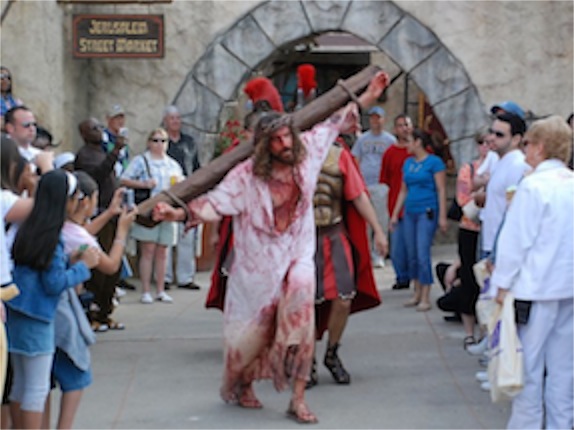
But then, I don’t get theme parks in the first place.
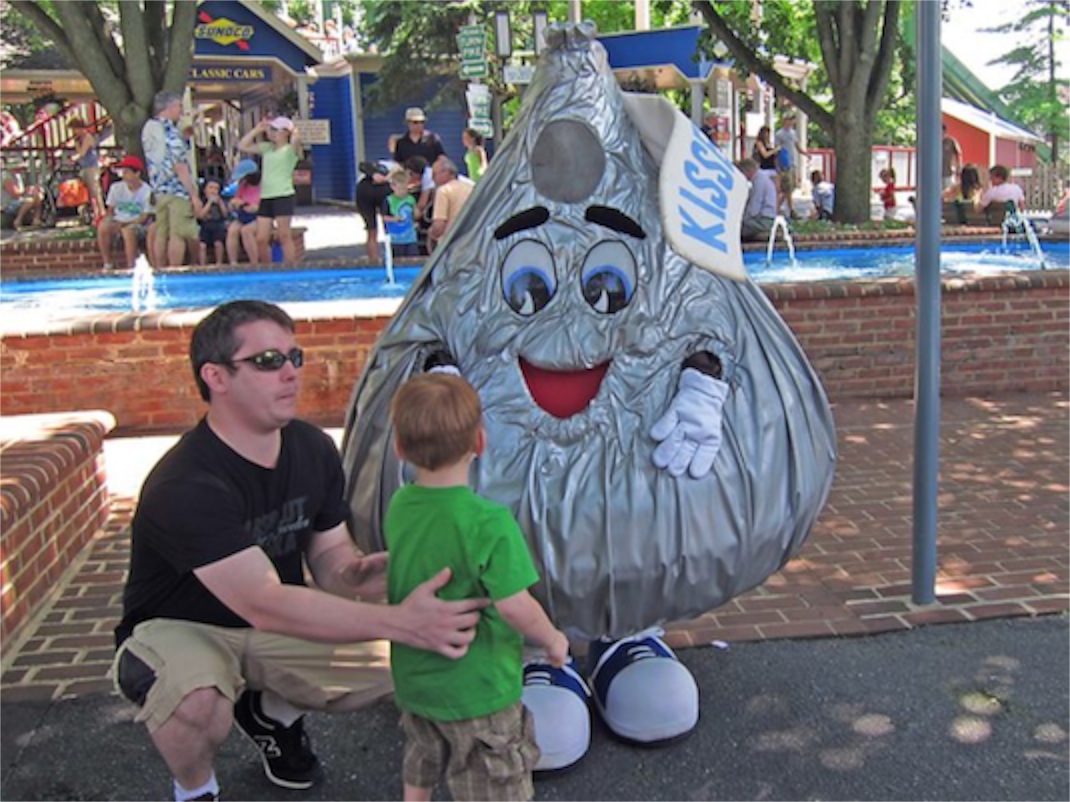
I might make an exception, however, if I go to Pennsylvania. Hershey Park does have a kind of an appeal.
Copyright © 2012 by Ted Huffman. I wrote this. If you want to copy it, please ask for permission. There is a contact me button at the bottom of this page. If you want to share my blog a friend, please direct your friend to my web site.
The Voice of God
29/04/12 05:31
I don’t watch a lot of television, but I have watched the Cecil B. DeMille version of the 10 Commandments on television several times. I know that the movie was filmed in VistaVision and was intended to be watched on the big screen. Back in 1956, movie theatres were larger than the smaller rooms in today’s multiplexes. But somehow, watching it on television gives it a different look. I think that the first time I watched the movie, I was viewing it on the small black and white television set that belonged to a neighbor in our seminary apartment building.
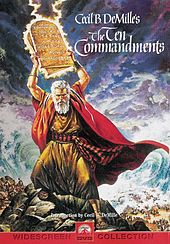 There are some great scenes in the movie. Charlton Heston as Moses, faces off with Yul Brynner as Pharaoh. The movie is over-produced, over-acted and in many ways over the top. It made a lot of money for the producers and was a box office success. But it probably isn’t the best way to teach the fundamental truths of the Bible. Although the exodus is a great narrative story, part of its power lies in the simple fact that our people have preserved it as an oral tradition. Adding visual effects limits the imagination in some ways and attaches a bit too much authority to a single interpretation. The Bible commands us to tell this story every year and such a commandment encourages a fresh examination of the role of the story in our lives. Watching a movie just isn’t the same thing as freshly engaging the stories and traditions of our people in the light of contemporary realities.
There are some great scenes in the movie. Charlton Heston as Moses, faces off with Yul Brynner as Pharaoh. The movie is over-produced, over-acted and in many ways over the top. It made a lot of money for the producers and was a box office success. But it probably isn’t the best way to teach the fundamental truths of the Bible. Although the exodus is a great narrative story, part of its power lies in the simple fact that our people have preserved it as an oral tradition. Adding visual effects limits the imagination in some ways and attaches a bit too much authority to a single interpretation. The Bible commands us to tell this story every year and such a commandment encourages a fresh examination of the role of the story in our lives. Watching a movie just isn’t the same thing as freshly engaging the stories and traditions of our people in the light of contemporary realities.
My favorite scene comes early in the movie. It is the exchange between God and Moses at the burning bush. Visually, the movie doesn’t depict the scene the way I imagine it. In a way, I like the scene from the animated film, Prince of Egypt, better. However, as Moses approaches the bush the voice of God comes from the bush. Although they have done some sound editing, it is pretty clear that the voice of God is Charlton Heston. If you close you eyes (or if you are watching a grainy black and white television set) it is easy to imagine that Heston, playing the part of Moses, is talking to himself.
Actually, that isn’t a bad image for the voice of God. Certainly God is able to speak in any language with any voice. Why not use our own voices to communicate with us? I often experience God as a little voice in my head that sounds suspiciously like my own.
How do you imagine the voice of God sounds?
 I think that a booming bass voice might be a common way to think of God’s voice. Perhaps James Earl Jones would have the right sound. I’m thinking that not many people hear God with a high-pitched voice such as Pee-Wee Herman. Maybe the voice has a bit of gravel like George Burns. Writer Karen Spears Zacharias, author of “A Silence of Mockingbirds: The Memoir of a Murder,” wrote that she thinks that God’s voice might sound a bit like Garrison Keillor, host of “A Prairie Home Companion.” Her father died when she was very young, so she doesn’t remember his voice. She has, however, listened to Keillor on Public Radio for 25 years and his voice seems quite authoritative to her.
I think that a booming bass voice might be a common way to think of God’s voice. Perhaps James Earl Jones would have the right sound. I’m thinking that not many people hear God with a high-pitched voice such as Pee-Wee Herman. Maybe the voice has a bit of gravel like George Burns. Writer Karen Spears Zacharias, author of “A Silence of Mockingbirds: The Memoir of a Murder,” wrote that she thinks that God’s voice might sound a bit like Garrison Keillor, host of “A Prairie Home Companion.” Her father died when she was very young, so she doesn’t remember his voice. She has, however, listened to Keillor on Public Radio for 25 years and his voice seems quite authoritative to her.
That might have worked for me except that once, several years ago, I went to a live performance of Keillor’s radio show, so I have seen what he looks like. It was, frankly, a shock to me. I had known him from radio and I had allowed myself to imagine him much differently than he actually appears. I don’t know, I guess I thought he might be a bit shorter – perhaps a bit like me. Ah well . . .
How about Yoda from Star Wars? The slightly altered word order might be expected from one who knows all of the languages of humans. Again the visual doesn’t work for me. I’ve watched the movies. Yoda doesn’t look at all like the way I imagine God.
When I was younger, not long after my father died, I would regularly hear is voice in my mind. He taught me to fly an airplane, and when I was flying my own plane and running through checklists, I found that I often spoke to myself in his voice. This experience seems to have faded as the decades passed. I no longer have an airplane and I don’t fly as pilot in command any more. And there is also the factor of time. Add to that the simple fact that my own voice isn’t much different from my father’s. It may be another case of hearing my own voice.
 The voice of God is an interesting speculation. I have no doubt that people experience it in many different ways. None of us has a complete understanding of God. I guess I’m not too concerned about how God sounds.
The voice of God is an interesting speculation. I have no doubt that people experience it in many different ways. None of us has a complete understanding of God. I guess I’m not too concerned about how God sounds.
Being a reader, I experience God’s voice through the written word far more often than I experience God as an auditory phenomenon. God speaks in many ways: through dreams, through experiences, through loving actions of others, through traditions, through sacrament and through the written word. I read scripture daily. I study it regularly with colleagues and friends. I read a lot of books that are about the Bible, providing commentary and theological insight. There are a few great authors that I have met face-to-face. There are far more that I have never met and that I will never meet. I know them through the words they have written. While I am certain that God used human hands to write the words of the Bible, I also am convinced that the truth about God comes through these words. I can come to know God better by reading and studying the words.
When I read to myself I suppose that the primary voice is my own, though I often experience it as the voice of the author bringing new ideas to my consciousness.
So I don’t worry much about the sound of God’s voice. After all, it may not be male. In most polls, people cite mothers and grandmothers as their greatest teachers of faith. Now there is a scene that would be worth an other re-making of the epic film. Imagine Charlton Heston approaching the burning bush as Moses, but this time the voice from the bush is his mother . . .

My favorite scene comes early in the movie. It is the exchange between God and Moses at the burning bush. Visually, the movie doesn’t depict the scene the way I imagine it. In a way, I like the scene from the animated film, Prince of Egypt, better. However, as Moses approaches the bush the voice of God comes from the bush. Although they have done some sound editing, it is pretty clear that the voice of God is Charlton Heston. If you close you eyes (or if you are watching a grainy black and white television set) it is easy to imagine that Heston, playing the part of Moses, is talking to himself.
Actually, that isn’t a bad image for the voice of God. Certainly God is able to speak in any language with any voice. Why not use our own voices to communicate with us? I often experience God as a little voice in my head that sounds suspiciously like my own.
How do you imagine the voice of God sounds?

That might have worked for me except that once, several years ago, I went to a live performance of Keillor’s radio show, so I have seen what he looks like. It was, frankly, a shock to me. I had known him from radio and I had allowed myself to imagine him much differently than he actually appears. I don’t know, I guess I thought he might be a bit shorter – perhaps a bit like me. Ah well . . .
How about Yoda from Star Wars? The slightly altered word order might be expected from one who knows all of the languages of humans. Again the visual doesn’t work for me. I’ve watched the movies. Yoda doesn’t look at all like the way I imagine God.
When I was younger, not long after my father died, I would regularly hear is voice in my mind. He taught me to fly an airplane, and when I was flying my own plane and running through checklists, I found that I often spoke to myself in his voice. This experience seems to have faded as the decades passed. I no longer have an airplane and I don’t fly as pilot in command any more. And there is also the factor of time. Add to that the simple fact that my own voice isn’t much different from my father’s. It may be another case of hearing my own voice.

Being a reader, I experience God’s voice through the written word far more often than I experience God as an auditory phenomenon. God speaks in many ways: through dreams, through experiences, through loving actions of others, through traditions, through sacrament and through the written word. I read scripture daily. I study it regularly with colleagues and friends. I read a lot of books that are about the Bible, providing commentary and theological insight. There are a few great authors that I have met face-to-face. There are far more that I have never met and that I will never meet. I know them through the words they have written. While I am certain that God used human hands to write the words of the Bible, I also am convinced that the truth about God comes through these words. I can come to know God better by reading and studying the words.
When I read to myself I suppose that the primary voice is my own, though I often experience it as the voice of the author bringing new ideas to my consciousness.
So I don’t worry much about the sound of God’s voice. After all, it may not be male. In most polls, people cite mothers and grandmothers as their greatest teachers of faith. Now there is a scene that would be worth an other re-making of the epic film. Imagine Charlton Heston approaching the burning bush as Moses, but this time the voice from the bush is his mother . . .
Copyright © 2012 by Ted Huffman. I wrote this. If you want to copy it, please ask for permission. There is a contact me button at the bottom of this page. If you want to share my blog a friend, please direct your friend to my web site.
Emerginig from the Fog
28/04/12 06:10
Yesterday was a wonderful, wet, foggy day in Rapid City. I suppose that you have to be a local to properly appreciate the fog and moist air. Tourists who came to look at Crazy Horse Mountain or Mount Rushmore probably were disappointed in our weather. It’s a frustration to have traveled to see a magnificent mountain carving only to find out that the fog is too thick to see the mountain. Fortunately there are plenty of other things for tourists to do. Perhaps a trip to Hot Springs and a dip in the pool or just a quiet cup of coffee in one of the area shops would be in order. Usually a drive through the game loop in Custer State Park reveals lots of animals very close to the roads on the gray days.
 I’m in a bit of a fog this morning as well, though the skies have cleared. I was up a little before 3 a.m. to do some of my volunteer work with the Pennington County Sheriff. We found a bit of mud and a rather obscure rural address before our adventure was complete for the time being. I’ll be vacuuming the car later this morning. I’ve got a pair of shoes that need to be cleaned up as well. I could accuse the landowner of putting the gate in exactly the wrong place, but suffice it to say that a few loads of gravel would improve that driveway.
I’m in a bit of a fog this morning as well, though the skies have cleared. I was up a little before 3 a.m. to do some of my volunteer work with the Pennington County Sheriff. We found a bit of mud and a rather obscure rural address before our adventure was complete for the time being. I’ll be vacuuming the car later this morning. I’ve got a pair of shoes that need to be cleaned up as well. I could accuse the landowner of putting the gate in exactly the wrong place, but suffice it to say that a few loads of gravel would improve that driveway.
But we never complain about moisture around here. The winter was short and warm and mild and we have been short of moisture. Recent weeks have improved things quite a bit and the hills are finally starting to turn green, but for a while it was alarming to walk through the crackly dry grass in a forest already stressed by the attack of mountain pine beetles. So I am grateful for the rain and the fog even if I did get a little wet yesterday as I was out an about running errands and doing chores.
Fog is interesting because it distorts vision in strange ways. It is a hazard for driving because it can make objects appear to be farther away than they really are. This illusion contributes to a sensation that one is driving slower than the actual speed because it takes longer to reach a seen object than expected.
It takes a surprisingly small amount of moisture to create a fog. When atmospheric conditions are just right, the cloud spreads and hugs the ground and the water droplets suspended in the air are very small. Fortunately for us, and for the plants of the hills, there were many layers of clouds yesterday and clouds that were higher than the ground fog were providing more moisture that fell as rain. At times it rained really hard. At one point yesterday I was driving from the church and noticed how much water was running along the curbs of the streets. I had to go up Mount Rushmore Road in the rain and fortunately remembered to take the left lane. The right lane can have three or four inches of water running down it when it rains.
 Being in a fog is a term that is also used to describe mental confusion or some forms of spiritual disorientation. Just as it is easy to become disoriented and lost when you vision is clouded by fog, it can be confusing and create a feeling of being lost when one loses clarity of understanding or purpose. We all experience moments in our lives when the next steps are uncertain. There is a sense of being lost that comes when we are confused.
Being in a fog is a term that is also used to describe mental confusion or some forms of spiritual disorientation. Just as it is easy to become disoriented and lost when you vision is clouded by fog, it can be confusing and create a feeling of being lost when one loses clarity of understanding or purpose. We all experience moments in our lives when the next steps are uncertain. There is a sense of being lost that comes when we are confused.
But there are also, in this life, moments of clarity of purpose. Just as the fog dissipates when the sun warms the atmosphere, our sense of direction and purpose can become clear when we find ourselves in pursuit of clear and achievable goals.
The issue is not whether or not we will experience times of foggy vision. It is how we react to them. Atmospheric fog, like we experienced yesterday, carries some clues for those times when we feel caught in emotional or spiritual fog. The rule of thumb for driving in fog is simply to slow down. You don’t need to go so fast. When we become confused or spiritually lost, however, our instinct is to speed up. We want to get out of the fog. We charge ahead as if we were able to get out of our “funk” by strength of our action.
 I have had to learn to slow down when I encounter fogginess. A lack of clarity about the future can be an opportunity to develop trust. A moment of confusion can be an invitation to develop inner calm. When we remove the worry from our fogginess, we can discover great beauty. Drops of moisture on a spider web can provide exquisite beauty, but you won’t see them unless you are looking for them. Those who are focused on getting out of the fog often miss beauty that is apparent to others.
I have had to learn to slow down when I encounter fogginess. A lack of clarity about the future can be an opportunity to develop trust. A moment of confusion can be an invitation to develop inner calm. When we remove the worry from our fogginess, we can discover great beauty. Drops of moisture on a spider web can provide exquisite beauty, but you won’t see them unless you are looking for them. Those who are focused on getting out of the fog often miss beauty that is apparent to others.
There are nuggets of beauty in the midst of an emotional fog as well. Sometimes if we just stop and allow ourselves to calm, there is a gift of calm that comes from waiting. Not all of our lives are about us initiating action. Sometimes there is great peace and beauty in waiting for God’s call.
The clouds are dissipating as the sun rises. The remainders of yesterday’s wetness are providing reflection for a beautiful sunrise. I have come through the mud and mess of my nighttime adventures. And I am ready to awaken to the beauty of a new day.
The gift of this new day contains the reminder of another thing about fog. There is nothing we can do to control fog. There are simply forces in nature that are beyond our power and influence. Learning to accept that there will be days of fog is part of developing spiritual maturity. The illusion that we will always clearly comprehend God’s call is just that – an illusion. The truth is that we are almost continually in discernment, wondering, watching and waiting for those rare moments of clarity when God’s call is clear to us. When we develop the maturity to sit with our confusion, God will grant us the gift of emerging clarity.
There are few things in this life more wonderful than watching the sunrise after a foggy day.

But we never complain about moisture around here. The winter was short and warm and mild and we have been short of moisture. Recent weeks have improved things quite a bit and the hills are finally starting to turn green, but for a while it was alarming to walk through the crackly dry grass in a forest already stressed by the attack of mountain pine beetles. So I am grateful for the rain and the fog even if I did get a little wet yesterday as I was out an about running errands and doing chores.
Fog is interesting because it distorts vision in strange ways. It is a hazard for driving because it can make objects appear to be farther away than they really are. This illusion contributes to a sensation that one is driving slower than the actual speed because it takes longer to reach a seen object than expected.
It takes a surprisingly small amount of moisture to create a fog. When atmospheric conditions are just right, the cloud spreads and hugs the ground and the water droplets suspended in the air are very small. Fortunately for us, and for the plants of the hills, there were many layers of clouds yesterday and clouds that were higher than the ground fog were providing more moisture that fell as rain. At times it rained really hard. At one point yesterday I was driving from the church and noticed how much water was running along the curbs of the streets. I had to go up Mount Rushmore Road in the rain and fortunately remembered to take the left lane. The right lane can have three or four inches of water running down it when it rains.

But there are also, in this life, moments of clarity of purpose. Just as the fog dissipates when the sun warms the atmosphere, our sense of direction and purpose can become clear when we find ourselves in pursuit of clear and achievable goals.
The issue is not whether or not we will experience times of foggy vision. It is how we react to them. Atmospheric fog, like we experienced yesterday, carries some clues for those times when we feel caught in emotional or spiritual fog. The rule of thumb for driving in fog is simply to slow down. You don’t need to go so fast. When we become confused or spiritually lost, however, our instinct is to speed up. We want to get out of the fog. We charge ahead as if we were able to get out of our “funk” by strength of our action.

There are nuggets of beauty in the midst of an emotional fog as well. Sometimes if we just stop and allow ourselves to calm, there is a gift of calm that comes from waiting. Not all of our lives are about us initiating action. Sometimes there is great peace and beauty in waiting for God’s call.
The clouds are dissipating as the sun rises. The remainders of yesterday’s wetness are providing reflection for a beautiful sunrise. I have come through the mud and mess of my nighttime adventures. And I am ready to awaken to the beauty of a new day.
The gift of this new day contains the reminder of another thing about fog. There is nothing we can do to control fog. There are simply forces in nature that are beyond our power and influence. Learning to accept that there will be days of fog is part of developing spiritual maturity. The illusion that we will always clearly comprehend God’s call is just that – an illusion. The truth is that we are almost continually in discernment, wondering, watching and waiting for those rare moments of clarity when God’s call is clear to us. When we develop the maturity to sit with our confusion, God will grant us the gift of emerging clarity.
There are few things in this life more wonderful than watching the sunrise after a foggy day.
Copyright © 2012 by Ted Huffman. I wrote this. If you want to copy it, please ask for permission. There is a contact me button at the bottom of this page. If you want to share my blog a friend, please direct your friend to my web site.
Happy Birthday! . . . or not
27/04/12 05:55

Copernicus was a Renaissance man, studying mathematics, astronomy, canon law, medicine and economics. His best-known contribution to modern science is the concept of heliocentrism. Prior to Copernicus, most cosmologists believed that the earth was the center of the universe. Copernicus dared to think, “What if the sun is the center of the universe and the earth one of several bodies that travels around the sun in a circle?” He wasn’t right about the circle, the shape is more of an ellipse. And he wasn’t right about the center of the universe, the universe is much bigger than our solar system and we are hardly at the center of the universe. The idea, however was valid and the question helped the study of astronomy move forward.

Great ideas take more than a single generation to develop. There can be breakthroughs in thinking and brilliant minds can make big contributions, but the understanding of big ideas, such as the nature of the universe, take far longer than the span of an individual life and far more than the thoughts of a single mind to come into reality.
The reason I’m writing about Kepler (well sort of) today is that according to Kepler, today is the birthday of the universe. Best known for his theories about the motion of planets, Kepler is less known for his mathematic work projecting the origin of the universe. As a mathematician he was precise. He concluded that the universe began on April 27, 4977 B.C. If he had been right, the universe would be 6989 years old today. Happy Birthday! It is, however, unlikely that he was right. That’s where Luther comes into the picture. Luther came up with a different date. Based on his study of scripture and earlier theological thinkers, Luther concluded that creation took six literal days about 6000 years ago. Luther’s ideas gave rise to those of other thinkers, just as the ideas of Kepler inspired those who followed. John Calvin shared Luther’s general observations about creation, but criticized the taking of a too literal view of the Bible. Calvin criticized those who asserted that there are “waters above the heavens,” offering a view of the nature of the universe that was more in keeping with contemporary knowledge than the worldview projected by the creation narratives of the Book of Genesis. In 1650 the Archbishop of Armagh, James Ussher, published the Ussher chronology based on Bible history. Ussher gave creation the date of 4004 BC. This has remained as the generally accepted date by most old Earth creationists, who reject the theory of evolution.

It is unlikely that any of the thinkers I’ve discussed was absolutely accurate in the calculation of the exact date of the beginning of the universe. None of them took into account the variations in calendars and the differences in the way that years were counted in different times. None seemed to have wrestled with biblical concepts such as variations in time. Our time is not the same as God’s time. “For a thousand years in thy sight are but as yesterday when it is past, and as a watch in the night.” (Psalm 90:4) Religious thinkers and students of the Bible such as Luther and Ussher must have read that psalm over and over, but somehow it did not seem to strike them that they were using the human perspective on time to measure the time that belongs to God. The difference between a thousand years and eight hours is significant and would influence the accuracy of their counting of Biblical years.
Having said that, I do not believe that the dates projected by contemporary big bang theorists are remotely accurate, either. New discoveries of generations yet unborn will provide different ways of thinking about time and space. New numbers will be touted. That is one of the wonderful things about living in this world: anyone who claims to have the final and definitive answer is most certainly wrong.
“For now we see in a mirror, dimly.” (1 Corinthians 13:12a)
Copyright © 2012 by Ted Huffman. I wrote this. If you want to copy it, please ask for permission. There is a contact me button at the bottom of this page. If you want to share my blog a friend, please direct your friend to my web site.
Seeking the White Whale
26/04/12 05:28
Herman Melville did his homework. His classic novel, certainly one of the Great American Novels, tells its story well. Ishmael, the wandering sailor and Ahab the one-legged captain become captivating characters as we follow the voyage of the Pequod in search of Moby Dick, the white sperm whale. Plenty of teachers and commentators have pointed out the symbolism and metaphor employed by the book. There are plenty of discussions of Melville’s commentary on social status, good and evil and even the existence of God. Like a Shakespeare play, the novel uses stage directions, extended soliloquies and even a few asides. It is a masterful novel and should be read more than once. If you haven’t read it since high school, it is worthy of a re-read.
Here is where Melville got it right. He knew what he was talking about in terms of the life and culture of a nineteenth century sail-powered whaling vessel. He understood the nature of life aboard the ship. That is where he had done his homework and his story carries a mark of authenticity because he accurately describes the dynamics of captain and crew, the daily chores of running a big ship under sail, the process of deploying long boats and the thrill of the hunt.
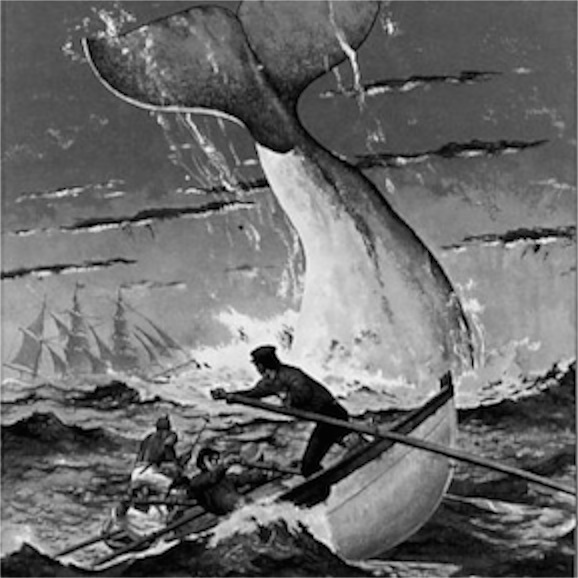 In the novel, Ishmael makes long asides that describe the details of the whaling business. As opposed to previous books that narrated mutinies, Melville seems to be genuinely fascinated by the whaling business. And it was big business in Melville’s time. Like our contemporary oil barons, whalers were in the energy business where demand had outpaced supply and the seller could command high prices. Despite the fact that this is a novel, Melville has captured a fair bit of history accurately. The book has educational value as an illustration of history as well as its literary genius.
In the novel, Ishmael makes long asides that describe the details of the whaling business. As opposed to previous books that narrated mutinies, Melville seems to be genuinely fascinated by the whaling business. And it was big business in Melville’s time. Like our contemporary oil barons, whalers were in the energy business where demand had outpaced supply and the seller could command high prices. Despite the fact that this is a novel, Melville has captured a fair bit of history accurately. The book has educational value as an illustration of history as well as its literary genius.
Melville seems to also have a good understanding of the human psyche. He has an understanding of obsession and compulsion that is especially insightful when you realize that the novel was first published in 1851 before much was known of brain science and the nature of mental illness.
He was also accurate in knowing that a white sperm whale could exist. Contemporary readers don’t know it, but many of Melville’s readers would have known of an article in the May 1839 issue of The Knickerbocker by explorer Jeremiah Reynolds. In that article, Reynolds gives a first-person narration of an encounter with a whale named Mocha Dick. Reynolds described him like this:
“This renowned monster, who had come off victorious in a hundred fights with his pursuers, was an old bull whale, of prodigious size and strength. From the effect of age, or more probably from a freak of nature . . . a singular consequence had resulted – he was white as wool!”
There are numerous accounts of encounters with this particular whale between 1810 and the 1830s. He was described as being covered in barnacles.
Melville is also right in his claim that whales have attacked whale hunters. More likely are accidents in which ships are damaged in accidental collisions with whales, but there are a few documented cases of whaling ships being attacked, holed and sunk by particularly aggressive whales. The Ann Alexander sank off the Galapagos Islands after an encounter with a whale.
But Melville didn’t really understand whales. It is likely that no one in his time had knowledge of whales that was even remotely near to what scientists have discovered in recent decades. Whales were seen as a commodity and thought to be endless in supply. Hunting whales was required by the lifestyles of a growing population with growing demands for nighttime lighting and comfort heating. Although Melville tries to give his character Ahab the task of endowing the whale with human-like characteristics, it doesn’t quite come off. Ahab does interpret the natural instincts of the whale as malignant and evil. In the novel Melville does succeed in illustrating that it is Ahab who possesses the characteristics he tries to assign to the whale. But Melville does not escape anthromorphism himself. He projects human instincts, characteristics and motivations into the whale.
And he describes the whale as aggressive, which is hardly the nature of whales. If they were so, there would be a lot more reports of ships hit and sunk. They are massive animals, capable of doing a lot of damage. But they are also peaceful animals that stick to their pods, nurture their young, and survive as essential partners in the ocean ecosystem. Despite stories that are as old or older than the book of Jonah in the Bible, whales have no desire to eat humans.

Once again this summer the search is on for a white whale. This one isn’t a sperm whale, it is an orca or killer whale. Scientists have seen, photographed and observed what appears to be a healthy adult white orca off the coast of Kamchatka in eastern Russia. Erich Hoyt, a conservationist and author who is a senior research fellow with the Whale and Dolphin Conservation Society, has reported the sightings. Hoyt has previously reported sightings of young white orcas, but this animal has a full two-meter-high dorsal fin. These big fins occur only on mature males meaning that the whale must be at least 16 years old. Orcas mature around the age of 15 and can live as long as 60 years, though 30 is more common.
This whale is living normally with a pod of other orcas with typical coloring. Orcas stay with their mothers as long as their mothers live, so it is assumed that the white whale has siblings and his mother as members of the pod. These whales eat fish and have a complex social structure. A pod usually consists of several families and occasionally pods come together to form much larger clans of whales.
They’ve named the whale “Iceberg” and they hope to observe him a lot more during the coming summer. Unlike Melville’s tale, they don’t anticipate a whale attacking the ship. And they have no intention of flinging a harpoon into the whale in an attempt to end its life.
I don’t intend to re-read Moby Dick this summer. But I will be looking at the Internet in hopes of catching some more video of the white whale.
Here is where Melville got it right. He knew what he was talking about in terms of the life and culture of a nineteenth century sail-powered whaling vessel. He understood the nature of life aboard the ship. That is where he had done his homework and his story carries a mark of authenticity because he accurately describes the dynamics of captain and crew, the daily chores of running a big ship under sail, the process of deploying long boats and the thrill of the hunt.

Melville seems to also have a good understanding of the human psyche. He has an understanding of obsession and compulsion that is especially insightful when you realize that the novel was first published in 1851 before much was known of brain science and the nature of mental illness.
He was also accurate in knowing that a white sperm whale could exist. Contemporary readers don’t know it, but many of Melville’s readers would have known of an article in the May 1839 issue of The Knickerbocker by explorer Jeremiah Reynolds. In that article, Reynolds gives a first-person narration of an encounter with a whale named Mocha Dick. Reynolds described him like this:
“This renowned monster, who had come off victorious in a hundred fights with his pursuers, was an old bull whale, of prodigious size and strength. From the effect of age, or more probably from a freak of nature . . . a singular consequence had resulted – he was white as wool!”
There are numerous accounts of encounters with this particular whale between 1810 and the 1830s. He was described as being covered in barnacles.
Melville is also right in his claim that whales have attacked whale hunters. More likely are accidents in which ships are damaged in accidental collisions with whales, but there are a few documented cases of whaling ships being attacked, holed and sunk by particularly aggressive whales. The Ann Alexander sank off the Galapagos Islands after an encounter with a whale.
But Melville didn’t really understand whales. It is likely that no one in his time had knowledge of whales that was even remotely near to what scientists have discovered in recent decades. Whales were seen as a commodity and thought to be endless in supply. Hunting whales was required by the lifestyles of a growing population with growing demands for nighttime lighting and comfort heating. Although Melville tries to give his character Ahab the task of endowing the whale with human-like characteristics, it doesn’t quite come off. Ahab does interpret the natural instincts of the whale as malignant and evil. In the novel Melville does succeed in illustrating that it is Ahab who possesses the characteristics he tries to assign to the whale. But Melville does not escape anthromorphism himself. He projects human instincts, characteristics and motivations into the whale.
And he describes the whale as aggressive, which is hardly the nature of whales. If they were so, there would be a lot more reports of ships hit and sunk. They are massive animals, capable of doing a lot of damage. But they are also peaceful animals that stick to their pods, nurture their young, and survive as essential partners in the ocean ecosystem. Despite stories that are as old or older than the book of Jonah in the Bible, whales have no desire to eat humans.

Once again this summer the search is on for a white whale. This one isn’t a sperm whale, it is an orca or killer whale. Scientists have seen, photographed and observed what appears to be a healthy adult white orca off the coast of Kamchatka in eastern Russia. Erich Hoyt, a conservationist and author who is a senior research fellow with the Whale and Dolphin Conservation Society, has reported the sightings. Hoyt has previously reported sightings of young white orcas, but this animal has a full two-meter-high dorsal fin. These big fins occur only on mature males meaning that the whale must be at least 16 years old. Orcas mature around the age of 15 and can live as long as 60 years, though 30 is more common.
This whale is living normally with a pod of other orcas with typical coloring. Orcas stay with their mothers as long as their mothers live, so it is assumed that the white whale has siblings and his mother as members of the pod. These whales eat fish and have a complex social structure. A pod usually consists of several families and occasionally pods come together to form much larger clans of whales.
They’ve named the whale “Iceberg” and they hope to observe him a lot more during the coming summer. Unlike Melville’s tale, they don’t anticipate a whale attacking the ship. And they have no intention of flinging a harpoon into the whale in an attempt to end its life.
I don’t intend to re-read Moby Dick this summer. But I will be looking at the Internet in hopes of catching some more video of the white whale.
Copyright © 2012 by Ted Huffman. I wrote this. If you want to copy it, please ask for permission. There is a contact me button at the bottom of this page. If you want to share my blog a friend, please direct your friend to my web site.
Technology and the Gospel
25/04/12 05:35
Like many others, I have a mixed relationship with technology. I love all of the gadgets and have probably spent a larger portion of our family’s resources on computers and phones than would make sense, especially when you consider how quickly the devices become obsolete and are replaced by newer ones. I am pleased that the trend seems to have fallen away from the continual race for faster, bigger and more powerful machines. There is a certain kind of elegance to cloud-based computing that allows one to access information from a variety of different platforms.
 I carry a smartphone and have had such a device since before the term smartphone was coined. I write this blog every day and publishing it is far easier than it was when I began. I still know a bit of raw HTML code, but find that I am using it less and less as software becomes more capable.
I carry a smartphone and have had such a device since before the term smartphone was coined. I write this blog every day and publishing it is far easier than it was when I began. I still know a bit of raw HTML code, but find that I am using it less and less as software becomes more capable.
Our church has Facebook and Twitter accounts in addition to our web site. The Facebook alert feature on my phone posts notifications day and night. When I am awake, I am often surprised at what time of day our members are exploring the web on their computers.
Technology is a part of our lives and it is part of the business of administering a church. We are, after all, in the business of communication. Last week our Gospel message reminded us “that repentance and forgiveness of sins is to be proclaimed in Jesus name to all nations.” (Luke 24:48) That is our business. How we make that proclamation is not spelled out, but for generations faithful Christians have used whatever media were available.
In the church, we have two communications tasks that often overlap. We are called to communicate our message to those outside of the church, welcoming them to join our fellowship. We are also called to communicate with those who are already part of the church, informing them of the mission and ministry of the congregation and how they can become more involved.
Communications, however, is not the same thing as public relations. We do not have a product to “sell.” We cannot measure the success of the church with statistics and numbers. Google analytics does not have a chart for faithfulness. Long before there were any computers or even printing presses, Jesus prayed for his followers that they might see themselves as being in the world but not fully conforming to the ways of the world. (John 17:14-17) We struggle with this paradox every day. We are a part of this world. We use the tools of this world. We work for peace and justice in this world. We await the coming of God’s realm to this world. But we do not owe our allegiances to the ways of this world. We belong to God and God alone.
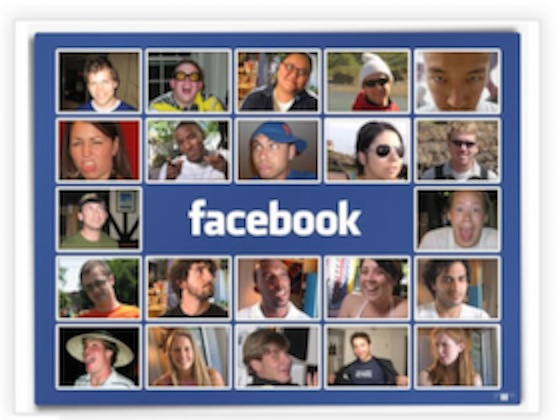 I suspect that our congregation is like many other churches in our struggle to discover appropriate ways to use technology. When I was studying for the ministry, I never imagined that I would carry my Bible as an application on my phone. I couldn’t envision that we would be migrating from a printed newsletter to an online document. I certainly had no idea how much of my job would take place at the keyboard of a computer. Computers are greedy machines. They can use up as much time as we put into them.
I suspect that our congregation is like many other churches in our struggle to discover appropriate ways to use technology. When I was studying for the ministry, I never imagined that I would carry my Bible as an application on my phone. I couldn’t envision that we would be migrating from a printed newsletter to an online document. I certainly had no idea how much of my job would take place at the keyboard of a computer. Computers are greedy machines. They can use up as much time as we put into them.
However, I am reminded every day that the real business of the church is relationship and that computers are simply one method of pursuing relationships. A simple story from yesterday serves as an illustration. When I checked my e-mail in the morning there was a note from a colleague in another part of the state asking me to stop in for a visit to a person in the hospital. I was asked to convey the prayers and wishes of my colleague to the patient. Early in the afternoon, I walked into the surgical intensive care unit at the hospital and greeted the patient. It was obvious that he was deeply touched by my colleague’s thoughtfulness. His healing was aided by the knowledge of the love and prayers that surround him. The computer wasn’t the tool of healing. Actually, neither was I. Together with the computer, I had the role of communicating a message that came from somewhere else. In this particular case, the technology aided ministry. Within a few minutes of returning to my office, I had reported back to my colleague and sent an additional message to make sure that the patient will be visited on the days when I do not go to the hospital.
Still, the technology is a struggle. In the afternoon, we had a productive meeting during which a lay leader of our congregation suggested ways in which we can share some of the responsibilities for our computer-based communications. The ideas were very helpful and the meeting was productive. But I worry about us getting too caught up in our computers. I remember visiting a college dorm room recently to offer a ride to a student. The student said he had to finish one e-mail message and then he would be ready. I waited. As we walked down the hallway, I casually asked whom he was writing to. The answer: his roommate. The roommate had been in the room. They were sitting in the same room, facing opposite directions at screens and sending electronic messages instead of talking to one another. In the church, we need to avoid using technology where personal contact will work.
I have jokingly threatened to send a twitter message right at the beginning of a prayer or sermon just to see who in the congregation vibrates and how they respond.
 Years ago Marshall McLuhan coined the phrase, “The medium is the message.” He explored the relationship between what is said and how it is said. How we say things influences how our message is received. It is important that those of us in the business of communication pay attention to all of the different media for communicating. It is important that I keep up with the technology.
Years ago Marshall McLuhan coined the phrase, “The medium is the message.” He explored the relationship between what is said and how it is said. How we say things influences how our message is received. It is important that those of us in the business of communication pay attention to all of the different media for communicating. It is important that I keep up with the technology.
Still, I turn my phone off during worship. I recommend that others do the same. God’s message is not dependent upon the technology. The still-speaking God can get the message through. We need to make sure that we are listening.

Our church has Facebook and Twitter accounts in addition to our web site. The Facebook alert feature on my phone posts notifications day and night. When I am awake, I am often surprised at what time of day our members are exploring the web on their computers.
Technology is a part of our lives and it is part of the business of administering a church. We are, after all, in the business of communication. Last week our Gospel message reminded us “that repentance and forgiveness of sins is to be proclaimed in Jesus name to all nations.” (Luke 24:48) That is our business. How we make that proclamation is not spelled out, but for generations faithful Christians have used whatever media were available.
In the church, we have two communications tasks that often overlap. We are called to communicate our message to those outside of the church, welcoming them to join our fellowship. We are also called to communicate with those who are already part of the church, informing them of the mission and ministry of the congregation and how they can become more involved.
Communications, however, is not the same thing as public relations. We do not have a product to “sell.” We cannot measure the success of the church with statistics and numbers. Google analytics does not have a chart for faithfulness. Long before there were any computers or even printing presses, Jesus prayed for his followers that they might see themselves as being in the world but not fully conforming to the ways of the world. (John 17:14-17) We struggle with this paradox every day. We are a part of this world. We use the tools of this world. We work for peace and justice in this world. We await the coming of God’s realm to this world. But we do not owe our allegiances to the ways of this world. We belong to God and God alone.

However, I am reminded every day that the real business of the church is relationship and that computers are simply one method of pursuing relationships. A simple story from yesterday serves as an illustration. When I checked my e-mail in the morning there was a note from a colleague in another part of the state asking me to stop in for a visit to a person in the hospital. I was asked to convey the prayers and wishes of my colleague to the patient. Early in the afternoon, I walked into the surgical intensive care unit at the hospital and greeted the patient. It was obvious that he was deeply touched by my colleague’s thoughtfulness. His healing was aided by the knowledge of the love and prayers that surround him. The computer wasn’t the tool of healing. Actually, neither was I. Together with the computer, I had the role of communicating a message that came from somewhere else. In this particular case, the technology aided ministry. Within a few minutes of returning to my office, I had reported back to my colleague and sent an additional message to make sure that the patient will be visited on the days when I do not go to the hospital.
Still, the technology is a struggle. In the afternoon, we had a productive meeting during which a lay leader of our congregation suggested ways in which we can share some of the responsibilities for our computer-based communications. The ideas were very helpful and the meeting was productive. But I worry about us getting too caught up in our computers. I remember visiting a college dorm room recently to offer a ride to a student. The student said he had to finish one e-mail message and then he would be ready. I waited. As we walked down the hallway, I casually asked whom he was writing to. The answer: his roommate. The roommate had been in the room. They were sitting in the same room, facing opposite directions at screens and sending electronic messages instead of talking to one another. In the church, we need to avoid using technology where personal contact will work.
I have jokingly threatened to send a twitter message right at the beginning of a prayer or sermon just to see who in the congregation vibrates and how they respond.

Still, I turn my phone off during worship. I recommend that others do the same. God’s message is not dependent upon the technology. The still-speaking God can get the message through. We need to make sure that we are listening.
Copyright © 2012 by Ted Huffman. I wrote this. If you want to copy it, please ask for permission. There is a contact me button at the bottom of this page. If you want to share my blog a friend, please direct your friend to my web site.
The life of a boat
24/04/12 05:01
The Cutty Sark was designed to be a state-of-the-art Clipper ship by Hercules Linton. She was designed specifically to outsail the clipper Thermopylae. They chose a brand new company to construct her. Scott & Linton had been in business less than one year when they penned the contract for construction. They promised to launch the boat within 6 months. It was a big job for a small firm and they were not equal to the task. Payment was to be made in seven installments as the ship was completed with penalties assessed for delays. The company ran out of money to keep working and a second firm, Denny’s completed the work. The ship was launched nine months after construction started and it took another month to have her masts lifted and running rigging installed. She was of composite construction: a wooden hull on an iron frame.
 From that point, it is history. The last merchant clipper at the end of the era of sail, Cutty Sark was fast and capable. Built in 1869, she was designed for a service life of 25 years in the wool trade. After her life as a merchant vessel, she served as a training ship until she was put on public display in Grteenwich, London, in 1954 where she has served as a window on the golden days of fast clipper ships ever since.
From that point, it is history. The last merchant clipper at the end of the era of sail, Cutty Sark was fast and capable. Built in 1869, she was designed for a service life of 25 years in the wool trade. After her life as a merchant vessel, she served as a training ship until she was put on public display in Grteenwich, London, in 1954 where she has served as a window on the golden days of fast clipper ships ever since.
In May of 2007, a faulty motor on a dust extractor caused a fire that burned through all three decks of the ship and charred her timbers. It was initially thought that the ship might be a total loss. However, this week the ship will once again open to the public in time for the Summer Olympics and the Queen’s diamond jubilee. The Queen herself will cut the ribbon on the new display.
 You have to love history to undertake such a project. The restoration following the fire cost over 50 million British pounds ($80.8 million). That’s a lot of money for a ship that cost 16,500 pounds ($26,652) for her original construction.
You have to love history to undertake such a project. The restoration following the fire cost over 50 million British pounds ($80.8 million). That’s a lot of money for a ship that cost 16,500 pounds ($26,652) for her original construction.
I have no idea whether or not I will get to London again. But if I do, a visit to the Cutty Sark will definitely be on my list things to do. I have mixed feelings about how the restoration has been done. I am grateful that she has been preserved. I am an amateur boat builder and I love seeing how various boats have been built. I enjoy touring ships and looking at their details. However, it is now impossible to see the whole ship in the water as she was intended to be seen. First of all, she isn’t in the water any more. She is suspended by a series of giant beams 3 meters above a lower observation deck. Then she is surrounded by a greenhouse of smoked glass providing a climate-controlled viewing area. The result is comfort. The viewing area is air conditioned – as is the entire ship. In my opinion, the air conditioning detracts from the experience. Clipper ships were hot and cramped and noisy below decks. Their stairways were narrow and difficult to negotiate. The restored Cutty Sark has three glass elevators to take viewers to the various levels in comfort.
So they have made here into a tourist attraction instead of the queen of the oceans that she once was. No worries, when in London I’m a tourist. And I guess it might be interesting to walk under the ship and view the keel. It is a sort of fish’s viewpoint, I guess. If you can’t see the sharp bow parting the water, at least you can examine the undersides.
I didn’t contribute to the Cutty Sark restoration. I thought from the time they started that the plays were a bit extravagant. I didn’t like the idea of elevators and air conditioning. I think the greenhouse looks ridiculous. But I have contributed to restorations and re-creations of historic ships in the past. I contributed to the Amistad Project. I have made a small gift to the restoration of the Charles W. Morgan, the last wooden whaleship in the world. Both the Amistad and the Morgan are projects of Mystic Seaport. At Mystic Seaport they restore and recreate historic ships to be put into the water and they have a commitment to using the vessels as training ships so that generations of young people can experience the teamwork and skills of sailing. The Morgan will be heading to sea in 2014 on a voyage of teaching and living history. The Cutty Sark will never again touch the ocean.
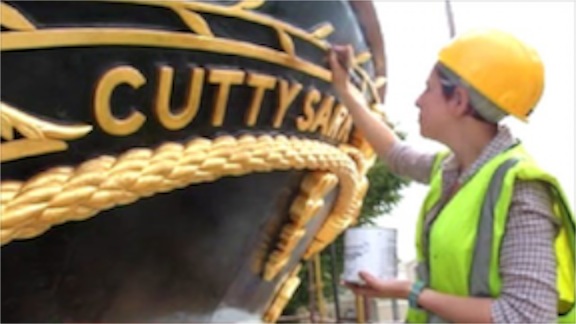 Boats are intended to be in the water. Having said that, the Cutty Sark had a long service life that outlasted the expectations of her builders. Ships in those days served for about 25 years and then were scrapped. They had to earn their keep in a few years. The elements took their toil. More importantly, technology was advancing so quickly that newer and faster ships came along to replace the old ones. In order to remain profitable, shipping companies had to keep investing in new ships.
Boats are intended to be in the water. Having said that, the Cutty Sark had a long service life that outlasted the expectations of her builders. Ships in those days served for about 25 years and then were scrapped. They had to earn their keep in a few years. The elements took their toil. More importantly, technology was advancing so quickly that newer and faster ships came along to replace the old ones. In order to remain profitable, shipping companies had to keep investing in new ships.
My scale is smaller and my timeline is slower. I build boats for my own enjoyment. Given my age, a service life of 25 years is sufficient, though most of the boats I build will be good for a couple of generations if they are properly maintained. As much as I enjoy building them, I enjoy paddling and rowing even more. So yesterday, after spending a little time on the construction of a rowboat in my garage, I headed to the lake with a little kayak and went to visit the beavers. They were at home, which meant that they weren’t out on the water. A turtle swam by to greet me. The birds danced in the air. The sky was blue and the day was perfect for a paddle.
 The queen will be on hand for the ribbon cutting of the Cutty Sark. I have never had royalty present for the launching of one of my boats. But yesterday as I paddled my tiny boat, I felt like a king. No royal has ever had it any better.
The queen will be on hand for the ribbon cutting of the Cutty Sark. I have never had royalty present for the launching of one of my boats. But yesterday as I paddled my tiny boat, I felt like a king. No royal has ever had it any better.

In May of 2007, a faulty motor on a dust extractor caused a fire that burned through all three decks of the ship and charred her timbers. It was initially thought that the ship might be a total loss. However, this week the ship will once again open to the public in time for the Summer Olympics and the Queen’s diamond jubilee. The Queen herself will cut the ribbon on the new display.

I have no idea whether or not I will get to London again. But if I do, a visit to the Cutty Sark will definitely be on my list things to do. I have mixed feelings about how the restoration has been done. I am grateful that she has been preserved. I am an amateur boat builder and I love seeing how various boats have been built. I enjoy touring ships and looking at their details. However, it is now impossible to see the whole ship in the water as she was intended to be seen. First of all, she isn’t in the water any more. She is suspended by a series of giant beams 3 meters above a lower observation deck. Then she is surrounded by a greenhouse of smoked glass providing a climate-controlled viewing area. The result is comfort. The viewing area is air conditioned – as is the entire ship. In my opinion, the air conditioning detracts from the experience. Clipper ships were hot and cramped and noisy below decks. Their stairways were narrow and difficult to negotiate. The restored Cutty Sark has three glass elevators to take viewers to the various levels in comfort.
So they have made here into a tourist attraction instead of the queen of the oceans that she once was. No worries, when in London I’m a tourist. And I guess it might be interesting to walk under the ship and view the keel. It is a sort of fish’s viewpoint, I guess. If you can’t see the sharp bow parting the water, at least you can examine the undersides.
I didn’t contribute to the Cutty Sark restoration. I thought from the time they started that the plays were a bit extravagant. I didn’t like the idea of elevators and air conditioning. I think the greenhouse looks ridiculous. But I have contributed to restorations and re-creations of historic ships in the past. I contributed to the Amistad Project. I have made a small gift to the restoration of the Charles W. Morgan, the last wooden whaleship in the world. Both the Amistad and the Morgan are projects of Mystic Seaport. At Mystic Seaport they restore and recreate historic ships to be put into the water and they have a commitment to using the vessels as training ships so that generations of young people can experience the teamwork and skills of sailing. The Morgan will be heading to sea in 2014 on a voyage of teaching and living history. The Cutty Sark will never again touch the ocean.

My scale is smaller and my timeline is slower. I build boats for my own enjoyment. Given my age, a service life of 25 years is sufficient, though most of the boats I build will be good for a couple of generations if they are properly maintained. As much as I enjoy building them, I enjoy paddling and rowing even more. So yesterday, after spending a little time on the construction of a rowboat in my garage, I headed to the lake with a little kayak and went to visit the beavers. They were at home, which meant that they weren’t out on the water. A turtle swam by to greet me. The birds danced in the air. The sky was blue and the day was perfect for a paddle.

Copyright © 2012 by Ted Huffman. I wrote this. If you want to copy it, please ask for permission. There is a contact me button at the bottom of this page. If you want to share my blog a friend, please direct your friend to my web site.
Happy Birthday Shakespeare
23/04/12 05:37
Today is the traditional date for the birth of William Shakespeare. The actual date of his birth is not known, but church records show that he was baptized on April 26, 1564. In those days in that region it was typical for children to be presented for baptism 3 days after their birth. History does conclusively reveal that April 23 was the date of Shakespeare’s death. He died in 1616. He was 52 years old and retired to Stratford three years before.

Details about Shakespeare’s life are few and sketchy. He was not a noble and in England at that time that meant that the details of his life were not recorded. He was the son of John Shakespeare, a leather trader and the town bailiff. After his baptism, the next official record is of his marriage to Anne Hathaway at age 18. She was eight years his senior and their first daughter, Susannna, was born six months later. You do the math. It was as common in those days as it is today.
It is likely that he attended grammar school in Stratford. If so he would have studied Latin and read classical literature. He did not go to university.
The first record of Shakespeare as a playwright came in 1592. It was a decade after his marriage and the reference is a bad review by Robert Greene. Green died shortly after writing his derogatory comments. It is believed that Shakespeare had written Henry VI by that point. The next year, in 1593, Venus and Adonis was the first of his poems to be published. By 1594 he was a part of the Lord Chamberlain’s Men, a company of actors that grew to become England’s finest and most famous. They became the Kings’ Men when James I ascended to the throne in 1603. Richard III, The Comedy of Errors, The Taming of the Shrew, Romeo and Juliet and A Midsummer Night’s Dream were all produced before 1599. That was the year that Shakespeare became a part owner of the Globe Theatre.
Today, Shakespeare’s plays are performed more often and in more nations than ever before. His popularity continues to grow nearly 400 years after his death. His plays and sonnets have been translated into most of the world’s languages. This year’s World Shakespeare Festival will feature 70 productions of the Bard’s plays translated into languages from all over the world.
In Eastern Europe the plays are associated with freedom. Before the fall of the Soviet Union, actors inserted messages of freedom into the plays in many countries. Lithuanian rockstar Andrius Mamontovas has been playing Hamlet for 15 years. In Armenia, Shakespeare is becoming a common first name for boys. There is a sort of hero worship of the playwright. In South Sudan, Zimbabwe, and other African countries, Shakespeare has been translated into Shona, Arabic, and many other languages.
Shakespeare lived in pivotal times. The Protestant Reformation was in full swing. Luther’s 95 theses, written in 1517, are often cited as the beginning of the Reformation. Although the Bible had been translated into English earlier, the King James Version was produced during Shakespeare’s life. The translation was begun in 1604 and completed in 1611. Although the translator’s work was compromised by the royal order that the new version would conform to the ecclesiology and Episcopal structure of the Church of England, it is in common use to this day. It is commonly cited alongside the works of Shakespeare as major contributors to the standardization of written English.
Think of this. Shakespeare composed all of his sonnets and plays without the aid of a dictionary. Although wordlists, glossaries and lexicons existed, there was nothing similar to a modern dictionary produced by the time that Shakespeare did his work. During his life, Robert Cawdrey published his Table Alphabeticall in 1604. Note that spelling had not yet been standardized. The world would have to wait another 149 years before Samuel Johnson’s work became the standard of English Language dictionaries with categories and expressions as well as single worlds.
The spirit of Reformation that was sweeping the church was reflected in social structures and governments as well. Although Shakespeare did not live to see the American Revolution, the concepts that underlie modern democracies were being formed during his life. Some of those concepts are expressed in his plays, thus explaining the contemporary popularity of the plays in countries where democracy is still emerging.
Johannes Gutenberg had invented his moveable type printing press in 1439, long before the time of Shakespeare, but it took a long time for the effects of that invention to unfold. The world was in the midst of a huge transition of literacy. For thousands of years oral language was the standard of communication. Things that were written were deemed to be less trustworthy because of the commonness of errors in hand-copying documents. The press made it possible for consistency in written documents. Shakespeare did his work at the intersection of those two approaches to language. He produced written language intended for oral communication. His sonnets cry to be read out loud. His plays can be boring to read. It is only when they are acted that they come alive. The printed words demand an oral presentation.
 Whether or not we are aware of it, our ideas are deeply influenced by the works of Shakespeare. His plays have been the standard of high school English for all of our lives. Our parents and grandparents studied Shakespeare. It is likely that our grandchildren will study his works as well.
Whether or not we are aware of it, our ideas are deeply influenced by the works of Shakespeare. His plays have been the standard of high school English for all of our lives. Our parents and grandparents studied Shakespeare. It is likely that our grandchildren will study his works as well.
Wikipedia lists 410 feature-length film and TV versions of Shakespeare’s plays. According to that source William Shakespeare is the most filmed author ever in any language. There have been significant adaptations in television and movies, of course. Who can forget the 1979 Canadian classic Romie-O and Julie-8? OK, who can remember it?
It is impossible to know what Shakespeare might have thought had he known that he would achieve such popularity so long after his death. It is likely that he would have been a bit more careful in his writing. Perhaps he would have held back a little, fearing that the impact would be far different than the intention. Who knows? Such is the fate of publication. It is the fate of all art. Once it is released, the interpretation cannot be controlled.
So we wish a happy birthday to William Shakespeare. His impact continues to spread throughout the world. And, for those of us who come after him, there is no problem deciding whether to acknowledge him on the day of his birth or the day of his death. April 23 seems to work all around.

Details about Shakespeare’s life are few and sketchy. He was not a noble and in England at that time that meant that the details of his life were not recorded. He was the son of John Shakespeare, a leather trader and the town bailiff. After his baptism, the next official record is of his marriage to Anne Hathaway at age 18. She was eight years his senior and their first daughter, Susannna, was born six months later. You do the math. It was as common in those days as it is today.
It is likely that he attended grammar school in Stratford. If so he would have studied Latin and read classical literature. He did not go to university.
The first record of Shakespeare as a playwright came in 1592. It was a decade after his marriage and the reference is a bad review by Robert Greene. Green died shortly after writing his derogatory comments. It is believed that Shakespeare had written Henry VI by that point. The next year, in 1593, Venus and Adonis was the first of his poems to be published. By 1594 he was a part of the Lord Chamberlain’s Men, a company of actors that grew to become England’s finest and most famous. They became the Kings’ Men when James I ascended to the throne in 1603. Richard III, The Comedy of Errors, The Taming of the Shrew, Romeo and Juliet and A Midsummer Night’s Dream were all produced before 1599. That was the year that Shakespeare became a part owner of the Globe Theatre.
Today, Shakespeare’s plays are performed more often and in more nations than ever before. His popularity continues to grow nearly 400 years after his death. His plays and sonnets have been translated into most of the world’s languages. This year’s World Shakespeare Festival will feature 70 productions of the Bard’s plays translated into languages from all over the world.
In Eastern Europe the plays are associated with freedom. Before the fall of the Soviet Union, actors inserted messages of freedom into the plays in many countries. Lithuanian rockstar Andrius Mamontovas has been playing Hamlet for 15 years. In Armenia, Shakespeare is becoming a common first name for boys. There is a sort of hero worship of the playwright. In South Sudan, Zimbabwe, and other African countries, Shakespeare has been translated into Shona, Arabic, and many other languages.
Shakespeare lived in pivotal times. The Protestant Reformation was in full swing. Luther’s 95 theses, written in 1517, are often cited as the beginning of the Reformation. Although the Bible had been translated into English earlier, the King James Version was produced during Shakespeare’s life. The translation was begun in 1604 and completed in 1611. Although the translator’s work was compromised by the royal order that the new version would conform to the ecclesiology and Episcopal structure of the Church of England, it is in common use to this day. It is commonly cited alongside the works of Shakespeare as major contributors to the standardization of written English.
Think of this. Shakespeare composed all of his sonnets and plays without the aid of a dictionary. Although wordlists, glossaries and lexicons existed, there was nothing similar to a modern dictionary produced by the time that Shakespeare did his work. During his life, Robert Cawdrey published his Table Alphabeticall in 1604. Note that spelling had not yet been standardized. The world would have to wait another 149 years before Samuel Johnson’s work became the standard of English Language dictionaries with categories and expressions as well as single worlds.
The spirit of Reformation that was sweeping the church was reflected in social structures and governments as well. Although Shakespeare did not live to see the American Revolution, the concepts that underlie modern democracies were being formed during his life. Some of those concepts are expressed in his plays, thus explaining the contemporary popularity of the plays in countries where democracy is still emerging.
Johannes Gutenberg had invented his moveable type printing press in 1439, long before the time of Shakespeare, but it took a long time for the effects of that invention to unfold. The world was in the midst of a huge transition of literacy. For thousands of years oral language was the standard of communication. Things that were written were deemed to be less trustworthy because of the commonness of errors in hand-copying documents. The press made it possible for consistency in written documents. Shakespeare did his work at the intersection of those two approaches to language. He produced written language intended for oral communication. His sonnets cry to be read out loud. His plays can be boring to read. It is only when they are acted that they come alive. The printed words demand an oral presentation.

Wikipedia lists 410 feature-length film and TV versions of Shakespeare’s plays. According to that source William Shakespeare is the most filmed author ever in any language. There have been significant adaptations in television and movies, of course. Who can forget the 1979 Canadian classic Romie-O and Julie-8? OK, who can remember it?
It is impossible to know what Shakespeare might have thought had he known that he would achieve such popularity so long after his death. It is likely that he would have been a bit more careful in his writing. Perhaps he would have held back a little, fearing that the impact would be far different than the intention. Who knows? Such is the fate of publication. It is the fate of all art. Once it is released, the interpretation cannot be controlled.
So we wish a happy birthday to William Shakespeare. His impact continues to spread throughout the world. And, for those of us who come after him, there is no problem deciding whether to acknowledge him on the day of his birth or the day of his death. April 23 seems to work all around.
Copyright © 2012 by Ted Huffman. I wrote this. If you want to copy it, please ask for permission. There is a contact me button at the bottom of this page. If you want to share my blog a friend, please direct your friend to my web site.
Seeking Balance
22/04/12 05:11
For most of my life, I have lived in rural areas – or at least in places that had easy access to places where there are fewer people. When we lived in Chicago we found our way to the arboretum, parks and other open areas. And, of course, Chicago has the lakefront that gives its residents a place to go to look out at the natural world. My life involves lots of contact with people and I love working with people, but I also find the need to achieve balance. So I seek the wild places where I can be by myself from time to time.
Many of the indigenous tribes of North America had traditions of young men going off by themselves in search of a vision. The Bible reports that Moses, Elijah and Jesus all had times of going off into the wilderness to discern God’s call. The traditions of our people are filled with stories of rich and meaningful encounters with God in nature. Some writers refer to two scriptures: one written, the other displayed in nature.
For me, as I said, it is about balance. I have as deep a need of the community as I have for times of being alone. Both are important in my personal life and in the life of the community. We come together and we have times apart. There is a rhythm and balance to our activities.
 Yesterday, I had a couple of hours for some alone time. The Mickelson Trail isn’t very busy this time of the year, and I had it all to myself out by Mystic. It is a good place to ride a bicycle. The former railroad bed has no grades of more than 4%, so it isn’t too steep and the bridges and tunnels are all well maintained. A little exercise is good for the body, fresh air is good for the spirit, and the quietness of the hills is good for the soul. It was a little windy yesterday, but life needs a few challenges.
Yesterday, I had a couple of hours for some alone time. The Mickelson Trail isn’t very busy this time of the year, and I had it all to myself out by Mystic. It is a good place to ride a bicycle. The former railroad bed has no grades of more than 4%, so it isn’t too steep and the bridges and tunnels are all well maintained. A little exercise is good for the body, fresh air is good for the spirit, and the quietness of the hills is good for the soul. It was a little windy yesterday, but life needs a few challenges.
 The beaver has been busy this year. The lodge is refurbished and there are fresh branches in the dam. I paused for a while to see if I could get a glimpse of the creature, but he preferred to remain hidden while I was in the area. Perhaps I arrived at naptime. Perhaps he just didn’t want to show himself to me. I had time to take a look at what he’s been working on before getting on my bike and riding on.
The beaver has been busy this year. The lodge is refurbished and there are fresh branches in the dam. I paused for a while to see if I could get a glimpse of the creature, but he preferred to remain hidden while I was in the area. Perhaps I arrived at naptime. Perhaps he just didn’t want to show himself to me. I had time to take a look at what he’s been working on before getting on my bike and riding on.
Sometimes I take my access to the natural world for granted. I don’t realize the challenges that exist for most of the people in the world who live in cities. Our population is concentrated into the urban areas. People get used to living in close proximity to one another and many have to make a major effort to get out into the natural world. The ability to just go for a walk in the hills whenever I want is a luxury that most of the people of this world do not have. I get great joy from having other creatures as neighbors. I like to watch the deer and turkeys in my yard and I know how to find big horn sheep, elk and other creatures to show when visitors come to us. Like all neighbors, I sometimes have my complaints. I wish the turkeys were a little less messy. I worry about the deer on the road and grieve when a car hits one. But I know that living in a place where I am surrounded by other creatures is a blessing and a treat that is denied to many of the other people in the world. There are, of course, animals who have adapted to life in the city, but I prefer deer and turkeys to rats and cockroaches.
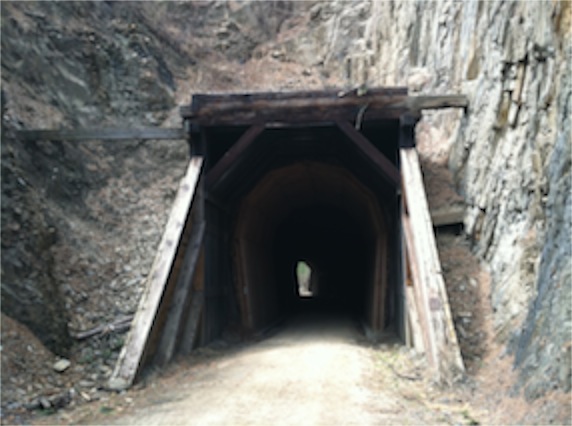 All of this is to say that I have appreciation for those people who tell me that they find God in nature. I do too. I understand how someone can want to spend their day off going into the hills to see the beauty of the skies, trees and water. I understand how watching wild animals can raise one’s spirits.
All of this is to say that I have appreciation for those people who tell me that they find God in nature. I do too. I understand how someone can want to spend their day off going into the hills to see the beauty of the skies, trees and water. I understand how watching wild animals can raise one’s spirits.
I don’t understand cutting oneself off from the community of believers. I know that there are a lot of people who don’t feel the same need that I do for regular worship with other people. I have a deep sense that one cannot be the “body of Christ” alone. I have a hunger for the traditional words and songs that express our faith. I enjoy liturgy and ritual. My attraction for such may be greater than others experience. But I feel like my life would be empty without regular gatherings for worship. Going into nature alone would not satisfy my spiritual needs.
The great leaders of our spiritual tradition saw themselves as belonging to the people. They served the people and sacrificed for the people. They understood that we do not live to ourselves alone. In addition to our connections with others who share the same time with us, we belong to a long line of history. My one life on this earth is such a small fraction of the larger story to which I belong. I can be reminded of this by studying the stories of our people. But nature itself will occasionally remind me of my place in the universe. It doesn’t take too long a time of gazing up into the night sky to discover how small I am in the grand scheme of the universe. If I have inflated notions of my own power or abilities, a hike up a steep mountain will humble me. If I think I can survive in harsh times, a blast of cold wind accompanied by snow or rain will remind me of how vulnerable I really am.
So, with deep gratitude for the beauty of the natural world, I head for church to experience the beauty of other people and the beauty of our story.
Life is enhanced when we achieve balance.
Many of the indigenous tribes of North America had traditions of young men going off by themselves in search of a vision. The Bible reports that Moses, Elijah and Jesus all had times of going off into the wilderness to discern God’s call. The traditions of our people are filled with stories of rich and meaningful encounters with God in nature. Some writers refer to two scriptures: one written, the other displayed in nature.
For me, as I said, it is about balance. I have as deep a need of the community as I have for times of being alone. Both are important in my personal life and in the life of the community. We come together and we have times apart. There is a rhythm and balance to our activities.


Sometimes I take my access to the natural world for granted. I don’t realize the challenges that exist for most of the people in the world who live in cities. Our population is concentrated into the urban areas. People get used to living in close proximity to one another and many have to make a major effort to get out into the natural world. The ability to just go for a walk in the hills whenever I want is a luxury that most of the people of this world do not have. I get great joy from having other creatures as neighbors. I like to watch the deer and turkeys in my yard and I know how to find big horn sheep, elk and other creatures to show when visitors come to us. Like all neighbors, I sometimes have my complaints. I wish the turkeys were a little less messy. I worry about the deer on the road and grieve when a car hits one. But I know that living in a place where I am surrounded by other creatures is a blessing and a treat that is denied to many of the other people in the world. There are, of course, animals who have adapted to life in the city, but I prefer deer and turkeys to rats and cockroaches.

I don’t understand cutting oneself off from the community of believers. I know that there are a lot of people who don’t feel the same need that I do for regular worship with other people. I have a deep sense that one cannot be the “body of Christ” alone. I have a hunger for the traditional words and songs that express our faith. I enjoy liturgy and ritual. My attraction for such may be greater than others experience. But I feel like my life would be empty without regular gatherings for worship. Going into nature alone would not satisfy my spiritual needs.
The great leaders of our spiritual tradition saw themselves as belonging to the people. They served the people and sacrificed for the people. They understood that we do not live to ourselves alone. In addition to our connections with others who share the same time with us, we belong to a long line of history. My one life on this earth is such a small fraction of the larger story to which I belong. I can be reminded of this by studying the stories of our people. But nature itself will occasionally remind me of my place in the universe. It doesn’t take too long a time of gazing up into the night sky to discover how small I am in the grand scheme of the universe. If I have inflated notions of my own power or abilities, a hike up a steep mountain will humble me. If I think I can survive in harsh times, a blast of cold wind accompanied by snow or rain will remind me of how vulnerable I really am.
So, with deep gratitude for the beauty of the natural world, I head for church to experience the beauty of other people and the beauty of our story.
Life is enhanced when we achieve balance.
Copyright © 2012 by Ted Huffman. I wrote this. If you want to copy it, please ask for permission. There is a contact me button at the bottom of this page. If you want to share my blog a friend, please direct your friend to my web site.
Chickens in Space!
21/04/12 05:26
I have been thinking and reading a lot about imagination lately. There is a wonderful and fascinating spark of creativity in human beings that produces unexpected results. I am fascinated about how something new comes into being. A decade or so ago, Walter Brueggemann inspired me with the release of the second edition “The Prophetic Imagination.” Somehow I had missed reading this book the first time around. But I had kept listening to and reading Brueggemann and so was ready to read this book. Creative thinking and poetry play a big part in the development of alternative ways of thinking about God’s message to the people throughout the history of Israel. As the fall of Judah and the destruction of Jerusalem loomed ever closer, there arose prophetic voices that not only chastised corruption and the straying from the covenant. They also inspired hope with the simple assertion that “God is not yet finished with the people.”
John Paul Lederach’s “The Moral Imagination” has been out for six or seven years, but I kept putting other books in front of it. I finally got around to reading it earlier this year. His striking invitation to think about the role of art and poetry in high-level peace negotiations demonstrates the need for creativity in facing the biggest problems in the world. It is not just that we enjoy art. We need art in order to survive. Like the character in the novel “The Cellist of Sarajevo,” Lederach reminds us that in deep conflict, art is not a luxury. It is a necessity. Art is a matter of life and death for a people – life and death for a culture.
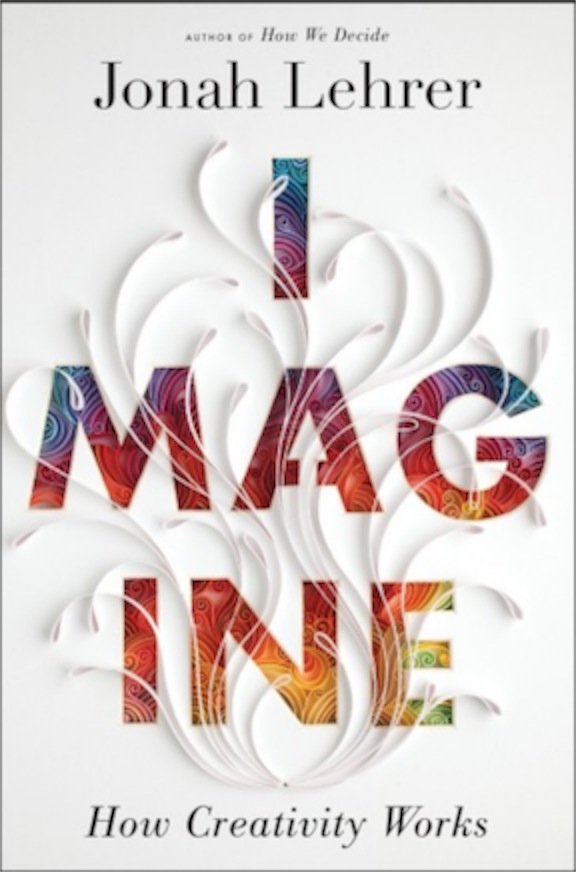 There have been a number of scientific studies about the nature of creativity. New technologies of advanced brain imaging are providing new discoveries nearly every day. We are beginning to understand more and more of the scientific explanations that underlie human creativity. We are far from understanding how it works, however. Jonah Lehrer, author of “How We Decide” has written a wonderful exploration of the science of imagination titled simply, “Imagine.” He explains why brainstorming meetings rarely produce new ideas and illustrates how time away from work makes workers more innovative. As a person of faith, it does not surprise me that the commandment to observe the Sabbath has been scientifically proven to be essential to human progress. Lehrer explains why this is so.
There have been a number of scientific studies about the nature of creativity. New technologies of advanced brain imaging are providing new discoveries nearly every day. We are beginning to understand more and more of the scientific explanations that underlie human creativity. We are far from understanding how it works, however. Jonah Lehrer, author of “How We Decide” has written a wonderful exploration of the science of imagination titled simply, “Imagine.” He explains why brainstorming meetings rarely produce new ideas and illustrates how time away from work makes workers more innovative. As a person of faith, it does not surprise me that the commandment to observe the Sabbath has been scientifically proven to be essential to human progress. Lehrer explains why this is so.
Tom Bissell has put together a collection of essays about what it means to create and the toil that creativity takes on its practitioners. He struggles with a notion that I have wondered about: Can art be bad and also genius at the same time?
 But I didn’t start out to write a blog about creativity. What I want to write about this morning is the topic of rubber chickens. I thought it would be good to follow up on my recent blog post on urban chickens with another sort of fowl. I’m not referring to the food that is served at too many convention banquets. I’m talking about the staple of American comedy – the prop of all props – a latex creation with no feathers that remotely resembles a plucked chicken. I’m told that in the minstrel days before the development of rubber and latex, jesters inflated pig bladders and attached them to a stick to use as a comic prop. If this is true, rubber chicken jokes have been around almost as long as people have been telling jokes to large audiences. The Archie McPhee catalog says that the rubber chicken dates back to the French Revolution when soldiers hung chickens from their muskets for luck. I’m thinking that Archie McPhee is not known as a source for accurate history, so assume that this story is apocryphal.
But I didn’t start out to write a blog about creativity. What I want to write about this morning is the topic of rubber chickens. I thought it would be good to follow up on my recent blog post on urban chickens with another sort of fowl. I’m not referring to the food that is served at too many convention banquets. I’m talking about the staple of American comedy – the prop of all props – a latex creation with no feathers that remotely resembles a plucked chicken. I’m told that in the minstrel days before the development of rubber and latex, jesters inflated pig bladders and attached them to a stick to use as a comic prop. If this is true, rubber chicken jokes have been around almost as long as people have been telling jokes to large audiences. The Archie McPhee catalog says that the rubber chicken dates back to the French Revolution when soldiers hung chickens from their muskets for luck. I’m thinking that Archie McPhee is not known as a source for accurate history, so assume that this story is apocryphal.
Wherever they originated, rubber chickens have inspired creative imagination in comedy routines for years. Note the smooth segue here that connects the beginning of this blog with what is to follow.
From time to time a rubber chicken shows up in the regular news. It happened again yesterday. The official NASA Science News Site reported, “Rubber Chicken Flies into Solar Radiation Storm.” The article, complete with photographs of the chicken in flight, high above the earth, reports on a group of high school students from Bishop, California who used a helium balloon to send a rubber chicken, named “Camilla” to an altitude of 120,000 feet where she (or was it a “he”) was exposed to high-energy solar protons. Last month the sun released the most intense radiation storm since 2003 and the students were studying its effects.
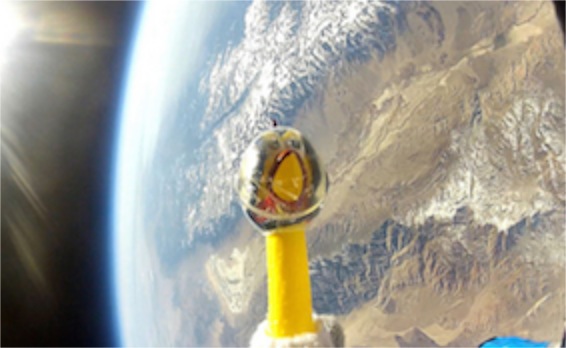 This particular rubber chicken is not just an ordinary bird. Camilla is the mascot of NASA’s Solar Dynamics Observatory. You can follow Camilla on Facebook, Twitter and Google+. It is part of a social network campaign to inform the public about the latest results in the research conducted by the observatory.
This particular rubber chicken is not just an ordinary bird. Camilla is the mascot of NASA’s Solar Dynamics Observatory. You can follow Camilla on Facebook, Twitter and Google+. It is part of a social network campaign to inform the public about the latest results in the research conducted by the observatory.
NASA assisted the students’ chicken launch. The space agency provided the balloon, video and still cameras, radiation badges and, of course, the chicken to make the flight. Actually the chicken flew twice, once before the storm and once in the midst of the storm to compare the results. Another experiment was carried aloft on the flight. Fifth grade students set up sunflower seeds to be irradiated in the storm. They have now planted their seeds to see how the flowers compare with those from seeds that did not receive the intense radiation. Another fifth grade experiment involved sending insects aloft, but none of the insects survived. They have been pinned to a black “Foamboard of Death.” Not every fifth-grade class has a collection of bugs that have been to the edge of space.
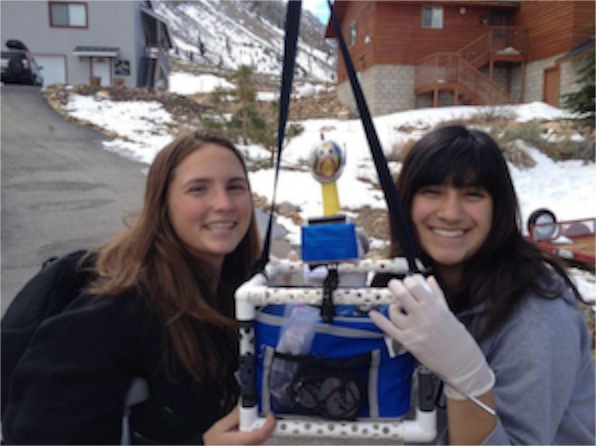 As I read the NASA article I was impressed with the program and with the students. But what fascinated me even more was the creativity of the teachers who worked out this program. We all know that teaching involves the highest and best of human creativity. The un-named teachers who are working with these students must be incredibly creative thinkers and innovators. I, for one, am grateful that they have been called to the field of education. Our world needs just that kind of creative imagination to inspire generations to come.
As I read the NASA article I was impressed with the program and with the students. But what fascinated me even more was the creativity of the teachers who worked out this program. We all know that teaching involves the highest and best of human creativity. The un-named teachers who are working with these students must be incredibly creative thinkers and innovators. I, for one, am grateful that they have been called to the field of education. Our world needs just that kind of creative imagination to inspire generations to come.
Jack Horkheimer used to end each edition of Stargazer with the phrase, “Keep looking up!” That would be good advice these days as well. After all, now that high school students know how to launch rubber chickens into space, there’s no telling what might happen next.
John Paul Lederach’s “The Moral Imagination” has been out for six or seven years, but I kept putting other books in front of it. I finally got around to reading it earlier this year. His striking invitation to think about the role of art and poetry in high-level peace negotiations demonstrates the need for creativity in facing the biggest problems in the world. It is not just that we enjoy art. We need art in order to survive. Like the character in the novel “The Cellist of Sarajevo,” Lederach reminds us that in deep conflict, art is not a luxury. It is a necessity. Art is a matter of life and death for a people – life and death for a culture.

Tom Bissell has put together a collection of essays about what it means to create and the toil that creativity takes on its practitioners. He struggles with a notion that I have wondered about: Can art be bad and also genius at the same time?

Wherever they originated, rubber chickens have inspired creative imagination in comedy routines for years. Note the smooth segue here that connects the beginning of this blog with what is to follow.
From time to time a rubber chicken shows up in the regular news. It happened again yesterday. The official NASA Science News Site reported, “Rubber Chicken Flies into Solar Radiation Storm.” The article, complete with photographs of the chicken in flight, high above the earth, reports on a group of high school students from Bishop, California who used a helium balloon to send a rubber chicken, named “Camilla” to an altitude of 120,000 feet where she (or was it a “he”) was exposed to high-energy solar protons. Last month the sun released the most intense radiation storm since 2003 and the students were studying its effects.

NASA assisted the students’ chicken launch. The space agency provided the balloon, video and still cameras, radiation badges and, of course, the chicken to make the flight. Actually the chicken flew twice, once before the storm and once in the midst of the storm to compare the results. Another experiment was carried aloft on the flight. Fifth grade students set up sunflower seeds to be irradiated in the storm. They have now planted their seeds to see how the flowers compare with those from seeds that did not receive the intense radiation. Another fifth grade experiment involved sending insects aloft, but none of the insects survived. They have been pinned to a black “Foamboard of Death.” Not every fifth-grade class has a collection of bugs that have been to the edge of space.

Jack Horkheimer used to end each edition of Stargazer with the phrase, “Keep looking up!” That would be good advice these days as well. After all, now that high school students know how to launch rubber chickens into space, there’s no telling what might happen next.
Copyright © 2012 by Ted Huffman. I wrote this. If you want to copy it, please ask for permission. There is a contact me button at the bottom of this page. If you want to share my blog a friend, please direct your friend to my web site.
Another reason I don't have cable TV
20/04/12 05:30
We were at a meeting last night. The presenter was well prepared and animated and did a good job. The content, however, was a bit dated. The information communicated is information that has been around for a long time and though the packaging of it has been tweaked over the years, it is basically the same thing that we have heard before. The presenter was good enough and the people gathered were interesting enough that the meeting was far from boring, but I did find my mind wandering a bit at times. Other participants reported similar experiences.
Part way into the meeting three dogs were visible outside the windows. There were two big ones and one little one. The dogs seemed to be familiar with each other and the big dogs helped the little one on occasion. I didn’t see the dogs, but heard about them from people who were facing in the right direction to see them.
Susan and I both grew up in homes with pet dogs, but we have not had a dog in our home during out married life. It isn’t that I don’t like dogs. I do like them. I can even imagine having a dog at some point in our lives. But we have been reluctant simply because it seems like a big responsibility. We don’t have a ranch where a dog can safely run off leash all day long. We live in a neighborhood without fences. A dog would need to be walked twice a day. That is a commitment of an hour a day every day. And for a good relationship, a dog needs more time and commitment than just walking. A dog needs to be groomed, fed, and given attention. A dog needs consistency in training.
 It is a good investment for dog owners. In exchange for the time and commitment of owners, dogs give unquestioning love and loyalty, provide a warm greeting and a quiet ear, and offer exercise and peace to their owners. Companion dogs and service dogs provide extremely helpful guidance to those whom they serve.
It is a good investment for dog owners. In exchange for the time and commitment of owners, dogs give unquestioning love and loyalty, provide a warm greeting and a quiet ear, and offer exercise and peace to their owners. Companion dogs and service dogs provide extremely helpful guidance to those whom they serve.
But I also witness dogs that are lonely – left alone too much. And we spend a lot of time away from our home each day. Yesterday is a good example. I left the house a little after 6 a.m. I got back a little after 10:30 p.m. Imagine if a dog would have had to wait the distance between those two times and then probably get shortchanged on the evening walk simply because I was too tired. There is a lovely little dog that lives down the street from our home that I have heard baying and moaning in the middle of the day. One day I convinced myself that the dog must be injured because it was making such a fuss. I walked down to check only to discover that the dog was simply lonely. It was safe in a dog run with plenty of fresh water. The dog run had been cleaned and though the food bowl was empty, I knew it had only recently become so. I’m sure that the owner doesn’t know that the dog carries on so, because whenever the owner is home the dog is happy to have its person around.
 Enter Dog TV. That’s right! In San Diego, two cable companies with over a million subscribers now offer a premium channel designed just for dogs. It costs $4.95 a month and is selling so well that the parent company PTV Media plans to offer it nationally in the next several months.
Enter Dog TV. That’s right! In San Diego, two cable companies with over a million subscribers now offer a premium channel designed just for dogs. It costs $4.95 a month and is selling so well that the parent company PTV Media plans to offer it nationally in the next several months.
You have to understand that I’m no fan of TV in the first place. We don’t have a big screen set. I rarely sit down to watch for more than ten or fifteen minutes. Most television programming bores me. I can’t imagine watching a channel that plays sounds and video designed for dogs and is available 24 hours a day. To get the right footage, cameramen got on their knees and shot low angles and long scenes. In production they muted colors, altered sound and added music specially written for dogs.
Research indicates that with analog television dogs only saw a flickering screen. Digital TV and high-definition cameras combined with enhanced production have produced images to which dogs respond. Dogs have responded to sounds from televisions for a long time, but not always in positive ways. Some sounds on television are at a high frequency that is irritating for dogs. Sudden noises like gunshots can be alarming. Fixing the sound for dogs means a soundtrack that seems like elevator music. The main goal of music selection and editing is to produce sounds that will irritate no one. The result is far from exciting and rarely rises to be interesting. Dogs can see blue and yellow, but not red or green. Dog TV removes the red and green to leave the colors dogs can see.
 There is a fair amount of science in the design of Dog TV. They even alternate programs designed for stimulation, relaxation and exposure so there is variety from a dog’s point of view. There are even educational programs designed to acclimate puppies to other animals, and things like traffic, babies, other pets and doorbells.
There is a fair amount of science in the design of Dog TV. They even alternate programs designed for stimulation, relaxation and exposure so there is variety from a dog’s point of view. There are even educational programs designed to acclimate puppies to other animals, and things like traffic, babies, other pets and doorbells.
OK the joke about television going to the dogs is too easy to skip.
Here is what bothers me. The best thing about having a dog is the relationship. Using a television as a dog sitting service removes the best part of the relationship. I know that people work long days and that they can’t take their dogs to work with them in most cases. But $4.95 a month plus the electricity to keep your television on while you are away from home is almost too small a price to pay to care for a dog. When little is invested, little is gained.
Does a dog get excited when the owner returns after a day of being entertained by the television? Does the dog feel like it needs an owner if its needs are met by technology? Can a dog and owner form the tight emotional bonds that are so wonderful if the owner doesn’t feel obligated to rush home to care for the pet?
 I guess it is just another sign of the times in which we live. I have just one more question. If the dog could work the remote, would the dog turn off the television as soon as the owner left for the day? If I were a dog, I’d want to do so. I prefer my naps without television. I’d want a dog that shared that preference.
I guess it is just another sign of the times in which we live. I have just one more question. If the dog could work the remote, would the dog turn off the television as soon as the owner left for the day? If I were a dog, I’d want to do so. I prefer my naps without television. I’d want a dog that shared that preference.
Part way into the meeting three dogs were visible outside the windows. There were two big ones and one little one. The dogs seemed to be familiar with each other and the big dogs helped the little one on occasion. I didn’t see the dogs, but heard about them from people who were facing in the right direction to see them.
Susan and I both grew up in homes with pet dogs, but we have not had a dog in our home during out married life. It isn’t that I don’t like dogs. I do like them. I can even imagine having a dog at some point in our lives. But we have been reluctant simply because it seems like a big responsibility. We don’t have a ranch where a dog can safely run off leash all day long. We live in a neighborhood without fences. A dog would need to be walked twice a day. That is a commitment of an hour a day every day. And for a good relationship, a dog needs more time and commitment than just walking. A dog needs to be groomed, fed, and given attention. A dog needs consistency in training.

But I also witness dogs that are lonely – left alone too much. And we spend a lot of time away from our home each day. Yesterday is a good example. I left the house a little after 6 a.m. I got back a little after 10:30 p.m. Imagine if a dog would have had to wait the distance between those two times and then probably get shortchanged on the evening walk simply because I was too tired. There is a lovely little dog that lives down the street from our home that I have heard baying and moaning in the middle of the day. One day I convinced myself that the dog must be injured because it was making such a fuss. I walked down to check only to discover that the dog was simply lonely. It was safe in a dog run with plenty of fresh water. The dog run had been cleaned and though the food bowl was empty, I knew it had only recently become so. I’m sure that the owner doesn’t know that the dog carries on so, because whenever the owner is home the dog is happy to have its person around.

You have to understand that I’m no fan of TV in the first place. We don’t have a big screen set. I rarely sit down to watch for more than ten or fifteen minutes. Most television programming bores me. I can’t imagine watching a channel that plays sounds and video designed for dogs and is available 24 hours a day. To get the right footage, cameramen got on their knees and shot low angles and long scenes. In production they muted colors, altered sound and added music specially written for dogs.
Research indicates that with analog television dogs only saw a flickering screen. Digital TV and high-definition cameras combined with enhanced production have produced images to which dogs respond. Dogs have responded to sounds from televisions for a long time, but not always in positive ways. Some sounds on television are at a high frequency that is irritating for dogs. Sudden noises like gunshots can be alarming. Fixing the sound for dogs means a soundtrack that seems like elevator music. The main goal of music selection and editing is to produce sounds that will irritate no one. The result is far from exciting and rarely rises to be interesting. Dogs can see blue and yellow, but not red or green. Dog TV removes the red and green to leave the colors dogs can see.

OK the joke about television going to the dogs is too easy to skip.
Here is what bothers me. The best thing about having a dog is the relationship. Using a television as a dog sitting service removes the best part of the relationship. I know that people work long days and that they can’t take their dogs to work with them in most cases. But $4.95 a month plus the electricity to keep your television on while you are away from home is almost too small a price to pay to care for a dog. When little is invested, little is gained.
Does a dog get excited when the owner returns after a day of being entertained by the television? Does the dog feel like it needs an owner if its needs are met by technology? Can a dog and owner form the tight emotional bonds that are so wonderful if the owner doesn’t feel obligated to rush home to care for the pet?

Copyright © 2012 by Ted Huffman. I wrote this. If you want to copy it, please ask for permission. There is a contact me button at the bottom of this page. If you want to share my blog a friend, please direct your friend to my web site.
A Messy Desk
19/04/12 05:00
There is more than one perspective to almost any story. Here is a debate that I don’t expect to see resolved in my lifetime: Is a messy desk a good or a bad sign? It depends on your perspective.
A messy desk is an invitation to negative judgment by others. According to a new survey by the staffing firm Adecco, a majority of Americans (57%) admit they judge coworkers by how clean or dirty they keep their workspaces. Nearly half of the workers surveyed believe that a messy workspace is caused by laziness.
 Before I go any farther, I need to be up front about the fact that I have my own point of view. My desk is messy. That is true at home and it is true at my office. I occasionally make some strides at clearing the clutter, but most days there are stacks of books on the tables and stacks of paper on my desk.
Before I go any farther, I need to be up front about the fact that I have my own point of view. My desk is messy. That is true at home and it is true at my office. I occasionally make some strides at clearing the clutter, but most days there are stacks of books on the tables and stacks of paper on my desk.
According to the Adecco survey, the majority of the people who see my office think I am a slob and that I lack discipline and initiative. I’m not quite ready to accept that judgment as accurate despite that Office Max released a study last year that found that office clutter undermines productivity and motivation. Jennie Dede, vice president of recruiting for Adecco said, “Your performance coincides with your workspace. When it’s organized and precise you have the mindset and motivation to work.” I guess we know where she is coming from. Studies often produce the results that those undertaking the studies want to get. Knowing that the Adecco study was undertaken with a bias doesn’t change the fact that there are plenty of people who make negative judgments based on the messiness of an office.
There is, of course, another perspective. Proponents of that perspective also have academic studies they like to quote. A series of linked studies, released in January of this year, examined productivity instead of perceptions as was the case in the Adecco study. When it comes to productivity, messiness wins every time. People think more clearly when all around is chaos. Visual and mental clutter forces human beings to focus and think more clearly.
Clean desks and workspaces are the results of employees investing work time and energy in keeping things clean. Workers who are not so focused on appearances accomplish more work in the same amount of time.
The studies found that messy desks actually boost work efficiency and enhance employee’s creativity in problem solving.
Of course those are the results that I want. You often get what you are looking for.
 Those of us with messy desks often cite to creative geniuses who were known to always work in cluttered and messy workspaces: Roald Dahl and Albert Einstein were both notorious for their untidy desks. Both contributed greatly to society. Both were amazingly productive in their lives.
Those of us with messy desks often cite to creative geniuses who were known to always work in cluttered and messy workspaces: Roald Dahl and Albert Einstein were both notorious for their untidy desks. Both contributed greatly to society. Both were amazingly productive in their lives.
The authors of the Adecco study believed the conventional wisdom: that a disorganized and messy environment can clutter one’s mind and complicate one’s judgments. They found the results they were looking for. However, not all of the evidence supports their opinion.
In the six linked studies released in January, scientists tested people’s responses in various environments including a messy shop front, a disorganized desk and a work environment where a language task reminded people of the messiness. In all six studies participants exhibited increased simplicity and clarity in their thinking when they were placed in messy situations. People think more clearly, make better choices, and accomplish more work when they are placed in messy environments.
Now if you are a person who always has a clean desk and keeps your workspace neat at all times, you will be able to find problems with the studies that connect office clutter with productivity. If you are a person who always works in a messy space, you will find problems with the studies about how messiness detracts from workplace efficiency. There are studies to support both points of view.
We messy people are, however, not the majority. Studies vary, but in the Adecco study less than half (43%) of us see no problem with the clutter in other people’s workspaces. People are judged more on appearances than on actual job performance. If you want to succeed, you cannot afford to ignore what other people think about you.
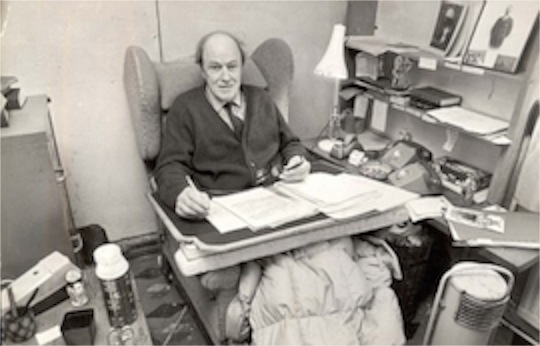 That is, unless you are Albert Einstein or Roald Dahl. Neither of them demonstrated any care at all about what others thought of them.
That is, unless you are Albert Einstein or Roald Dahl. Neither of them demonstrated any care at all about what others thought of them.
I’m no Albert Einstein. My competency with mathematics is strictly limited to simple algebra and maybe a few geometry problems. And I am no Roald Dahl. My imagination can get wild, but I have no ability to translate that imagination into short stories, poems or screenplays. People will be enjoying Willy Wonka and the Chocolate Factory long after they have forgotten that I ever existed.
Truth be told, I am not proud of my messy desk. I wish my office were more organized. Despite appearances, I think of myself as an organized person. I can go straight to a file cabinet in my home and produce organized files of every course I took in college and seminary. I have my books catalogued and shelved so that I can locate any book. My digital library database displays whether a book is at home or in my office. I can put my hands on studies that were taken in the 1950’s and reviewed by me in the 1970’s. I can be disciplined and organized when I need to be.
My messy desk is purely the product of my priorities. I have a job that is bigger than me. There is always one more call that needs to be made. There is always one more committee that needs to be motivated. There is always one more idea that might be incorporated into worship. I go to bed with undone work every night. In that environment, it seems to be wasteful for me to be cleaning my office when I could be sitting with an injured person or providing support to a youth working through difficult decisions.
And there is one more thing. With the Internet, it is easy to find pictures of offices that are messier than mine.

A messy desk is an invitation to negative judgment by others. According to a new survey by the staffing firm Adecco, a majority of Americans (57%) admit they judge coworkers by how clean or dirty they keep their workspaces. Nearly half of the workers surveyed believe that a messy workspace is caused by laziness.

According to the Adecco survey, the majority of the people who see my office think I am a slob and that I lack discipline and initiative. I’m not quite ready to accept that judgment as accurate despite that Office Max released a study last year that found that office clutter undermines productivity and motivation. Jennie Dede, vice president of recruiting for Adecco said, “Your performance coincides with your workspace. When it’s organized and precise you have the mindset and motivation to work.” I guess we know where she is coming from. Studies often produce the results that those undertaking the studies want to get. Knowing that the Adecco study was undertaken with a bias doesn’t change the fact that there are plenty of people who make negative judgments based on the messiness of an office.
There is, of course, another perspective. Proponents of that perspective also have academic studies they like to quote. A series of linked studies, released in January of this year, examined productivity instead of perceptions as was the case in the Adecco study. When it comes to productivity, messiness wins every time. People think more clearly when all around is chaos. Visual and mental clutter forces human beings to focus and think more clearly.
Clean desks and workspaces are the results of employees investing work time and energy in keeping things clean. Workers who are not so focused on appearances accomplish more work in the same amount of time.
The studies found that messy desks actually boost work efficiency and enhance employee’s creativity in problem solving.
Of course those are the results that I want. You often get what you are looking for.

The authors of the Adecco study believed the conventional wisdom: that a disorganized and messy environment can clutter one’s mind and complicate one’s judgments. They found the results they were looking for. However, not all of the evidence supports their opinion.
In the six linked studies released in January, scientists tested people’s responses in various environments including a messy shop front, a disorganized desk and a work environment where a language task reminded people of the messiness. In all six studies participants exhibited increased simplicity and clarity in their thinking when they were placed in messy situations. People think more clearly, make better choices, and accomplish more work when they are placed in messy environments.
Now if you are a person who always has a clean desk and keeps your workspace neat at all times, you will be able to find problems with the studies that connect office clutter with productivity. If you are a person who always works in a messy space, you will find problems with the studies about how messiness detracts from workplace efficiency. There are studies to support both points of view.
We messy people are, however, not the majority. Studies vary, but in the Adecco study less than half (43%) of us see no problem with the clutter in other people’s workspaces. People are judged more on appearances than on actual job performance. If you want to succeed, you cannot afford to ignore what other people think about you.

I’m no Albert Einstein. My competency with mathematics is strictly limited to simple algebra and maybe a few geometry problems. And I am no Roald Dahl. My imagination can get wild, but I have no ability to translate that imagination into short stories, poems or screenplays. People will be enjoying Willy Wonka and the Chocolate Factory long after they have forgotten that I ever existed.
Truth be told, I am not proud of my messy desk. I wish my office were more organized. Despite appearances, I think of myself as an organized person. I can go straight to a file cabinet in my home and produce organized files of every course I took in college and seminary. I have my books catalogued and shelved so that I can locate any book. My digital library database displays whether a book is at home or in my office. I can put my hands on studies that were taken in the 1950’s and reviewed by me in the 1970’s. I can be disciplined and organized when I need to be.
My messy desk is purely the product of my priorities. I have a job that is bigger than me. There is always one more call that needs to be made. There is always one more committee that needs to be motivated. There is always one more idea that might be incorporated into worship. I go to bed with undone work every night. In that environment, it seems to be wasteful for me to be cleaning my office when I could be sitting with an injured person or providing support to a youth working through difficult decisions.
And there is one more thing. With the Internet, it is easy to find pictures of offices that are messier than mine.

Copyright © 2012 by Ted Huffman. I wrote this. If you want to copy it, please ask for permission. There is a contact me button at the bottom of this page. If you want to share my blog a friend, please direct your friend to my web site.
Sitting with Silence
18/04/12 05:18

Some people thrive on meetings. They enjoy being with others and find that meetings give them an opportunity to express their views and feel like they are participating in leadership.
Others shun meetings. They prefer hands-on service to planning and policy setting.
I am somewhere in the middle of this spectrum. After years of service in my vocation, I can’t really imagine my life without meetings. But it is not difficult to imagine my life with a lot fewer meetings. There are days with too many meetings. The third Tuesday of the month is one of those days. I have five meetings scheduled for that day each month: 8:30 and 10:30 a.m.; 4:15, 6:00 and 7:00 p.m. Since I typically arrive in the office one or two hours before the first meeting and am around to lock up the building after the last meeting it means that at 14-hour day is normal. I go home tired on those days, and usually am a bit hungry, having skipped dinner.
I’m not complaining. It is the nature of my job to have a few days with lots of meetings. It is probably possible for me to do some re-scheduling, but it wouldn’t be easy. The meetings would happen without me, and do so when necessary, but I do a lot of resourcing for those meetings and my performance at those meetings is among the things upon which my job is evaluated.
A plumbing problem in our 50-year-old building added a bit of excitement yesterday as we scrambled to do an emergency shutdown of our boiler, turned off the water and guided the plumber through the attic to make the repairs.
Tucked into the middle of the action yesterday were two visits. Right after lunch I stopped to visit our congregation’s oldest member. A few weeks ago she was diagnosed with Respiratory Syncytial Virus (RSV). She seems to have gotten through the active stages of the illness. She has no fever, shows no signs of breathing distress, and indicates no pain. The doctors say, however, that the virus could be in her system for an additional 90 days. After 111 years of living, she is tired. She sleeps a lot. In the past six months I have caught her awake only twice. Still I sit with her. She sleeps with her hands tucked into the covers and it seems inappropriate for me to mess with her blankets, so I lay my hand on her shoulder and sometimes her forehead. I sing a hymn, read a scripture, say a prayer and pronounce a blessing. Sometimes I repeat the same words I used in a previous visit. I know her favorite verses of scripture. She used to recite the 23rd Psalm with me. These days, I do not see her lips moving when I visit.
I am sure that her life is slowly winding down. But I have no sense of the timing. In fact, visiting her seems to be a timeless process. She is living in Kyros time, not Chronos time. Her life is not regulated by clocks and calendars. It seems like her transition from this life will be a gentle affair without drama. I am sure that she does not need me to be present for that moment. But she seems to appreciate me being present at times. I am visiting more frequently now that the end seems to be closer. In a phone conversation, her daughter reflected on how different time is for a woman who is 111 years old. She joked, “I am the executor for mother’s estate, but I think I should change my will and name her executor for mine.”
In need of exercise, I left my pickup in the parking lot at the care center and walked the few blocks to the hospital where the elevators are under construction. I took the stairs to the seventh floor and visited a man who was the victim of a brutal attack sometime on Holy Saturday. He was found on Easter morning and rushed to the hospital where he has remained, recovering, ever since. The hospital has treated him with great care and kindness and they are doing an excellent job of managing his pain. But he does have fears and he does become agitated and he can be irrational at times. I have been visiting him daily. Some days he believes himself to be a couple of hundred miles away and marvels that I would come all the way to visit him. Yesterday his agitation was intense about a half hour before my visit. The nurse gave him a sedative. He wouldn’t wake up for me, though the nurses were encouraging me to try to wake him. I held his hand. He squeezed mine. We sat for a while together before I said a prayer, offered a blessing and took my leave.
The walk down the stairs was easier than the trip up. The walk back to my pickup was uphill and I kept up a brisk pace as I watched the clouds build and the sky darken to the west. A few drops of rain were falling as I reached the church.
I sometimes comment that when you have a job like mine the distinction between working and not working is so subtle that some people can’t recognize the difference. There is no doubt in my mind, however, that sitting with sleeping people was the most important work I did yesterday. I participated in the meetings. I accomplished the tasks required. I was a minister when I sat silently at the bedside of two people, lightly touching them.
The ministry of presence is more important than the ministry of administration.
The authority of the pastoral office is not defined by decisive action, but rather by silence.
I did not know these truths when I was a younger man. There were days, back then, when I shortened visits to make room for meetings. There were times when I felt awkward in the silence and read from the book of prayer to keep from having to sit with the silence.
Silence doesn’t report well on a job evaluation. It doesn’t show up on a performance review. It doesn’t offer any sound bites or photogenic moments. I do not live for the meetings. I could probably live without them.
I could not live without the silence.
“Come to me, all who labor and are heavy laden, and I will give you rest. Take my yoke upon you, and learn from me; for I am gentle and lowly in heart, and you will find rest for your souls. For my yoke is easy and my burden is light.” (Mt 11:28-30)
Copyright © 2012 by Ted Huffman. I wrote this. If you want to copy it, please ask for permission. There is a contact me button at the bottom of this page. If you want to share my blog a friend, please direct your friend to my web site.
Procrastination
17/04/12 05:31
The forms are all filled out. Copies are neatly placed in files. The checks have been written. The envelopes are ready to go into the mail today. Once again our taxes are completed and will be sent on the day of the deadline. I don’t know how many times over the years, but it is not an unusual thing for us to mail our taxes on the day of the deadline. Part of it is that we often owe a little bit and we see no reason to send in money before it is due. Part of it is that the forms are complex and we want to make sure that we have checked for mistakes. Part of it is that Easter and the tax deadline have a way of meaning that we are busy at the office at the same time that we are busy at home. In the thirty-nine years that we have been married and the few years before that that I have been filing my income taxes, we have only once applied for an extension.
 Last week, however, a radio interviewer was having fun with an author of a book on procrastination. The author was smugly reporting how he is very well organized and begins work in January on his taxes and files his return months before the deadline. The implication was that everyone should do the same thing. The other implication was that there is something wrong with people who wait until the deadline. My reaction to the interview was to think that the person who wrote the book must have a very boring life. I decided to make his tax preparation next year easier by not purchasing the book. Less income should help. I’m sure the author won’t notice my effect on his book sales.
Last week, however, a radio interviewer was having fun with an author of a book on procrastination. The author was smugly reporting how he is very well organized and begins work in January on his taxes and files his return months before the deadline. The implication was that everyone should do the same thing. The other implication was that there is something wrong with people who wait until the deadline. My reaction to the interview was to think that the person who wrote the book must have a very boring life. I decided to make his tax preparation next year easier by not purchasing the book. Less income should help. I’m sure the author won’t notice my effect on his book sales.
I am not always pushing the deadlines. As a student, I often had my work completed several days before the deadline. Too much deadline pressure seems to limit my creativity. It is a rare week when I don’t have a fairly clear sense of what my Sunday sermon will be by Wednesday. I prefer to have my work completed before the deadlines. However, the realities of life have taught me that I can work under pressure, that sometimes I need to re-evaluate my priorities and do my work in a different order and a different way than I would like.
One thing that challenges my sense of timing is working with others. Other people have different ways of approaching deadlines. A team that shares work fairly often works close to the deadline simply because a single member can slow the process. Those who lack patience often end up doing extra work. Another factor is the ways in which many people in our society feel that they have no control over their schedule. It is quite common for us to work with high school students who either don’t know their schedule, or who will say “yes” only to discover a conflict later. There are lots of relatively simple jobs in the church that take more time than anticipated because of the dynamics of complex schedules.
Another factor in the life of the church is that unanticipated events occur. I might have planned to take a writing day, but an illness can land someone in the hospital and my priorities have to be shifted. I might be settling in to write thank you notes, but a face in the doorway represents someone who needs to talk. Many of the core responsibilities of my job involve interruptions. I have a colleague who comments that interruptions are the real business of a pastor.
 I think that organization is an important skill. But I have met plenty of well-organized people who meet every deadline, always have a clean desk, and are very boring. The truth is that creative thinking sometimes comes from sitting and doing nothing. Those who respond to every letter or e-mail as it comes into their life probably consume less time in making their responses. But there are notes that I receive that should be read several times before a response is made. There are responses I make that require some thinking and mulling. I’ve written plenty of drafts of notes where pushing the “send” button too soon would result in a less than thoughtful response – and sometimes would result in feelings being hurt.
I think that organization is an important skill. But I have met plenty of well-organized people who meet every deadline, always have a clean desk, and are very boring. The truth is that creative thinking sometimes comes from sitting and doing nothing. Those who respond to every letter or e-mail as it comes into their life probably consume less time in making their responses. But there are notes that I receive that should be read several times before a response is made. There are responses I make that require some thinking and mulling. I’ve written plenty of drafts of notes where pushing the “send” button too soon would result in a less than thoughtful response – and sometimes would result in feelings being hurt.
Not all procrastination is bad.
I am no advocate of people becoming so afraid of failure that they become paralyzed. I have met people who are unhappy because they don’t seem to be able to finish any task. Missing a tax deadline, for example, has pretty significant consequences. We worship at the same time each week. Our people have a right to expect that we are prepared and ready to begin on time.
Life is about achieving balance. But it is also about knowing yourself. The problem with most books on organization is that they fail to take in the complexities of human behavior and the differences in personality types. Just because the author has found the perfect solution for him or her self does not mean that they have anything significant to share with someone who is different. Simple solutions to complex problems are rarely complete solutions. They work for some people and don’t work for others.
 Coming too close to the deadline can make me nervous and nervousness almost always wastes time. Besides it is uncomfortable. I can avoid the discomfort by completing the task a little bit before the deadline.
Coming too close to the deadline can make me nervous and nervousness almost always wastes time. Besides it is uncomfortable. I can avoid the discomfort by completing the task a little bit before the deadline.
I’m no expert on the topic. And I haven’t achieved the correct balance for every situation. But I have learned to be comfortable with my own style and to make it work for me. I probably should study the subject a little more. I’m sure I could make improvements. I could start by reading “Procrastination” by Jane Burka, or “The Now Habit” by Neil Fiore, or “Self-Discipline in 10 Days” by Theodore Bryant. But even if I did get around to ordering the books, I’ve got several books on hand that I want to read first.

I am not always pushing the deadlines. As a student, I often had my work completed several days before the deadline. Too much deadline pressure seems to limit my creativity. It is a rare week when I don’t have a fairly clear sense of what my Sunday sermon will be by Wednesday. I prefer to have my work completed before the deadlines. However, the realities of life have taught me that I can work under pressure, that sometimes I need to re-evaluate my priorities and do my work in a different order and a different way than I would like.
One thing that challenges my sense of timing is working with others. Other people have different ways of approaching deadlines. A team that shares work fairly often works close to the deadline simply because a single member can slow the process. Those who lack patience often end up doing extra work. Another factor is the ways in which many people in our society feel that they have no control over their schedule. It is quite common for us to work with high school students who either don’t know their schedule, or who will say “yes” only to discover a conflict later. There are lots of relatively simple jobs in the church that take more time than anticipated because of the dynamics of complex schedules.
Another factor in the life of the church is that unanticipated events occur. I might have planned to take a writing day, but an illness can land someone in the hospital and my priorities have to be shifted. I might be settling in to write thank you notes, but a face in the doorway represents someone who needs to talk. Many of the core responsibilities of my job involve interruptions. I have a colleague who comments that interruptions are the real business of a pastor.

Not all procrastination is bad.
I am no advocate of people becoming so afraid of failure that they become paralyzed. I have met people who are unhappy because they don’t seem to be able to finish any task. Missing a tax deadline, for example, has pretty significant consequences. We worship at the same time each week. Our people have a right to expect that we are prepared and ready to begin on time.
Life is about achieving balance. But it is also about knowing yourself. The problem with most books on organization is that they fail to take in the complexities of human behavior and the differences in personality types. Just because the author has found the perfect solution for him or her self does not mean that they have anything significant to share with someone who is different. Simple solutions to complex problems are rarely complete solutions. They work for some people and don’t work for others.

I’m no expert on the topic. And I haven’t achieved the correct balance for every situation. But I have learned to be comfortable with my own style and to make it work for me. I probably should study the subject a little more. I’m sure I could make improvements. I could start by reading “Procrastination” by Jane Burka, or “The Now Habit” by Neil Fiore, or “Self-Discipline in 10 Days” by Theodore Bryant. But even if I did get around to ordering the books, I’ve got several books on hand that I want to read first.
Copyright © 2012 by Ted Huffman. I wrote this. If you want to copy it, please ask for permission. There is a contact me button at the bottom of this page. If you want to share my blog a friend, please direct your friend to my web site.
A Celebration I'd Like to See
16/04/12 04:27
I have been fortunate to travel, but there is something about traveling that makes one want to travel more. I have a list of places I would like to go and things I would like to see. The list is too long for the amount of time and financial resources I have, so there will be places and events that I will only visit in my imagination. I think to myself, “Wouldn’t it be something to be in Vienna for the New Year’s Strauss Concert?” or “I’d love to be at the Kennedy Center on Martin Luther King, Jr. Day to hear the ‘Let Freedom Ring’ choral concert.” There are other events, some even more obscure, which sound interesting to me. Some April, it would be fun to be in Thailand for the annual water festival.
April is hot in Thailand. Temperatures top 100 degrees Fahrenheit. The Monsoon season usually starts sometime in May, so April is a really hot month before the cooling rains start to fall. It is a climate that is vastly different from the places where I have spent most of my life. When the monsoons come, there are weeks when it rains more than the annual rainfall in the places where I have lived. In April in Thailand, the humidity is already rising. When you go outside of an air-conditioned building the heat hits you with a force that makes you wonder whether or not you want to be outside at all.
It is in this time of transition in the middle of April, before the monsoons come, that the Thai traditionally celebrated their new year. The festival, known as Songkran, started as a moveable festival, following the lunar calendar. After the Western calendar came into use in Thailand, with New Year’s Day on January 1, Thai people continued to celebrate Songkran. For many years it was celebrated on the 1st of April. After the 2nd World War, the celebration was moved to the middle of the month and expanded to include three days so that people could return to their hometowns to celebrate the occasion with their families. This year Songkran was held April 13 – 15.
 Here is what would make being in Thailand for the festival so much fun. The Thai people celebrate with huge water fights. Everyone from teetering toddlers holding Tupperware bowls to grandparents arming themselves with “super soaker” water cannons gets involved in the fun. Drenching neighbors and friends is all part of the fun. Bands of teenagers cruise the streets, riding in the back of trucks, throwing water over pedestrians as they pass. Water pistols, hoses and buckets are used to soak anyone and everyone they see.
Here is what would make being in Thailand for the festival so much fun. The Thai people celebrate with huge water fights. Everyone from teetering toddlers holding Tupperware bowls to grandparents arming themselves with “super soaker” water cannons gets involved in the fun. Drenching neighbors and friends is all part of the fun. Bands of teenagers cruise the streets, riding in the back of trucks, throwing water over pedestrians as they pass. Water pistols, hoses and buckets are used to soak anyone and everyone they see.
There was a time when the Thai tourism board tried to promote immunity for tourists, fearing that a surprise drenching might quash a shopper’s spirits, but these days, the tourists come to Thailand in search of the fun and get right into the celebrations.
 There is a serious side to the celebrations as well. The day is a Buddhist festival and one of the traditions is going to a monastery to pray. Gifts of food for the monks are traditional. In addition, it is believed that it will bring good luck and prosperity in the New Year if celebrants participate in the cleansing of the temple. Home shrines are also cleaned as part of the observance. Images of Buddha are cleansed by gently pouring water mixed with fragrance over the statues and images. The water poured over the Buddha was considered to be sacred, so it was collected. This “blessed” water was then taken to elders as a sign of respect. Gently pouring the blessed water on the shoulder of an elder is believed to wash away bad things.
There is a serious side to the celebrations as well. The day is a Buddhist festival and one of the traditions is going to a monastery to pray. Gifts of food for the monks are traditional. In addition, it is believed that it will bring good luck and prosperity in the New Year if celebrants participate in the cleansing of the temple. Home shrines are also cleaned as part of the observance. Images of Buddha are cleansed by gently pouring water mixed with fragrance over the statues and images. The water poured over the Buddha was considered to be sacred, so it was collected. This “blessed” water was then taken to elders as a sign of respect. Gently pouring the blessed water on the shoulder of an elder is believed to wash away bad things.
It doesn’t take a lot of imagination to see how the traditional blessings could become exaggerated. After all, April is the hottest month of the year in Thailand. When the temperature settles between 100 and 110 degrees a bucket of cool water poured over your head can feel refreshing. Just cooling down a little can be considered to be a blessing.
 Beauty pageants, talent contests and other events are scheduled to celebrate Songkran. But the big thing these days is the water fight. Getting soaked is just part of the joy of visiting Thailand during Songkran. There have been a few accidents and injuries. Obviously, it can be dangerous to throw a bucket of water into the face of someone driving a motorcycle. But for the most part people are careful and respectful. Surprise is part of the fun, so the water is likely to come from behind or above or any other direction where you don’t happen to be looking at the moment.
Beauty pageants, talent contests and other events are scheduled to celebrate Songkran. But the big thing these days is the water fight. Getting soaked is just part of the joy of visiting Thailand during Songkran. There have been a few accidents and injuries. Obviously, it can be dangerous to throw a bucket of water into the face of someone driving a motorcycle. But for the most part people are careful and respectful. Surprise is part of the fun, so the water is likely to come from behind or above or any other direction where you don’t happen to be looking at the moment.
I’m often up for a water fight. When it is really hot, the game seems to be even more fun. And, since I live in a place where elephants are not common, the idea of using an elephant to your advantage in a water fight seems intriguing.
 We conduct a baptismal renewal ceremony at New Years. I dip an evergreen bow in the font and sprinkle the congregants as a reminder of their baptism and their commitment to their faith. Not very much water gets to any individual, but the drops can surprise and I do enjoy watching the reaction of worshipers who participate as I sprinkle the water. So far, no one has suggested using an elephant.
We conduct a baptismal renewal ceremony at New Years. I dip an evergreen bow in the font and sprinkle the congregants as a reminder of their baptism and their commitment to their faith. Not very much water gets to any individual, but the drops can surprise and I do enjoy watching the reaction of worshipers who participate as I sprinkle the water. So far, no one has suggested using an elephant.
I guess if I were to miss Songkran, I could get into another Thai festival that comes later, during the second week of May. In the Northeastern province of Yasothon, Bun Bang Fai is the rocket festival. The legend is that there once was a rain god named Vassakan who loved to be worshipped with fire. The townspeople created a rocket to send fire to heaven, where the god resided. They believed the god would hear their prayers and bless them with plentiful rain for growing rice. Rockets, packed with several different kinds of gunpowder are launched. Contests are held for the biggest and highest flying rocket. On festival day, people wear colorful traditional costumes, hold parades, and play folk music.
But here is the part of the rocket festival that caught my attention. The makers of rockets that fail to ignite are thrown in the mud. Even a rocket festival requires the application of water in Thailand.
April is hot in Thailand. Temperatures top 100 degrees Fahrenheit. The Monsoon season usually starts sometime in May, so April is a really hot month before the cooling rains start to fall. It is a climate that is vastly different from the places where I have spent most of my life. When the monsoons come, there are weeks when it rains more than the annual rainfall in the places where I have lived. In April in Thailand, the humidity is already rising. When you go outside of an air-conditioned building the heat hits you with a force that makes you wonder whether or not you want to be outside at all.
It is in this time of transition in the middle of April, before the monsoons come, that the Thai traditionally celebrated their new year. The festival, known as Songkran, started as a moveable festival, following the lunar calendar. After the Western calendar came into use in Thailand, with New Year’s Day on January 1, Thai people continued to celebrate Songkran. For many years it was celebrated on the 1st of April. After the 2nd World War, the celebration was moved to the middle of the month and expanded to include three days so that people could return to their hometowns to celebrate the occasion with their families. This year Songkran was held April 13 – 15.

There was a time when the Thai tourism board tried to promote immunity for tourists, fearing that a surprise drenching might quash a shopper’s spirits, but these days, the tourists come to Thailand in search of the fun and get right into the celebrations.

It doesn’t take a lot of imagination to see how the traditional blessings could become exaggerated. After all, April is the hottest month of the year in Thailand. When the temperature settles between 100 and 110 degrees a bucket of cool water poured over your head can feel refreshing. Just cooling down a little can be considered to be a blessing.

I’m often up for a water fight. When it is really hot, the game seems to be even more fun. And, since I live in a place where elephants are not common, the idea of using an elephant to your advantage in a water fight seems intriguing.

I guess if I were to miss Songkran, I could get into another Thai festival that comes later, during the second week of May. In the Northeastern province of Yasothon, Bun Bang Fai is the rocket festival. The legend is that there once was a rain god named Vassakan who loved to be worshipped with fire. The townspeople created a rocket to send fire to heaven, where the god resided. They believed the god would hear their prayers and bless them with plentiful rain for growing rice. Rockets, packed with several different kinds of gunpowder are launched. Contests are held for the biggest and highest flying rocket. On festival day, people wear colorful traditional costumes, hold parades, and play folk music.
But here is the part of the rocket festival that caught my attention. The makers of rockets that fail to ignite are thrown in the mud. Even a rocket festival requires the application of water in Thailand.
Copyright © 2012 by Ted Huffman. I wrote this. If you want to copy it, please ask for permission. There is a contact me button at the bottom of this page. If you want to share my blog a friend, please direct your friend to my web site.
Refreshing Rain
15/04/12 05:27
And the rain came down. The cooling rain soaked into the ground and formed puddles. I even found a bit of mud yesterday. It was such a pleasant day. The forecast was for a 30% chance of rain and we received nearly a half an inch, with more coming over night. And we should get some more today. It is possible that temperatures will drop enough for a bit of snow tonight. The possibility of rain remains into next week.
It is such a blessing. The forest was dry. The grass crackled with each step. The deer were showing a distinct preference for the places where we had done a little watering. Fire dangers have been very high throughout the spring so far. The Interagency Fire Center went on alert on March 17, as we set record after record for the warmest days. Then the winds came and dried out everything even more.
But Friday we got a little rain. Yesterday we had a genuine rainy day. I got wet walking from the hospital to my pickup. I had to clean the spots off my glasses before I could drive. I ran the defroster in the truck for the first time in a long time. We all seemed a little happier and a little bit relieved to get the rain.
 Now we need a lot of moisture this spring. I think we were something like 1.3 inches behind average in rainfall before it started raining. We are probably nearing normal precipitation, now, but we have a long summer ahead of us.
Now we need a lot of moisture this spring. I think we were something like 1.3 inches behind average in rainfall before it started raining. We are probably nearing normal precipitation, now, but we have a long summer ahead of us.
With a daughter living in Warrensburg, MO, I keep an eye on the computer when severe weather threatens anywhere in her area. There have been a lot of tornadoes this year, and last night was no exception. Fortunately none were near where our daughter and son-in-law live, but to the south and west of them, there were some nasty storms. In Kansas, in Wichita, a tornado caused damage at McConnell Air Force Base and at the Boeing plant. There was a mobile home park in the city that was heavily damaged as well. Five fatalities were reported near Woodward Oklahoma. In Iowa, the town of Thurman is said to be about 75% destroyed. They reported baseball size hail in Petersburg, Nebraska.
The jet stream is dipping quite low these days. It is bringing cool air with a bit of pacific moisture to our part of the country. Not far southeast of here, however, that cool upper air is running into warm, wet air moving up from the Gulf of Mexico. When the two air masses collide, with low level winds heading north and upper level winds heading east, everything starts to spin and the clouds start to rise. Conditions become right for the formation of powerful tornadoes.
We have much better weather prediction and more accurate storm warnings than was the case for previous generations. For decades the way people knew a storm was coming was by looking at the sky. This meant that they were often unaware of the storms that came in the night. We’ve got it better, though there can be events that develop so quickly that no warning can be raised. That was the case of the storms that did a lot of damage in Kansas earlier this year.
 I know that there is risk involved. I am genuinely sorry for the losses that people experience in the big storms. But I don’t really want to live in a world where everything is perfectly predicted. I appreciate an occasional surprise from the weather. I don’t mind getting wet when the forecast said 30% chance of rain. Ever the optimist, I interpret a 30% chance of rain as a 70% chance that it won’t rain.
I know that there is risk involved. I am genuinely sorry for the losses that people experience in the big storms. But I don’t really want to live in a world where everything is perfectly predicted. I appreciate an occasional surprise from the weather. I don’t mind getting wet when the forecast said 30% chance of rain. Ever the optimist, I interpret a 30% chance of rain as a 70% chance that it won’t rain.
We had to postpone a planned church yard work day yesterday. In addition to the gift of the rain, I had the gift of three or so hours of time that I had planned to spend working with other church members spreading fertilizer, cleaning out beds, pulling weeds and sprucing up the building. Now we’ll tackle those chores on another day, but yesterday turned into a lazy rainy day. It was a treat.
People have vivid memories of what can happen when we get too much rain. In June, we’ll observe the 40th anniversary of the 1972 Rapid City flood. Heavy rainfall in the hills resulted in a gigantic flash flood. The dam at Canyon Lake broke. More than 200 people lost their lives. Over 1,200 homes were destroyed and as many as 5,000 vehicles were destroyed. It was a major event and there was more than a small amount of loss and tragedy. We know the power of the weather.
But we also have the perspective of time. Forty years after the flood, we have developed confidence in the city’s flood plan. We’ve seen some pretty big rainfalls when the emergency waterways worked, the greenbelt took the excess creek flow, the dams held and damage was kept to a minimum. Of course we’ve never had a storm quite like the one that dropped 10 inches of rain over a 60 square mile area in one day. There was one place in the hills that got 4 inches of rain in a half hour during the storm in 1972. Hopefully we will never forget the power of that storm.
I’m sure it was in the back of my mind when we purchased our current home, perched near the top of a hill, with no creek nearby. There has never been water in the basement of this house. And that is just fine with me.
I do, however, enjoy an occasional surprise from the weather. And as long as we are going to be surprised, it is nice to have the surprise be a gentle rain that refreshes and renews the countryside. It won’t bother me a bit if the rain continues all week. April and May are supposed to be our wettest months.
I still read the forecast in my usual way. There is a 20% chance of a little snow this evening. That means there is an 80% chance that it won’t snow.
It is such a blessing. The forest was dry. The grass crackled with each step. The deer were showing a distinct preference for the places where we had done a little watering. Fire dangers have been very high throughout the spring so far. The Interagency Fire Center went on alert on March 17, as we set record after record for the warmest days. Then the winds came and dried out everything even more.
But Friday we got a little rain. Yesterday we had a genuine rainy day. I got wet walking from the hospital to my pickup. I had to clean the spots off my glasses before I could drive. I ran the defroster in the truck for the first time in a long time. We all seemed a little happier and a little bit relieved to get the rain.

With a daughter living in Warrensburg, MO, I keep an eye on the computer when severe weather threatens anywhere in her area. There have been a lot of tornadoes this year, and last night was no exception. Fortunately none were near where our daughter and son-in-law live, but to the south and west of them, there were some nasty storms. In Kansas, in Wichita, a tornado caused damage at McConnell Air Force Base and at the Boeing plant. There was a mobile home park in the city that was heavily damaged as well. Five fatalities were reported near Woodward Oklahoma. In Iowa, the town of Thurman is said to be about 75% destroyed. They reported baseball size hail in Petersburg, Nebraska.
The jet stream is dipping quite low these days. It is bringing cool air with a bit of pacific moisture to our part of the country. Not far southeast of here, however, that cool upper air is running into warm, wet air moving up from the Gulf of Mexico. When the two air masses collide, with low level winds heading north and upper level winds heading east, everything starts to spin and the clouds start to rise. Conditions become right for the formation of powerful tornadoes.
We have much better weather prediction and more accurate storm warnings than was the case for previous generations. For decades the way people knew a storm was coming was by looking at the sky. This meant that they were often unaware of the storms that came in the night. We’ve got it better, though there can be events that develop so quickly that no warning can be raised. That was the case of the storms that did a lot of damage in Kansas earlier this year.

We had to postpone a planned church yard work day yesterday. In addition to the gift of the rain, I had the gift of three or so hours of time that I had planned to spend working with other church members spreading fertilizer, cleaning out beds, pulling weeds and sprucing up the building. Now we’ll tackle those chores on another day, but yesterday turned into a lazy rainy day. It was a treat.
People have vivid memories of what can happen when we get too much rain. In June, we’ll observe the 40th anniversary of the 1972 Rapid City flood. Heavy rainfall in the hills resulted in a gigantic flash flood. The dam at Canyon Lake broke. More than 200 people lost their lives. Over 1,200 homes were destroyed and as many as 5,000 vehicles were destroyed. It was a major event and there was more than a small amount of loss and tragedy. We know the power of the weather.
But we also have the perspective of time. Forty years after the flood, we have developed confidence in the city’s flood plan. We’ve seen some pretty big rainfalls when the emergency waterways worked, the greenbelt took the excess creek flow, the dams held and damage was kept to a minimum. Of course we’ve never had a storm quite like the one that dropped 10 inches of rain over a 60 square mile area in one day. There was one place in the hills that got 4 inches of rain in a half hour during the storm in 1972. Hopefully we will never forget the power of that storm.
I’m sure it was in the back of my mind when we purchased our current home, perched near the top of a hill, with no creek nearby. There has never been water in the basement of this house. And that is just fine with me.
I do, however, enjoy an occasional surprise from the weather. And as long as we are going to be surprised, it is nice to have the surprise be a gentle rain that refreshes and renews the countryside. It won’t bother me a bit if the rain continues all week. April and May are supposed to be our wettest months.
I still read the forecast in my usual way. There is a 20% chance of a little snow this evening. That means there is an 80% chance that it won’t snow.
Copyright © 2012 by Ted Huffman. I wrote this. If you want to copy it, please ask for permission. There is a contact me button at the bottom of this page. If you want to share my blog a friend, please direct your friend to my web site.
Counting Birds
14/04/12 05:26
I suppose that it says something about my sense of humor that I am a big fan of Gary Larson cartoons. Long after “The Far Side” disappeared from newspapers, I still enjoy going over my books of the cartoons from time to time. I still find myself laughing at his quirky drawings and unexpected punch lines. One of his cartoons shows a penguin, standing amid a throng of virtually identical birds, singing, “I gotta be me! Oh I just gotta be me . . .”
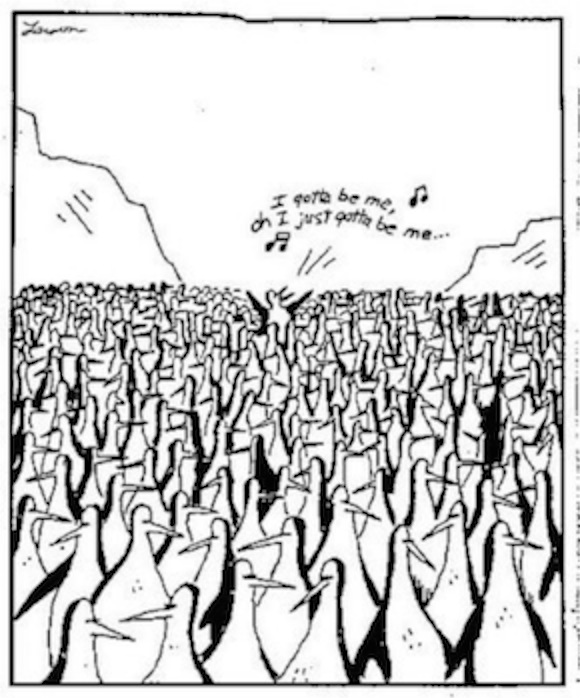 Larson was a student of the sciences and knew that attributing human traits to animals is a stretch. It is unlikely that penguins experience anything remotely similar to human thoughts and emotions. They certainly don’t say our words or sing our songs. Still, despite the absurdity of the cartoon, there is a grain of truth in it. That is part of what makes the cartoon so funny. Animals that spend most of their time in large groups still have to tell the difference between individuals. They have to be able to recognize mates, and when they are young, nurture specific offspring.
Larson was a student of the sciences and knew that attributing human traits to animals is a stretch. It is unlikely that penguins experience anything remotely similar to human thoughts and emotions. They certainly don’t say our words or sing our songs. Still, despite the absurdity of the cartoon, there is a grain of truth in it. That is part of what makes the cartoon so funny. Animals that spend most of their time in large groups still have to tell the difference between individuals. They have to be able to recognize mates, and when they are young, nurture specific offspring.
 When we think of penguins, we usually think of emperor penguins. These birds evolved in a very narrow and harsh ecological niche, living and breeding in the coldest environment in the world. There are some advantages to their particular existence: there are no predators and no competition for food. But the price of these luxuries is a harsh environment and the necessity of living in large colonies.
When we think of penguins, we usually think of emperor penguins. These birds evolved in a very narrow and harsh ecological niche, living and breeding in the coldest environment in the world. There are some advantages to their particular existence: there are no predators and no competition for food. But the price of these luxuries is a harsh environment and the necessity of living in large colonies.
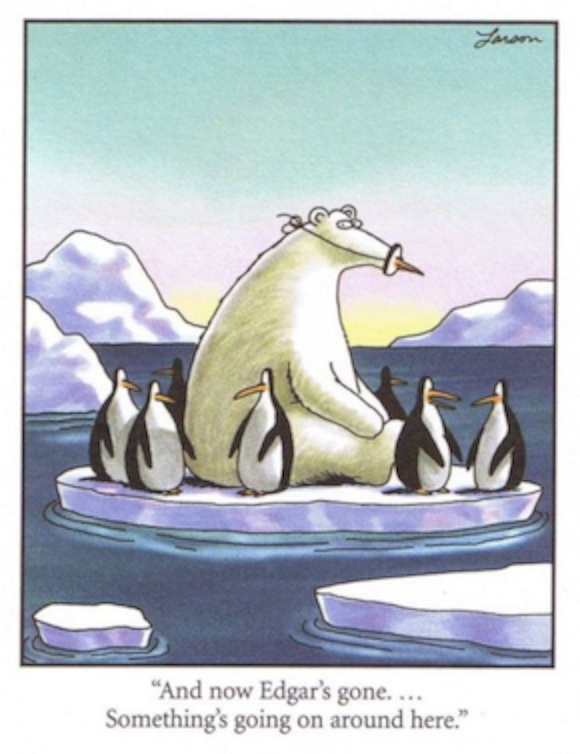 There is a second Larson cartoon about penguins that I like for the subtlety of its humor. In this one, a group of penguins and a polar bear are on an ice flow. The polar bear is wearing a fake “bill.” One penguin is saying to the other, “And now Edgar’s gone . . . Something’s going on around here.” On one level, the silliness of the cartoon is that the penguins don’t recognize the bear with the obviously fake disguise. On another level, the sense of humor is tickled by the absurdity of penguins that live and breed in Antarctica, near the South Pole, encountering a polar bear. Polar bears live and breed in the Arctic, near the North Pole. The “something’s going on around here,” is the distance that either the bear or the penguins would have had to travel in order to encounter one another.
There is a second Larson cartoon about penguins that I like for the subtlety of its humor. In this one, a group of penguins and a polar bear are on an ice flow. The polar bear is wearing a fake “bill.” One penguin is saying to the other, “And now Edgar’s gone . . . Something’s going on around here.” On one level, the silliness of the cartoon is that the penguins don’t recognize the bear with the obviously fake disguise. On another level, the sense of humor is tickled by the absurdity of penguins that live and breed in Antarctica, near the South Pole, encountering a polar bear. Polar bears live and breed in the Arctic, near the North Pole. The “something’s going on around here,” is the distance that either the bear or the penguins would have had to travel in order to encounter one another.
I read an article this week about scientists from the England, Australia and the United States who have used advanced satellite technology to trace and count penguins. A baseline count of emperor penguins will give a number for comparison. It is believed that monitoring the number of penguins will give some information about the nature and speed of global warming. Penguins are susceptible to warming. If the ice begins to break up earlier in the year, the fledglings may not have a chance to acquire their full adult, waterproof plumage. High rates of infant mortality might result. Also the main food source for penguins is krill. These tiny crustaceans feed on algae on ice. When the ice melts, the krill lose their food source. A drop in krill population means less food for penguins.
The study is more difficult than you might imagine. Have you ever tried to count penguins? The first step is to take a picture because the birds are almost constantly in motion. The problem is that the colonies are so big that capturing an entire colony in a single picture is impossible unless the photograph is taken from the air. Then the resolution is not high enough to enable counting individual birds. Even the highest resolution satellite photographs make counting a difficult challenge. This new study compares counts from high-resolution satellite images, ground counts made by observers in Antarctica, and other data. Repeated satellite images are used to track guano on the ice to follow the movement of the colonies.
The results are a surprise for scientist. There are more emperor penguins on Antarctica than previously thought. The count of 595,000 is almost double the previous estimates of 270,000 – 350,000 birds. It is the first comprehensive count of any species based primarily on satellite data. There has to be a Larson-like cartoon somewhere in the fact that the latest and best of complex space technology is being used to count birds that can’t fly. But I’m no Gary Larson, so don’t count on me for the cartoon.
I am far more interested in the discoveries of how we are connected to all of the other creatures with which we share this planet. What happens to penguins in the Antarctic has an effect upon our lives. There is positive benefit for humans coming from paying attention to how many penguins there are. As the Lakota say, “Mitakuye Oyasin” – all are related. Understanding that we have connections not only to human relatives, but to all species, gives us a more ecologically accurate understanding of our place in this world.

Like the penguin in the cartoon, we have a strong urge to assert our individuality. For as long as we know, humans have tried to define our role in the world as unique among the creatures. We thought we were the only ones to make tools, but that is not true. We thought we were the only ones to develop language, but that is not true. We believe that our emotions are unique, but that is being questioned. We claim that our intelligence is superior to all other creatures, but we don’t always behave as if we were more intelligent. It is a tension that pulls us in to directions. On the one hand we want to see how we fit into the web of this complex ecology of our planet. On the other hand, we want to assert our unique identity and distinguish ourselves from others.
All of these mental gymnastics really are for our understanding. Saying we are unique does not remove our dependence upon other species. Claiming that we have dominion does not make us independent. Our knowledge is incomplete and our understanding is partial. There is a lot that we have yet to learn.
Paul wrote, “Now we see as in a mirror dimly.” Our vision of the world is distorted. But every once in a while we gain a new insight. This week we learned a better way to count penguins. Who knows what new discoveries will come from our newfound ability?



I read an article this week about scientists from the England, Australia and the United States who have used advanced satellite technology to trace and count penguins. A baseline count of emperor penguins will give a number for comparison. It is believed that monitoring the number of penguins will give some information about the nature and speed of global warming. Penguins are susceptible to warming. If the ice begins to break up earlier in the year, the fledglings may not have a chance to acquire their full adult, waterproof plumage. High rates of infant mortality might result. Also the main food source for penguins is krill. These tiny crustaceans feed on algae on ice. When the ice melts, the krill lose their food source. A drop in krill population means less food for penguins.
The study is more difficult than you might imagine. Have you ever tried to count penguins? The first step is to take a picture because the birds are almost constantly in motion. The problem is that the colonies are so big that capturing an entire colony in a single picture is impossible unless the photograph is taken from the air. Then the resolution is not high enough to enable counting individual birds. Even the highest resolution satellite photographs make counting a difficult challenge. This new study compares counts from high-resolution satellite images, ground counts made by observers in Antarctica, and other data. Repeated satellite images are used to track guano on the ice to follow the movement of the colonies.
The results are a surprise for scientist. There are more emperor penguins on Antarctica than previously thought. The count of 595,000 is almost double the previous estimates of 270,000 – 350,000 birds. It is the first comprehensive count of any species based primarily on satellite data. There has to be a Larson-like cartoon somewhere in the fact that the latest and best of complex space technology is being used to count birds that can’t fly. But I’m no Gary Larson, so don’t count on me for the cartoon.
I am far more interested in the discoveries of how we are connected to all of the other creatures with which we share this planet. What happens to penguins in the Antarctic has an effect upon our lives. There is positive benefit for humans coming from paying attention to how many penguins there are. As the Lakota say, “Mitakuye Oyasin” – all are related. Understanding that we have connections not only to human relatives, but to all species, gives us a more ecologically accurate understanding of our place in this world.

Like the penguin in the cartoon, we have a strong urge to assert our individuality. For as long as we know, humans have tried to define our role in the world as unique among the creatures. We thought we were the only ones to make tools, but that is not true. We thought we were the only ones to develop language, but that is not true. We believe that our emotions are unique, but that is being questioned. We claim that our intelligence is superior to all other creatures, but we don’t always behave as if we were more intelligent. It is a tension that pulls us in to directions. On the one hand we want to see how we fit into the web of this complex ecology of our planet. On the other hand, we want to assert our unique identity and distinguish ourselves from others.
All of these mental gymnastics really are for our understanding. Saying we are unique does not remove our dependence upon other species. Claiming that we have dominion does not make us independent. Our knowledge is incomplete and our understanding is partial. There is a lot that we have yet to learn.
Paul wrote, “Now we see as in a mirror dimly.” Our vision of the world is distorted. But every once in a while we gain a new insight. This week we learned a better way to count penguins. Who knows what new discoveries will come from our newfound ability?
Copyright © 2012 by Ted Huffman. I wrote this. If you want to copy it, please ask for permission. There is a contact me button at the bottom of this page. If you want to share my blog a friend, please direct your friend to my web site.
Not Enough Witnesses
13/04/12 05:36
There have been quite a few religious leaders who have made public comment on the story of Trayvon Martin. I have been asked my opinion in several different forums. But I have waited to write a blog post on the topic. I have waited in part because there is such a media frenzy surrounding the case. I’m not much for participating in the court of public opinion. I have my opinions, but I am reluctant to say much in part because sometimes my opinions are inaccurately portrayed as being the opinions of the congregation I serve. I am called to speak to my congregation and I am comfortable doing so. I am not called to speak for the congregation. Members of the congregation can speak for themselves.
The real reason I haven’t said more, however, is beyond that. I simply do not know what happened. The facts are simple. Trayvon Martin is dead. He was 17 years old and unarmed. George Zimmerman, a neighborhood watch volunteer has admitted to shooting Trayvon. He said he acted in self-defense and that he should be immune from prosecution under Florida’s “Stand Your Ground” law. He has been charged with second-degree murder in the case.
 There is only one witness: Zimmerman. No one else saw what happened. There are the tapes of a call Zimmerman placed with the 911 operator. It would seem from those tapes that he did not follow the instructions given by the operator to not chase the suspect and wait for police. There is no evidence that Martin was involved in any crime or other illegal activity. But Zimmerman’s defense will be to argue that Martin attacked him and that he shot in order to defend himself from attack.
There is only one witness: Zimmerman. No one else saw what happened. There are the tapes of a call Zimmerman placed with the 911 operator. It would seem from those tapes that he did not follow the instructions given by the operator to not chase the suspect and wait for police. There is no evidence that Martin was involved in any crime or other illegal activity. But Zimmerman’s defense will be to argue that Martin attacked him and that he shot in order to defend himself from attack.
Martin’s family find Zimmerman’s story to be unbelievable. So do many of the pundits. They think it is much more likely that Zimmerman followed Martin simply because he looked suspicious or somehow threatening, that he followed and pursued Martin and gunned him down.
I wasn’t there. I don’t know what happened. Trayvon Martin is not alive to tell his side of the story. A judge will have to determine if Zimmerman’s story is credible in order to act on a motion to dismiss the charges before the case is presented to the jury. If the case goes to the jury it means that the judge has rejected the self-defense argument, but it will be presented to the jury for them to decide.
There will be so much media coverage of the proceedings that it will be impossible to know what really happened. It may have always been impossible to know what happened. There is only one witness.
Neighborhood Watches are supposed to be just that: people who watch. They are supposed to use telephones to contact the police. Enforcement of laws is to be handled by professional law enforcement officers who are trained in the law, who work with partners, who have access to less lethal means. An armed Neighborhood Watch member who is quick on the trigger is dangerous and our society moves dangerously close to vigilantism in which people are killed without the benefit of trial or jury. I do not know the specifics of the Trayvon Martin case. I do know that when people “shoot first, ask questions later” innocents die.
Law enforcement officers make mistakes too. Innocents have died as the result of police action. Innocents have been convicted and in some cases executed by the justice system. Our system is not perfect.
Still I have a lot of respect for the training and professionalism of the law enforcement officers I have had the privilege of knowing. And I am well aware of how our local officers are trained to work as members of a team – providing not only safety and protection for each other, but also witnesses to their activities.
Here is something that is getting less attention in the rush to determine guilt or innocence on the part of George Zimmerman: “Stand Your Ground” laws are not the product of neighborhood watch organizations. They did not originate from law enforcement agencies as has been portrayed. These laws are not, in general, home grown laws proposed by local people to solve local problems. They are part of a well-organized lobbying effort. Like far too many laws these days, they are created well-funded special interest groups who have a lot of money to influence legislation. The largest promoter of “Stand Your Ground” laws is the American Legislative Exchange Council (ALEC). They receive lots of corporate funding and use their resources to promote legislation.
There is a direct relationship between the Supreme Court decision in the Citizens United v. Federal Election Commission case and what happened in Florida. Ruling that corporations are “citizens” and therefore cannot have restrictions placed on their political activities means that corporations will always have more power than individuals in legislative assemblies. They will always have more money and in an atmosphere where getting elected takes so much money, money always talks.
Corporations prefer to donate through nonprofit lobbying and political groups – many recently formed – that are not compelled to reveal their donors. And these well-funded groups write and promote specific legislation. We see it in our state all the time. Bills are presented in the legislature that have the exact same wording of bills that have been presented in other state legislative assemblies. In a state like South Dakota getting a law through the legislature is less expensive than other states. And once it passes here, our state’s adoption is used to convince other states to adopt similar legislation.
In the midst of this complex and highly funded arena, real people are affected. Trayvon Martin really is dead. He has left behind a grieving family who can’t answer the basic question: “Why?” It is likely that George Zimmerman’s life has also been forever ruined by the decision he made. Whatever else this case is, it is certainly a tragedy.
I share the ideological suspicion of big government. On the other hand, I am a firm believer in the necessity of good government. There are many tasks that require us to work together to accomplish the common good. When big business starts to yell that the government has grown too powerful, however, I think we need to listen carefully. If we remove the power of the government to limit the actions of huge corporations, we leave ourselves with corporations who have no limits on their power.
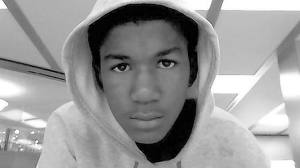 The debate will continue for many years. I am no expert. But I can weep over the death of a child and share the anguish of his parents. And I can resist the urge to think that the solution lies in individuals who work alone or in corporations that are too big to respond to local concerns. Jesus promises, “Where two or three are gathered in my name, I will be there among them.” In my neighborhood, I’d prefer that the watch members go out in groups of two or three.
The debate will continue for many years. I am no expert. But I can weep over the death of a child and share the anguish of his parents. And I can resist the urge to think that the solution lies in individuals who work alone or in corporations that are too big to respond to local concerns. Jesus promises, “Where two or three are gathered in my name, I will be there among them.” In my neighborhood, I’d prefer that the watch members go out in groups of two or three.
Come to think of it, perhaps we need a neighborhood watch that keeps our eyes on our legislators when they meet with lobbyists.
The real reason I haven’t said more, however, is beyond that. I simply do not know what happened. The facts are simple. Trayvon Martin is dead. He was 17 years old and unarmed. George Zimmerman, a neighborhood watch volunteer has admitted to shooting Trayvon. He said he acted in self-defense and that he should be immune from prosecution under Florida’s “Stand Your Ground” law. He has been charged with second-degree murder in the case.

Martin’s family find Zimmerman’s story to be unbelievable. So do many of the pundits. They think it is much more likely that Zimmerman followed Martin simply because he looked suspicious or somehow threatening, that he followed and pursued Martin and gunned him down.
I wasn’t there. I don’t know what happened. Trayvon Martin is not alive to tell his side of the story. A judge will have to determine if Zimmerman’s story is credible in order to act on a motion to dismiss the charges before the case is presented to the jury. If the case goes to the jury it means that the judge has rejected the self-defense argument, but it will be presented to the jury for them to decide.
There will be so much media coverage of the proceedings that it will be impossible to know what really happened. It may have always been impossible to know what happened. There is only one witness.
Neighborhood Watches are supposed to be just that: people who watch. They are supposed to use telephones to contact the police. Enforcement of laws is to be handled by professional law enforcement officers who are trained in the law, who work with partners, who have access to less lethal means. An armed Neighborhood Watch member who is quick on the trigger is dangerous and our society moves dangerously close to vigilantism in which people are killed without the benefit of trial or jury. I do not know the specifics of the Trayvon Martin case. I do know that when people “shoot first, ask questions later” innocents die.
Law enforcement officers make mistakes too. Innocents have died as the result of police action. Innocents have been convicted and in some cases executed by the justice system. Our system is not perfect.
Still I have a lot of respect for the training and professionalism of the law enforcement officers I have had the privilege of knowing. And I am well aware of how our local officers are trained to work as members of a team – providing not only safety and protection for each other, but also witnesses to their activities.
Here is something that is getting less attention in the rush to determine guilt or innocence on the part of George Zimmerman: “Stand Your Ground” laws are not the product of neighborhood watch organizations. They did not originate from law enforcement agencies as has been portrayed. These laws are not, in general, home grown laws proposed by local people to solve local problems. They are part of a well-organized lobbying effort. Like far too many laws these days, they are created well-funded special interest groups who have a lot of money to influence legislation. The largest promoter of “Stand Your Ground” laws is the American Legislative Exchange Council (ALEC). They receive lots of corporate funding and use their resources to promote legislation.
There is a direct relationship between the Supreme Court decision in the Citizens United v. Federal Election Commission case and what happened in Florida. Ruling that corporations are “citizens” and therefore cannot have restrictions placed on their political activities means that corporations will always have more power than individuals in legislative assemblies. They will always have more money and in an atmosphere where getting elected takes so much money, money always talks.
Corporations prefer to donate through nonprofit lobbying and political groups – many recently formed – that are not compelled to reveal their donors. And these well-funded groups write and promote specific legislation. We see it in our state all the time. Bills are presented in the legislature that have the exact same wording of bills that have been presented in other state legislative assemblies. In a state like South Dakota getting a law through the legislature is less expensive than other states. And once it passes here, our state’s adoption is used to convince other states to adopt similar legislation.
In the midst of this complex and highly funded arena, real people are affected. Trayvon Martin really is dead. He has left behind a grieving family who can’t answer the basic question: “Why?” It is likely that George Zimmerman’s life has also been forever ruined by the decision he made. Whatever else this case is, it is certainly a tragedy.
I share the ideological suspicion of big government. On the other hand, I am a firm believer in the necessity of good government. There are many tasks that require us to work together to accomplish the common good. When big business starts to yell that the government has grown too powerful, however, I think we need to listen carefully. If we remove the power of the government to limit the actions of huge corporations, we leave ourselves with corporations who have no limits on their power.

Come to think of it, perhaps we need a neighborhood watch that keeps our eyes on our legislators when they meet with lobbyists.
Copyright © 2012 by Ted Huffman. I wrote this. If you want to copy it, please ask for permission. There is a contact me button at the bottom of this page. If you want to share my blog a friend, please direct your friend to my web site.
Differing Abilities
12/04/12 05:43
I have been involved in the human rights process at Black Hills Workshop and Training Center for over a decade now. The work has been meaningful and I relish in the role of community representative. I am independent with respect to the Workshop. I receive no compensation or reimbursement from the Workshop and I am not subject to the control of the Board of Directors or the employees of the Workshop. My role is to represent the interests of the community. It is in the best interests of the community to have the human rights of all of its citizens protected. When one person loses freedom, all lose freedom. That is how it works.
There are some occasions when a temporary restriction of freedom is in the best interests of the person involved and the community. Perhaps some food restrictions are necessary in the treatment of an eating disorder. Perhaps increased sedation is required to safely complete a dental or medical procedure. Perhaps assistance with financial management means some funds are not as accessible for discretionary spending. We do place restrictions on the rights of other persons, and there are times when we believe that doing so is in their best interest. One of the things I do at the Workshop is to ask “Is this the least restrictive means available to address the situation?” Another question is, “What is the plan of restoration?” When human rights are suspended, there must be a plan for them to be restored. All suspensions of human rights must be temporary.
 One thing that I have learned is that it is not my job to speak for another person. When I first began the work, I thought that I might occasionally need to speak up for someone who could not speak for him or herself. After all, the Workshop provides services to those who are not able to speak. What I have learned is that no one needs another to speak for her or him. People need others to listen. And, when you learn to listen carefully, people are pretty good at expressing their wants and needs, hopes and fears, desires and aspirations – even when their method of communicating is not verbal.
One thing that I have learned is that it is not my job to speak for another person. When I first began the work, I thought that I might occasionally need to speak up for someone who could not speak for him or herself. After all, the Workshop provides services to those who are not able to speak. What I have learned is that no one needs another to speak for her or him. People need others to listen. And, when you learn to listen carefully, people are pretty good at expressing their wants and needs, hopes and fears, desires and aspirations – even when their method of communicating is not verbal.
I am learning that lesson in a new way this week. Ben Anderson is visiting our community. On Sunday he will be preaching at our church and helping us to take a look at widening our welcome. Our congregation has a long history of welcoming those with differing abilities. Back in 1959, long before the Americans with Disabilities Act, our congregation built a church that was accessible to those using wheelchairs. It was in part due to the simple fact that a major donor had a daughter with polio who used a wheelchair for mobility. Over the years we have learned to look for and reduce or eliminate barriers. That work is not complete. Just last Sunday a member of our congregation who uses a wheelchair had to go through a difficult process to sing in the choir because the choir sings in a loft that is not served by an elevator.
There are barriers, however, that are not physical. Far too often we make assumptions about the abilities and disabilities of others without really getting to know them. This is a place where Ben is an excellent teacher for me and for our congregation.
 Ben’s personal story is marked by the simple fact that he has Cerebral Palsy. As a child he had great difficulty learning to walk and to talk. His inability to communicate verbally combined with the lack of knowledge on the part of educators and health care professionals to have him labeled as a person with low intelligence. The label meant special schools and an educational program with lowered standards. Ben eventually earned a college degree with a good grade point average and demonstrated that he is an intelligent person. He formed his own non-profit corporation and earns his living by speaking and leading workshops all around the country.
Ben’s personal story is marked by the simple fact that he has Cerebral Palsy. As a child he had great difficulty learning to walk and to talk. His inability to communicate verbally combined with the lack of knowledge on the part of educators and health care professionals to have him labeled as a person with low intelligence. The label meant special schools and an educational program with lowered standards. Ben eventually earned a college degree with a good grade point average and demonstrated that he is an intelligent person. He formed his own non-profit corporation and earns his living by speaking and leading workshops all around the country.
One of the things that Ben teaches is the art of self-advocacy. People need to be equipped, enabled and empowered to speak for themselves. While a community that supports an individual is essential, there is no substitute for self-advocacy. Each individual knows best what her or his dreams and aspirations are. That individual needs to be given the tools to express those aspirations while at the same time the wider community needs to develop better listening skills.
It is a simple fact that each of us is only one accident or illness away from a disability. A friend of mine in Idaho refers to people like me as “temporarily-abled.” I think of it a bit differently. Each person has things that are challenging. There are things we can do and things we cannot do. We all have certain disabilities. I could never earn my living playing basketball or swinging a golf club. I am awkward at sports. The question is: “Will I define myself by the things I cannot do or by the things I can do?”
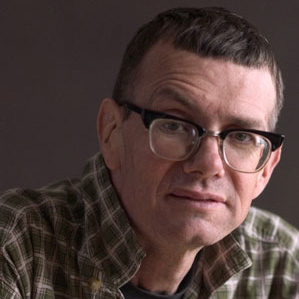 Kevin Kling points out that being able-bodied is always only a temporary condition. Mr. Kling was born with a birth defect – his left arm is disabled and much shorter than his right. Then, in his early 40’s, a motorcycle accident nearly killed him and paralyzed his healthy right arm. His talented storytelling is often a part of NPR radio broadcasts. His book, “The Dog Says How” is a delightful and humorous invitation for all of us to face our own abilities and disabilities.
Kevin Kling points out that being able-bodied is always only a temporary condition. Mr. Kling was born with a birth defect – his left arm is disabled and much shorter than his right. Then, in his early 40’s, a motorcycle accident nearly killed him and paralyzed his healthy right arm. His talented storytelling is often a part of NPR radio broadcasts. His book, “The Dog Says How” is a delightful and humorous invitation for all of us to face our own abilities and disabilities.
It seems to be the challenge of every generation to learn to live with differences. Sometimes our differences make us uncomfortable. We worry about doing or saying the wrong thing. We have a tendency to pursue conversations with those with whom we have much in common. The church, however, calls us into community with people who are not the same. In our differences we discover the universality of the Gospel. Jesus is savior of the whole world, not just the savior of those who are like me.
It is clear that we all have much to learn. And these lessons will have a big pay off as we age, for we each will develop our own disabilities as a natural part of growing older.
There are some occasions when a temporary restriction of freedom is in the best interests of the person involved and the community. Perhaps some food restrictions are necessary in the treatment of an eating disorder. Perhaps increased sedation is required to safely complete a dental or medical procedure. Perhaps assistance with financial management means some funds are not as accessible for discretionary spending. We do place restrictions on the rights of other persons, and there are times when we believe that doing so is in their best interest. One of the things I do at the Workshop is to ask “Is this the least restrictive means available to address the situation?” Another question is, “What is the plan of restoration?” When human rights are suspended, there must be a plan for them to be restored. All suspensions of human rights must be temporary.

I am learning that lesson in a new way this week. Ben Anderson is visiting our community. On Sunday he will be preaching at our church and helping us to take a look at widening our welcome. Our congregation has a long history of welcoming those with differing abilities. Back in 1959, long before the Americans with Disabilities Act, our congregation built a church that was accessible to those using wheelchairs. It was in part due to the simple fact that a major donor had a daughter with polio who used a wheelchair for mobility. Over the years we have learned to look for and reduce or eliminate barriers. That work is not complete. Just last Sunday a member of our congregation who uses a wheelchair had to go through a difficult process to sing in the choir because the choir sings in a loft that is not served by an elevator.
There are barriers, however, that are not physical. Far too often we make assumptions about the abilities and disabilities of others without really getting to know them. This is a place where Ben is an excellent teacher for me and for our congregation.

One of the things that Ben teaches is the art of self-advocacy. People need to be equipped, enabled and empowered to speak for themselves. While a community that supports an individual is essential, there is no substitute for self-advocacy. Each individual knows best what her or his dreams and aspirations are. That individual needs to be given the tools to express those aspirations while at the same time the wider community needs to develop better listening skills.
It is a simple fact that each of us is only one accident or illness away from a disability. A friend of mine in Idaho refers to people like me as “temporarily-abled.” I think of it a bit differently. Each person has things that are challenging. There are things we can do and things we cannot do. We all have certain disabilities. I could never earn my living playing basketball or swinging a golf club. I am awkward at sports. The question is: “Will I define myself by the things I cannot do or by the things I can do?”

It seems to be the challenge of every generation to learn to live with differences. Sometimes our differences make us uncomfortable. We worry about doing or saying the wrong thing. We have a tendency to pursue conversations with those with whom we have much in common. The church, however, calls us into community with people who are not the same. In our differences we discover the universality of the Gospel. Jesus is savior of the whole world, not just the savior of those who are like me.
It is clear that we all have much to learn. And these lessons will have a big pay off as we age, for we each will develop our own disabilities as a natural part of growing older.
Copyright © 2012 by Ted Huffman. I wrote this. If you want to copy it, please ask for permission. There is a contact me button at the bottom of this page. If you want to share my blog a friend, please direct your friend to my web site.
A journey and a discipline
11/04/12 05:31

Life has many journeys and some roads are longer than others. In January, I started on a journey that I have, so far, hesitated to write about in the blog. And, quite frankly, it is not one that I plan to make a regular topic for this forum. If I were to write only about myself, this blog would quickly become boring. I prefer to write my daily blog about other things. On the other hand, the general topic of the blog is life as a pastor and so my personal experiences are always a part of my writing. So I will indulge in a bit of self-reflection today and move on to other topics in days to come.
One of the journeys of my life right now is a serious plan of losing weight. Like a lot of middle-aged men who have rather sedentary jobs, I have been putting on weight, little by little, for most of my adult life. I have not experienced any serious health consequences as a result of my overeating and under exercising, but I had put on enough pounds that I was not too happy with my appearance. And I had read enough to know that being overweight is probably the biggest health risk that I can control.
I’ve been on a few diets in the past. I know that I can lose a bit of weight in the short run. But this time I wanted something seriously different. I wanted to change my entire lifestyle so that the weight would stay off. I also know that there are things that work for others that do not work for me. There is absolutely nothing wrong with health clubs, but that just doesn’t work for me. I’m not a fan of public dressing rooms and showers and I certainly don’t like to do my exercising in public. Exercise machines such as stationary bikes, treadmills and stair machines strike me as a kind of “gerbil” activity. I have too much to do to spend my time running around. If I need to go up stairs, there are ten floors in the hospital that I visit multiple times each week. If I’m going to ride a bicycle, there are miles and miles of beautiful trails in the hills. If I’m going to go for a walk or a run, I’d prefer to do so outside. The other challenge for me with health club style exercising is that television seems to be a big part of the experience. I was a member of the local YMCA for several years. I enjoyed swimming, but couldn’t maintain a regular discipline with the cardio machines in part because there were always televisions blaring in the room with the machines. I am just not a fan of watching television.
So I had lots of reasons why I didn’t want to follow the route that had been successful for others, but I needed a plan that I could maintain over the long run. And, for the plan to work for me, I needed to see it as a spiritual discipline. Lent is the perfect season for fasting and paying attention to food.
Before my plan was developed, I received the gift of a starting point. In January, a routine blood test when donating platelets referred me to my doctor for a follow-up test. It was time for a wellness checkup as well. Before I got to my doctor, I underwent a bit of minor dental surgery. The oral surgeon put me on a liquid diet for a week and then extended it for a second week as I healed. I lost seven pounds in the two-week time frame. My visit to the doctor revealed that there was no problem, so the visit was a time for a general wellness check and a conversation about my weight and my general health. A plan was beginning to be put in place.
I started by addressing snacking and portion size. I didn’t stop snacking. I simply allowed myself only fresh fruit and vegetables for my snacks. And I did start to cut back on snacks. I began to fill my plate carefully at each meal and stop eating when I finished the portion on the plate.
As I continued to be successful with weight loss, I decided that I needed additional strategies. I used the information I had gained in helping mother live with diabetes to pay attention to the balance of carbohydrates, proteins and fats in my diet. Being an inveterate diarist, I started to log my eating and my weight.
The journey has not been steady. There have been plateaus when I am the same weight for days without any loss. There have been a few times when I gained weight in the short term. But the general trend has been pretty good.
I decided that since my plan is about long-term lifestyle changes, I would lose the weight over an 18-month period. That would result in the loss being slow enough that there would be virtually no need to change anything to stop it when I reached my target weight. I also knew that for me certain things that to be a part of my plan. I needed to have a plan that allowed me to share meals with friends, continue cooking and barbecue, and have special treats. I have no intention of giving up an occasional trip to the ice cream store or baking cookies at holidays.
I began exercise slowly, starting with back exercises that I learned when taking physical therapy after an injury. I added walking and biking to my routine. I log my exercise along with my weight and eating. In order to sustain the exercise, I probably can only devote a half hour a day to the process. So I have also added things like parking at the edge of the lot, using stairs instead of elevators and other exercise into my daily routine.
Here is the report so far. I’m three months into the adventure. I’ve lost 23 pounds. My waist size is down three inches and my neck size down one. My goal is to lose another 50 pounds. With 15 months left to go that is about ¾ of a pound a week. I know my loss will plateau, but I don’t need to become worried when it does because I don’t need to lose weight rapidly.
It is a long journey, but like prayer and other spiritual disciplines, it becomes easier with practice. And practice is what I need at this point.
Don’t expect to be reading about this topic in this blog over the next year and a half. On the other hand, I’ll probably make a note when I reach my goals.
Copyright © 2012 by Ted Huffman. I wrote this. If you want to copy it, please ask for permission. There is a contact me button at the bottom of this page. If you want to share my blog a friend, please direct your friend to my web site.
Watching the Weather
10/04/12 05:40
I’ve read quite a few articles. I am no scientist, but I have a rough understanding of the ozone depletion that has been occurring since the late 1970’s. And I have some concept of greenhouse gases and their effect on the temperature of the Earth. I know a little bit about air currents and storm fronts. I’ve read about the jet stream. But I am a long way from really understanding the weather.
 What I do know is that we have had a much milder than usual winter. We didn’t have much snow and the cold days were fewer and farther between than I can remember. The hills are tinder dry. I snuck out for a bike ride on the Mickelson Trail yesterday. It was a very pleasant journey, but the hills are dusty and dry. I know that a spring blizzard is still a possibility, but it really doesn’t seem likely. It is 36 degrees out there this morning. Although there was frost forecast for other parts of the state, here in the hills, new plants would have survived outside last night. I don’t have my garden planted, and I know it is too soon, but It is starting to feel like the days are wasting and spring is here. The flowering trees are all blooming. Other trees are green with new leaves.
What I do know is that we have had a much milder than usual winter. We didn’t have much snow and the cold days were fewer and farther between than I can remember. The hills are tinder dry. I snuck out for a bike ride on the Mickelson Trail yesterday. It was a very pleasant journey, but the hills are dusty and dry. I know that a spring blizzard is still a possibility, but it really doesn’t seem likely. It is 36 degrees out there this morning. Although there was frost forecast for other parts of the state, here in the hills, new plants would have survived outside last night. I don’t have my garden planted, and I know it is too soon, but It is starting to feel like the days are wasting and spring is here. The flowering trees are all blooming. Other trees are green with new leaves.
 An unusually mild springtime is a bit difficult to boat about when my friends in Australia are experiencing an unusually cold autumn. OK it is Australia, so things there aren’t as cold or as wintry as we have seen some years around here. But they don’t expect it to be cold there. No small number of Australians have English heritage – they think that England is cold. Average temperatures this time of year are in the low seventies in Sydney and high sixties in Melbourne. Even in Hobart, at the southern end of Tasmania where it gets pretty cold, average temperatures are still in the 6o’s this time of the year. (OK high teens, they use Celsius down there, but I’ve translated temperatures to Fahrenheit to make comparisons.) Today in Melbourne, it was down to the forties. That’s single digits in Celsius and enough to make the Aussies put on extra layers.
An unusually mild springtime is a bit difficult to boat about when my friends in Australia are experiencing an unusually cold autumn. OK it is Australia, so things there aren’t as cold or as wintry as we have seen some years around here. But they don’t expect it to be cold there. No small number of Australians have English heritage – they think that England is cold. Average temperatures this time of year are in the low seventies in Sydney and high sixties in Melbourne. Even in Hobart, at the southern end of Tasmania where it gets pretty cold, average temperatures are still in the 6o’s this time of the year. (OK high teens, they use Celsius down there, but I’ve translated temperatures to Fahrenheit to make comparisons.) Today in Melbourne, it was down to the forties. That’s single digits in Celsius and enough to make the Aussies put on extra layers.
In Canberra, the seat of the federal government, it was down to 33 degrees. In Celsius the 0 point is the freezing point of water, so below zero temperatures don’t feel like they do here. Still there were plenty of minus temperatures in the hills. The Snowy Mountains lived up to their name. They probably aren’t upset at Perisher, the largest ski resort in Australia, where they got one of the earliest first snows on record.
 With the cold southwesterly winds and frequent showers across Australia they are off to an early start on winter.
With the cold southwesterly winds and frequent showers across Australia they are off to an early start on winter.
One thing about the weather: it is bound to change.
Our unusually mild winter came after two in a row that had more moisture than usual. It is hard to remember that it was just a year ago that we were worried about excessive snowpack in the Rockies and the Missouri River was filling up all of the reservoirs and rising above flood stage. Folks in Australia have had a few damp years, but it wasn’t that long ago that folks in the hills north of Melbourne were fleeing fires that were raging in tinder dry conditions in the midst of record-breaking heat.
There is enough news in the weather to support a full-time cable television show. We don’t have cable at our home, but I’ve noticed that the nursing homes, where they used to run the weather channel on the televisions all the time have changed their favorite channel. I rarely find a TV in a nursing home tuned to the weather channel these days. Maybe they have discovered that continual coverage of disastrous weather is affecting the mood of residents.
The truth is that we cannot control the weather. Despite some experiments with cloud seeding and other weather modification techniques, scientists are a long way from being able to have a significant impact on the weather. The weather is more influenced by the inadvertent side effects of our behavior than by direct actions intended to change the weather. We’ve pretty much got to take what comes for the foreseeable future.
I’m OK with that. I don’t need to be able to manipulate the weather. When people ask me to pray for rain, I tell them that I’m pretty good at making requests, but I don’t have a good track record when it comes to results. I don’t believe in a god who manipulates the laws of physics for the convenience of people. It’s not that I don’t believe in miracles. It’s just that I don’t think we can manipulate them. And, as I said before, I am comfortable with the world being this way. There are far too many possible unforeseen consequences from the weather to trust it to someone like me who is usually paying attention to just the small area where I live and travel.
So it is day and warm around here. I wouldn’t mind a little of the snow that they got in Australia. I’d even take some of the extra snow that they got in the North Country this year. On the other hand, they got less snow during the previous two winters when we had more, so they may not be as eager to share as they once were.
I’m actually enjoying reading about the “cold” temperatures in Australia. Bottom line: it’s not very cold there. The people there are complaining about temperatures and conditions that wouldn’t faze us. A chilly day where I’d head to work with frost on the ground would feel perfectly normal to me. A light dusting of snow that would melt off by noon would be welcome. The only reason they’re complaining is that they aren’t used to it.
I grew up in Montana and spent seven winters in North Dakota. Those folks in Australia don’t know what cold is.


In Canberra, the seat of the federal government, it was down to 33 degrees. In Celsius the 0 point is the freezing point of water, so below zero temperatures don’t feel like they do here. Still there were plenty of minus temperatures in the hills. The Snowy Mountains lived up to their name. They probably aren’t upset at Perisher, the largest ski resort in Australia, where they got one of the earliest first snows on record.

One thing about the weather: it is bound to change.
Our unusually mild winter came after two in a row that had more moisture than usual. It is hard to remember that it was just a year ago that we were worried about excessive snowpack in the Rockies and the Missouri River was filling up all of the reservoirs and rising above flood stage. Folks in Australia have had a few damp years, but it wasn’t that long ago that folks in the hills north of Melbourne were fleeing fires that were raging in tinder dry conditions in the midst of record-breaking heat.
There is enough news in the weather to support a full-time cable television show. We don’t have cable at our home, but I’ve noticed that the nursing homes, where they used to run the weather channel on the televisions all the time have changed their favorite channel. I rarely find a TV in a nursing home tuned to the weather channel these days. Maybe they have discovered that continual coverage of disastrous weather is affecting the mood of residents.
The truth is that we cannot control the weather. Despite some experiments with cloud seeding and other weather modification techniques, scientists are a long way from being able to have a significant impact on the weather. The weather is more influenced by the inadvertent side effects of our behavior than by direct actions intended to change the weather. We’ve pretty much got to take what comes for the foreseeable future.
I’m OK with that. I don’t need to be able to manipulate the weather. When people ask me to pray for rain, I tell them that I’m pretty good at making requests, but I don’t have a good track record when it comes to results. I don’t believe in a god who manipulates the laws of physics for the convenience of people. It’s not that I don’t believe in miracles. It’s just that I don’t think we can manipulate them. And, as I said before, I am comfortable with the world being this way. There are far too many possible unforeseen consequences from the weather to trust it to someone like me who is usually paying attention to just the small area where I live and travel.
So it is day and warm around here. I wouldn’t mind a little of the snow that they got in Australia. I’d even take some of the extra snow that they got in the North Country this year. On the other hand, they got less snow during the previous two winters when we had more, so they may not be as eager to share as they once were.
I’m actually enjoying reading about the “cold” temperatures in Australia. Bottom line: it’s not very cold there. The people there are complaining about temperatures and conditions that wouldn’t faze us. A chilly day where I’d head to work with frost on the ground would feel perfectly normal to me. A light dusting of snow that would melt off by noon would be welcome. The only reason they’re complaining is that they aren’t used to it.
I grew up in Montana and spent seven winters in North Dakota. Those folks in Australia don’t know what cold is.
Copyright © 2012 by Ted Huffman. I wrote this. If you want to copy it, please ask for permission. There is a contact me button at the bottom of this page. If you want to share my blog a friend, please direct your friend to my web site.
Urban Chickens
09/04/12 04:05
I think that the debate may have simmered down for a while. At least we haven’t seen another proposed ordinance brought before the city council. Last year, proposed ordinance 5714 failed to garner enough votes to pass. So, for now, chickens are banned from most backyards in the city. It isn’t that we don’t allow any livestock. Like most cities, dogs and cats are OK, an occasional rabbit or snake is found along with gerbils, hamsters and a variety of pet mice and rats. And you can raise chickens in our town, providing that you have at least 3 acres of land and that you keep your chickens at least 150 feet way from any buildings occupied by humans. That’s about half a block. Most homes in Rapid City don’t have enough space to legally raise chickens.
Of course there are still a few cows in town. The city grew up around a few existing ranches and their critters are “grandfathered” into the ordinances.
But chickens apparently pose some kind of threat to neighborliness and therefore are, for now, banned from Rapid City. I’m not sure if it was the fear of roosters or the fear of the smell of chicken coops that prompted the opposition. The proposed ordinance that did not pass put rather strict rules on those items, banning roosters and requiring the daily removal of droppings into a fireproof container.
 I guess they hadn’t seen the fancy chicken coops that they have for sale at the new Runnings store. I was worried, recently, when the feed store that is closest to our home decided that they needed a bigger building. My first away from home job was sweeping the feed warehouse. I like shopping in a store that smells like a feed warehouse. I was afraid that the new bigger, bolder, better store would be too big to smell like a feed warehouse. It really is. They have more clothes than you can shake a stick at. And they’ve got a tool section that rivals the hardware store. And the sports and camping equipment makes you think you’re in a different store. But back in the corner they’ve still got feed. And it smells like feed. And they’ve got the chickens. So all is well.
I guess they hadn’t seen the fancy chicken coops that they have for sale at the new Runnings store. I was worried, recently, when the feed store that is closest to our home decided that they needed a bigger building. My first away from home job was sweeping the feed warehouse. I like shopping in a store that smells like a feed warehouse. I was afraid that the new bigger, bolder, better store would be too big to smell like a feed warehouse. It really is. They have more clothes than you can shake a stick at. And they’ve got a tool section that rivals the hardware store. And the sports and camping equipment makes you think you’re in a different store. But back in the corner they’ve still got feed. And it smells like feed. And they’ve got the chickens. So all is well.
Urban chickens are quite the rage in a lot of cities. Sioux Falls, the largest city in South Dakota allows them. They haven’t had any problems. You can raise chickens in your back yard in Fort Collins, CO; Laramie, WY; and Missoula, MT; but not in Rapid City.
 Let’s be straight about one thing. I don’t want to raise chickens. Been there – done that. My dad was a kind of frustrated farm kid. He never earned his living from farming, but he had grown up on a farm and he had a soft spot in his heart for critters. So we had donkeys and we raised chickens in the summer. We didn’t go in for the eggs – though anybody who has ever eaten a fresh egg knows that they are far preferable to anything that you can get at the grocery store. We raised fryers. Which meant that in the fall they had to be butchered and have the feathers removed. I don’t need to go into details here, but it involves a smell that you never forget and, after you have butchered enough chickens, you lose your desire to be a chicken farmer.
Let’s be straight about one thing. I don’t want to raise chickens. Been there – done that. My dad was a kind of frustrated farm kid. He never earned his living from farming, but he had grown up on a farm and he had a soft spot in his heart for critters. So we had donkeys and we raised chickens in the summer. We didn’t go in for the eggs – though anybody who has ever eaten a fresh egg knows that they are far preferable to anything that you can get at the grocery store. We raised fryers. Which meant that in the fall they had to be butchered and have the feathers removed. I don’t need to go into details here, but it involves a smell that you never forget and, after you have butchered enough chickens, you lose your desire to be a chicken farmer.
We didn’t have a fancy chicken coop. We had an old shed, about 10 feet by 10 feet, with a leaky roof. We hauled in some straw and fixed up a few places for the chickens. Feeding chickens is easy. You just throw the feed on the ground and let them pick it up. Water is really important, especially for young chickens. They aren’t the best housekeepers; so keeping the water clean requires frequent changing. And little chicks are prone to all sorts of diseases, so clean water is a must. Cleaning the coop involves using a fork to remove the straw and putting down fresh straw. In the fall, you clean out what is left and allow the remains to dry over the winter before using a shovel to make the final cleaning. There is a little aroma, but nothing compared to the odor of removing feathers.
Still, I have no desire to raise chickens.
I am amazed at the fancy chicken coops that they sell at the store, however. And I do like this time of the year when the feed store is filled with chicks. And I am impressed with those fancy chicken coops they are selling at the store.
More importantly, I really don’t care if my neighbors want to raise chickens. I think having a neighbor with about six hens would be perfect. They would fall in love with their hens and pamper them and buy good feed for them and they would find that six eggs a day is more than they could eat. Being next door, I would graciously offer to buy the extra eggs and we would all be happy. Actually, I don’t care if they got a rooster. I’m an early morning person anyway and if the rooster got too annoying, I could always close the window. Our neighbors aren’t all that close anyway.
But you can’t raise chickens in town.
Actually, that’s not what has gotten me worried. What I’ve been wondering about is if they make the logical extension from chickens to other fowl. What if in addition to not allowing chickens the city council puts a ban on pigeons or turkeys? We seem to have an abundance of both kinds of birds hanging out at the church. They sometimes sleep on the roof and they love the crab apples in the fall. They make a daily run though the place and the back yard is a great space for the Toms to strut their stuff – they are really full of themselves this time of year.

We’d really be in trouble if the City Council banned turkeys. On the other hand, I’m not sure I want to make them legal, either. Imagine if I had to clean up after those turkeys every day. I might get to the point where I didn’t want to raise them either.
Of course there are still a few cows in town. The city grew up around a few existing ranches and their critters are “grandfathered” into the ordinances.
But chickens apparently pose some kind of threat to neighborliness and therefore are, for now, banned from Rapid City. I’m not sure if it was the fear of roosters or the fear of the smell of chicken coops that prompted the opposition. The proposed ordinance that did not pass put rather strict rules on those items, banning roosters and requiring the daily removal of droppings into a fireproof container.

Urban chickens are quite the rage in a lot of cities. Sioux Falls, the largest city in South Dakota allows them. They haven’t had any problems. You can raise chickens in your back yard in Fort Collins, CO; Laramie, WY; and Missoula, MT; but not in Rapid City.

We didn’t have a fancy chicken coop. We had an old shed, about 10 feet by 10 feet, with a leaky roof. We hauled in some straw and fixed up a few places for the chickens. Feeding chickens is easy. You just throw the feed on the ground and let them pick it up. Water is really important, especially for young chickens. They aren’t the best housekeepers; so keeping the water clean requires frequent changing. And little chicks are prone to all sorts of diseases, so clean water is a must. Cleaning the coop involves using a fork to remove the straw and putting down fresh straw. In the fall, you clean out what is left and allow the remains to dry over the winter before using a shovel to make the final cleaning. There is a little aroma, but nothing compared to the odor of removing feathers.
Still, I have no desire to raise chickens.
I am amazed at the fancy chicken coops that they sell at the store, however. And I do like this time of the year when the feed store is filled with chicks. And I am impressed with those fancy chicken coops they are selling at the store.
More importantly, I really don’t care if my neighbors want to raise chickens. I think having a neighbor with about six hens would be perfect. They would fall in love with their hens and pamper them and buy good feed for them and they would find that six eggs a day is more than they could eat. Being next door, I would graciously offer to buy the extra eggs and we would all be happy. Actually, I don’t care if they got a rooster. I’m an early morning person anyway and if the rooster got too annoying, I could always close the window. Our neighbors aren’t all that close anyway.
But you can’t raise chickens in town.
Actually, that’s not what has gotten me worried. What I’ve been wondering about is if they make the logical extension from chickens to other fowl. What if in addition to not allowing chickens the city council puts a ban on pigeons or turkeys? We seem to have an abundance of both kinds of birds hanging out at the church. They sometimes sleep on the roof and they love the crab apples in the fall. They make a daily run though the place and the back yard is a great space for the Toms to strut their stuff – they are really full of themselves this time of year.

We’d really be in trouble if the City Council banned turkeys. On the other hand, I’m not sure I want to make them legal, either. Imagine if I had to clean up after those turkeys every day. I might get to the point where I didn’t want to raise them either.
Copyright © 2012 by Ted Huffman. I wrote this. If you want to copy it, please ask for permission. There is a contact me button at the bottom of this page. If you want to share my blog a friend, please direct your friend to my web site.
Easter 2012
08/04/12 03:45
I have been reading Carl Sagan again. I am attracted to some of the contemporary cosmologists. There is something amazingly ambitious about someone who attempts to write about the universe as a whole. I struggle to understand just one small corner of the universe. But a cosmologist attempts to understand the universe, what it is, how it came to be, what are the laws that keep it in order, and what its future may be. That is a cosmologist tries to explain everything.
In contemporary times, most, but not all, cosmologists come from observational astronomy and theoretical physics. This is a relatively recent phenomenon. Historically, cosmology was the territory of theology and philosophy. The practice of metaphysics has its roots not in traditional scientific physics, but rather in philosophy. It involves speculation about that which is beyond physics – the study of things that cannot be directly observed.
 The advances of modern science have moved the study of physics beyond observation to speculation about realities which can be discerned through the application of advanced mathematics, but which cannot be directly seen. Theoretical physics seeks to explain observed reality, but often posits the possibility of that which cannot be observed in order to explain phenomena that can be observed.
The advances of modern science have moved the study of physics beyond observation to speculation about realities which can be discerned through the application of advanced mathematics, but which cannot be directly seen. Theoretical physics seeks to explain observed reality, but often posits the possibility of that which cannot be observed in order to explain phenomena that can be observed.
The basic questions of metaphysics are those of cosmologists as well: “What is there?” and “What is it like?”
It has become popular for contemporary cosmologists to criticize religion – or at least the historical cosmologies posited by religious thinkers in past generations. I am not sure why certain scientists seem to think that while science continues to make new discoveries and push the frontiers of knowledge, religion must have remained static in its thinking. Not only do most scientific cosmologies read as if the writers are unaware of the history of philosophy. Too many of them read as if religion stopped growing and developing as soon as the scientific method was discovered.
Easter teaches us a new reality.
God hasn’t stopped bringing new life to this universe. The images of the nature of the cosmos that were possessed by the ancients were but a small fraction of the glory of God. The vast distances that we estimate and about which we speculate are only a fraction of the reality that lies far beyond what we are able to imagine. Scientists are beginning to discover that the universe is far vaster than previously imagined. In fact, it appears likely that there is more than a single universe. It boggles our minds. We realize that our ability to perceive is indeed limited.
I won’t be writing a cosmology.
 I am positive that I am unable to comprehend the vastness of the universe. I am sure that I am not capable of pulling everything together into one united and consistent organizational scheme. In his book, Pale Blue Dot, Sagen rightly points to the arrogance of imagining that we are at the center of the universe. It seems like a silly assertion to be made in the opening chapters of a book that purports to explain the entire universe. While he understands that we are not at the center, he writes as if he had the perspective to describe all that is.
I am positive that I am unable to comprehend the vastness of the universe. I am sure that I am not capable of pulling everything together into one united and consistent organizational scheme. In his book, Pale Blue Dot, Sagen rightly points to the arrogance of imagining that we are at the center of the universe. It seems like a silly assertion to be made in the opening chapters of a book that purports to explain the entire universe. While he understands that we are not at the center, he writes as if he had the perspective to describe all that is.
Easter proclaims that there is much that we do not understand. Love is stronger than death. God is greater than anything that we can imagine. We do not have to understand all that is. Whatever we can imagine, there is more to the story. Just when we think we have discovered the end, there is more . . . much, much more.
It is true that there have been religious leaders who want to put a cap on knowledge – who claim to understand all that needs to be known. There are Biblical literalists who think that their interpretation of scripture contains all of the truth of God. These may be people of great faith, but their view of God is narrow. They understand only part of the truth. To claim, “God said it, I believe it and that does it,” is to imagine a God who is not longer speaking. The God of the universe and beyond, however, continues to be involved in all that is.
One small area of God’s concern is human life. In the vastness of the great distances of the universe, God chose to live one live in the midst of the people of one planet. On our earth, God came to us in Jesus Christ and shared our life – all of our life: the worries, the pain, the troubles, the injustices and death itself. This is not the only act of God. We may not be the only arena of God’s love and concern. But we proclaim a God who is as vast as the entire universe and beyond and yet who loves the creatures of this planet. And through Jesus God has demonstrated that the very moment that we perceive as the end is nowhere near the end. Death is not the final word on the meaning of human life.
I probably am not able to explain resurrection to the scientific cosmologists. I might not even be able to explain love to them. But even the most atheistic of scientists can become swept up on awe and wonder. Even the most cynical can admit that there is much that is unknown and much yet to be discovered.
 The greatest cosmology written by any human is the dimmest reflection of the truth. We are not able to take in all of the wonder and glory of creation. But that will not stop us from trying. Philosophy and cosmology will continue to grow and expand and science will continue to posit new theories and make new discoveries. And just when they think they have made the great breakthrough that explains everything, they will once again discover how little we can see, how little we can understand, how little we can know.
The greatest cosmology written by any human is the dimmest reflection of the truth. We are not able to take in all of the wonder and glory of creation. But that will not stop us from trying. Philosophy and cosmology will continue to grow and expand and science will continue to posit new theories and make new discoveries. And just when they think they have made the great breakthrough that explains everything, they will once again discover how little we can see, how little we can understand, how little we can know.
God is like that. The astonishment of those first witnesses expecting to find a body in a tomb continues to amaze us. We don’t understand it. What we do know is that there is yet much more for us to learn and discover about God.
Blessed Easter!
In contemporary times, most, but not all, cosmologists come from observational astronomy and theoretical physics. This is a relatively recent phenomenon. Historically, cosmology was the territory of theology and philosophy. The practice of metaphysics has its roots not in traditional scientific physics, but rather in philosophy. It involves speculation about that which is beyond physics – the study of things that cannot be directly observed.

The basic questions of metaphysics are those of cosmologists as well: “What is there?” and “What is it like?”
It has become popular for contemporary cosmologists to criticize religion – or at least the historical cosmologies posited by religious thinkers in past generations. I am not sure why certain scientists seem to think that while science continues to make new discoveries and push the frontiers of knowledge, religion must have remained static in its thinking. Not only do most scientific cosmologies read as if the writers are unaware of the history of philosophy. Too many of them read as if religion stopped growing and developing as soon as the scientific method was discovered.
Easter teaches us a new reality.
God hasn’t stopped bringing new life to this universe. The images of the nature of the cosmos that were possessed by the ancients were but a small fraction of the glory of God. The vast distances that we estimate and about which we speculate are only a fraction of the reality that lies far beyond what we are able to imagine. Scientists are beginning to discover that the universe is far vaster than previously imagined. In fact, it appears likely that there is more than a single universe. It boggles our minds. We realize that our ability to perceive is indeed limited.
I won’t be writing a cosmology.

Easter proclaims that there is much that we do not understand. Love is stronger than death. God is greater than anything that we can imagine. We do not have to understand all that is. Whatever we can imagine, there is more to the story. Just when we think we have discovered the end, there is more . . . much, much more.
It is true that there have been religious leaders who want to put a cap on knowledge – who claim to understand all that needs to be known. There are Biblical literalists who think that their interpretation of scripture contains all of the truth of God. These may be people of great faith, but their view of God is narrow. They understand only part of the truth. To claim, “God said it, I believe it and that does it,” is to imagine a God who is not longer speaking. The God of the universe and beyond, however, continues to be involved in all that is.
One small area of God’s concern is human life. In the vastness of the great distances of the universe, God chose to live one live in the midst of the people of one planet. On our earth, God came to us in Jesus Christ and shared our life – all of our life: the worries, the pain, the troubles, the injustices and death itself. This is not the only act of God. We may not be the only arena of God’s love and concern. But we proclaim a God who is as vast as the entire universe and beyond and yet who loves the creatures of this planet. And through Jesus God has demonstrated that the very moment that we perceive as the end is nowhere near the end. Death is not the final word on the meaning of human life.
I probably am not able to explain resurrection to the scientific cosmologists. I might not even be able to explain love to them. But even the most atheistic of scientists can become swept up on awe and wonder. Even the most cynical can admit that there is much that is unknown and much yet to be discovered.

God is like that. The astonishment of those first witnesses expecting to find a body in a tomb continues to amaze us. We don’t understand it. What we do know is that there is yet much more for us to learn and discover about God.
Blessed Easter!
Copyright © 2012 by Ted Huffman. I wrote this. If you want to copy it, please ask for permission. There is a contact me button at the bottom of this page. If you want to share my blog a friend, please direct your friend to my web site.
Holy Vigil
07/04/12 05:07
The Protestant Reformation brought many good things to the church. The vision of a church that was organized by a different principle than a rigid hierarchy with “top-down” lines of authority gave rise to new possibilities for ministry and mission. Rejection of the centralization of wealth and power within the institution of the church helped Christian congregations to capture a prophetic vision of service to those marginalized by social and political structures. Loosening the tight control on who could and who could not become a minister invited new and creative leaders into the church.
 I have always been a protestant. I do not expect to ever not be one. However, I have deep appreciation and respect for our Roman Catholic sisters and brothers. The reformation was, in my opinion, necessary and important, but there is also grief and loss in such a division within the church. One of the losses has been the rejection of certain elements of traditional liturgy. It was necessary for the reformers to focus on ministry rather than ceremony. The church had been corrupted by lavish and expensive events that distorted financial priorities and made a big show of religion at the expense of those most in need. The reformers, for a while, moved a long ways in the opposite direction, rejecting vestments, special vessels and even banning musical instruments from services of worship.
I have always been a protestant. I do not expect to ever not be one. However, I have deep appreciation and respect for our Roman Catholic sisters and brothers. The reformation was, in my opinion, necessary and important, but there is also grief and loss in such a division within the church. One of the losses has been the rejection of certain elements of traditional liturgy. It was necessary for the reformers to focus on ministry rather than ceremony. The church had been corrupted by lavish and expensive events that distorted financial priorities and made a big show of religion at the expense of those most in need. The reformers, for a while, moved a long ways in the opposite direction, rejecting vestments, special vessels and even banning musical instruments from services of worship.
As the years have passed since the Reformation, elements of traditional liturgy have begun to be embraced by Protestant congregations. As one would expect, there is a wide range of variation of liturgies embraced by different congregations. This rich diversity adds to the joy of maintaining connections with other congregations.
The dynamics of the separation of the Anglican Communion from the Roman Catholic Church were slightly different than other expressions of the Protestant Reformation. For the most part, Anglican congregations did not reject the organizational structure or the liturgies of the Roman Church except for the centralized authority of the Vatican. This means that the Anglican Communion, expressed in the United States in the Episcopal Church, has been the keeper of certain traditions within the community of Protestant Churches. The rich tradition of carefully crafted language for the liturgies, the keeping of an orderly book of common prayer, and the observation of the rites and rituals of the church provide a delightful expression of faith.
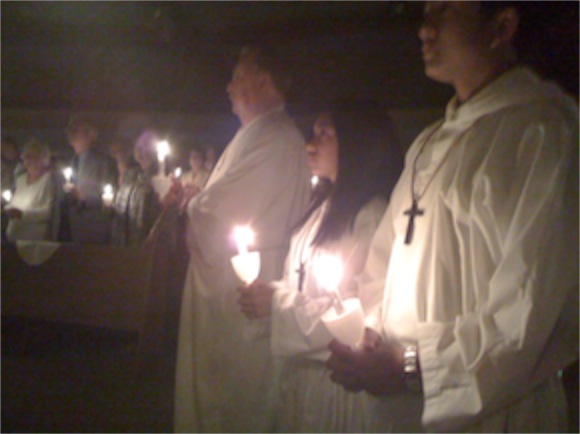 Worship in the United Church of Christ, my home, is often different. But I do enjoy, on occasion, attending an Episcopal congregation and listening to the traditional words that carry a connection with our history. In recent years, I can often be found at a local Episcopal congregation for the Easter Vigil service. Easter Vigil is the first service of the new season after Lent has passed with the Good Friday liturgy. The liturgy begins with a service of light. The sanctuary is dark, with no lights and the service begins outside of the church with a new fire lighted and blessed. A Paschal Candle is lighted from the fire and the procession towards the sanctuary begins with the deacon singing: Christ is our light, and the congregation responding: Thanks be to God. The Exsultet is the Easter Proclamation, usually sung as a solo or a congregational hymn.
Worship in the United Church of Christ, my home, is often different. But I do enjoy, on occasion, attending an Episcopal congregation and listening to the traditional words that carry a connection with our history. In recent years, I can often be found at a local Episcopal congregation for the Easter Vigil service. Easter Vigil is the first service of the new season after Lent has passed with the Good Friday liturgy. The liturgy begins with a service of light. The sanctuary is dark, with no lights and the service begins outside of the church with a new fire lighted and blessed. A Paschal Candle is lighted from the fire and the procession towards the sanctuary begins with the deacon singing: Christ is our light, and the congregation responding: Thanks be to God. The Exsultet is the Easter Proclamation, usually sung as a solo or a congregational hymn.
The service of the word follows with an abbreviated journey through the history of faith. Nine readings are used in the traditional service: 1) the story of creation, Gen 1:1-2; 2; 2) Abraham and Isaac, Gen 22:1-18; 3) Crossing of the Red Sea, Exodus 14:15–15:1; 4) Isaiah 54:5-14; 5) Isaiah 55:1-11; 6) Baruch 3:9-15.32–4:4; 7) Ezekiel 36:16-17.18-28; 8) Romans 6:3-11; and 9) Gospel reading Mark 16:1-7.
After the readings and reflections, a baptismal remembrance ceremony is conducted. Sometimes there are baptisms to be celebrated as well. This is followed by the liturgy of Eucharist.
As you can imagine, it takes time to go through this liturgy. Although tradition invites worship leaders to wait until sunset before starting the liturgy, practicality means that the congregation I attend starts about a half hour earlier. The service is about 90 minutes. It is, in my opinion, a wise investment of my time. All worship leaders know that the quality of worship is altered by the responsibilities of leadership. During holy week, we have extra services and invest a great deal of energy in preparing liturgies, printing bulletins, setting the sanctuary for particular services, and rehearsing. Beginning Easter by being a worshiper and not a leader is a good opportunity for me to focus my attention, renew my appreciation for worship, and offer myself to God. Compared to many members of the congregation, my Easter is filled with nearly non-stop worship. After participating in the Vigil at our sister church, I will participate in leading a sunrise service, our regular service and three nursing home services on Sunday.
By Monday I will be exhausted. It is the best kind of tiredness, however.
Getting to Monday requires stamina and endurance. For me these come from practicing the faith. Like an athlete who conditions by running more and more, my spirit grows through the practice of worship and prayer. This does not mean that I forget my duties of care and concern for the congregation and the community. It does, however, mean that my priorities are shifted a bit during holy week. There is a subtle cost to my practice. Most of the members of our congregation attend the Palm and Passion Sunday worship and then worship again at a single service on Easter. The fact that I have participated in five services between those two events creates a distance between the majority of the congregation I serve and myself. Too much distance between pastor and congregation is not healthy. It can seduce me into thinking I am different from those I serve. But for this one week each year, I find deep meaning in immersing myself in worship, liturgy and tradition. And I am not alone. I know that I will see the faces of at least two laypersons from our congregation this evening who will have participated in all of the other services of the week. A small minority of the congregation shares the liturgical journey. The invitation exists for others to join us.
Until this evening, however, we wait. The day stretches ahead with many activities. But we know Easter is coming. Yet a little while . . .

As the years have passed since the Reformation, elements of traditional liturgy have begun to be embraced by Protestant congregations. As one would expect, there is a wide range of variation of liturgies embraced by different congregations. This rich diversity adds to the joy of maintaining connections with other congregations.
The dynamics of the separation of the Anglican Communion from the Roman Catholic Church were slightly different than other expressions of the Protestant Reformation. For the most part, Anglican congregations did not reject the organizational structure or the liturgies of the Roman Church except for the centralized authority of the Vatican. This means that the Anglican Communion, expressed in the United States in the Episcopal Church, has been the keeper of certain traditions within the community of Protestant Churches. The rich tradition of carefully crafted language for the liturgies, the keeping of an orderly book of common prayer, and the observation of the rites and rituals of the church provide a delightful expression of faith.

The service of the word follows with an abbreviated journey through the history of faith. Nine readings are used in the traditional service: 1) the story of creation, Gen 1:1-2; 2; 2) Abraham and Isaac, Gen 22:1-18; 3) Crossing of the Red Sea, Exodus 14:15–15:1; 4) Isaiah 54:5-14; 5) Isaiah 55:1-11; 6) Baruch 3:9-15.32–4:4; 7) Ezekiel 36:16-17.18-28; 8) Romans 6:3-11; and 9) Gospel reading Mark 16:1-7.
After the readings and reflections, a baptismal remembrance ceremony is conducted. Sometimes there are baptisms to be celebrated as well. This is followed by the liturgy of Eucharist.
As you can imagine, it takes time to go through this liturgy. Although tradition invites worship leaders to wait until sunset before starting the liturgy, practicality means that the congregation I attend starts about a half hour earlier. The service is about 90 minutes. It is, in my opinion, a wise investment of my time. All worship leaders know that the quality of worship is altered by the responsibilities of leadership. During holy week, we have extra services and invest a great deal of energy in preparing liturgies, printing bulletins, setting the sanctuary for particular services, and rehearsing. Beginning Easter by being a worshiper and not a leader is a good opportunity for me to focus my attention, renew my appreciation for worship, and offer myself to God. Compared to many members of the congregation, my Easter is filled with nearly non-stop worship. After participating in the Vigil at our sister church, I will participate in leading a sunrise service, our regular service and three nursing home services on Sunday.
By Monday I will be exhausted. It is the best kind of tiredness, however.
Getting to Monday requires stamina and endurance. For me these come from practicing the faith. Like an athlete who conditions by running more and more, my spirit grows through the practice of worship and prayer. This does not mean that I forget my duties of care and concern for the congregation and the community. It does, however, mean that my priorities are shifted a bit during holy week. There is a subtle cost to my practice. Most of the members of our congregation attend the Palm and Passion Sunday worship and then worship again at a single service on Easter. The fact that I have participated in five services between those two events creates a distance between the majority of the congregation I serve and myself. Too much distance between pastor and congregation is not healthy. It can seduce me into thinking I am different from those I serve. But for this one week each year, I find deep meaning in immersing myself in worship, liturgy and tradition. And I am not alone. I know that I will see the faces of at least two laypersons from our congregation this evening who will have participated in all of the other services of the week. A small minority of the congregation shares the liturgical journey. The invitation exists for others to join us.
Until this evening, however, we wait. The day stretches ahead with many activities. But we know Easter is coming. Yet a little while . . .
Copyright © 2012 by Ted Huffman. I wrote this. If you want to copy it, please ask for permission. There is a contact me button at the bottom of this page. If you want to share my blog a friend, please direct your friend to my web site.
Good Friday, 2012
06/04/12 04:05

It is spring in the hills. The apple trees are all in bloom and the other trees are beginning to leaf out. It is easy to get spring fever around here. Folks are out in their yards and tilling their gardens. There are plenty of pine needles to rake up and folks are hooking up their hoses and sprinkler systems.
They’ll need those sprinkler systems. It is starting to look like a long, dry summer around here – especially if it starts this soon.

Still, the daffodils are up in the flower beds, the weather is warm, and we’re feeling like spring has come.
In a way, Holy Week stands in stark contrast to the spring fever mood. The stores around town have skipped Holy Week and gone straight to Easter. They are awash in pastel colors and candy, plastic eggs and fluffy stuffed toys, gift suggestions and rows and rows of cards.
Our society does not like to sit with death. We would rather fast-forward to the celebrations.
Last year, I was once again reminded how uncomfortable we are with death. Shortly after our mother died, I had a conversation with my sister. It was the first time she had ever been present at the time of the death of another person. She was nearly sixty at the time. I remember being surprised because my life is much different. I am called to be with people as they lay dying relatively frequently. I have sat with folks in the hospital. I have been present when respirators have been withdrawn. I have listened to the hushed voices of caregivers as they gently turn a semi-conscious elder as she or he prepares to pass from this world. I have also been called to sit with the bodies of victims of sudden and traumatic death as the coroner completes his work. I know what a hanging victim looks like. I’ve seen the effects of a gunshot to the face.
I don’t mean to be morbid. And I don’t mean to claim that these things do not affect me. They do. I have the number of a psychologist who specializes in posttraumatic stress in my cell phone. I have learned the processes of diffusing and debriefing.
But I am not afraid of death.

Of course the visiting is important. The living family members are in need of, and worthy of our care and support. I usually have a package of tissues in my pocket when I attend such functions and am paying attention to who is having a hard time with the process.

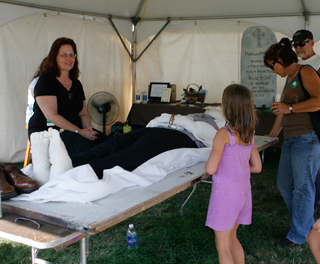
We aren’t comfortable sitting with death. We don’t want to face death. We want to get on with life.
Good Friday, however, is an invitation to sit with death. Instead of running away from grief, we can turn and face it. No specific tasks are required. We don’t have hard and fast rules. Easter is coming – but now is a time to wait.
![good-friday [640x480]](good-friday-005b640x480005d.jpg)
So I will not rush spring fever today. I will resist the urge to get started on the garden. I will back off from working in the yard. I will listen to the wind blowing and watch the moonrise this evening. It is a full moon tonight. And I will sit with the reality of death. I will think of those I have loved who have died. I will allow myself to miss them and feel the pain of grief. I will not pretend that death is not real, or that it has no effect upon me. I will feel its reality and face the simple fact that I, too, will someday die from this life.
Throughout holy week we do not pronounce benedictions. We view the entire week from the first strains of the Palm Sunday procession to the final hallelujahs of the Easter responses to be a continuing and unending worship service. So there is no benediction for this day – just a day to sit with death and experience its reality.
Copyright © 2012 by Ted Huffman. I wrote this. If you want to copy it, please ask for permission. There is a contact me button at the bottom of this page. If you want to share my blog a friend, please direct your friend to my web site.
When Society Breaks Down
05/04/12 04:59
We have grown used to stories about society breaking down in distant places. We know stories of injustices perpetrated in Northern Ireland, in the Middle East and in Sub-Saharan Africa. We have seen videos of chaos that can occur in distant locations. In a sense we are no longer shocked when we hear reports of brutality and the claiming of innocent victims.
But there has been some sense that those are stories of events that occur to other people in other places. We have felt ourselves immune to such things. We take comfort in our constitution and system of laws that protect us. We feel that we have recourse to justice through a court system.
All of that changed in August, 2005, when Hurricane Katrina battered the gulf coast and society totally broke down in New Orleans. Local, state, and federal governments were unprepared and unable to deal with the situation and the rest of us looked on with horror as people suffered not only from the devastation of the storm, but from the dysfunction of the government that should have been there to help them.
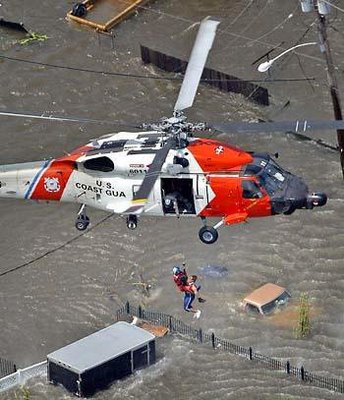 There were a lot of dynamics that contributed to a complex series of tragedies. One factor was the fear that gripped our entire nation following the terrorist attacks of September 11, 2001. The federal government had engaged in a complete re-thinking of security measures and the new Homeland Security system was being put into place, including a lot of federal funding going to local law enforcement agencies without a clear sense of the role of local agencies in providing security. The concept of a war on terror was diffuse. Instead of the enemy being a nation, it was a particular tactic. In a sense everyone was suspect. Those with names or physical appearance that connected them with the Middle East were even more suspect. Muslim Americans found their nationality and religion suspect. Fear can be dangerous and there was plenty of fear in our country.
There were a lot of dynamics that contributed to a complex series of tragedies. One factor was the fear that gripped our entire nation following the terrorist attacks of September 11, 2001. The federal government had engaged in a complete re-thinking of security measures and the new Homeland Security system was being put into place, including a lot of federal funding going to local law enforcement agencies without a clear sense of the role of local agencies in providing security. The concept of a war on terror was diffuse. Instead of the enemy being a nation, it was a particular tactic. In a sense everyone was suspect. Those with names or physical appearance that connected them with the Middle East were even more suspect. Muslim Americans found their nationality and religion suspect. Fear can be dangerous and there was plenty of fear in our country.
When you expect the threat to be a small cell of people bent on maximum destruction, you don’t pay enough attention to the stability of sea walls and levees. When you are looking for explosives smuggled into crowded places, you might not pay attention to the weather reports.
Whatever the dynamics, after the storm raged through the Gulf States, people found themselves to be abandoned by their own government. To make matters worse, government officials went way beyond abandonment, they actively engaged in victimizing hurricane survivors. We don’t know all of the stories, but what we have heard is horrifying.
 Patricia Thompson was trapped in the city with her family. Authorities with guns drawn prevented her from crossing the Crescent City Bridge to reach her sister. Later, soldiers trained their guns on her six-year-old granddaughter’s forehead, threatening to kill her if she moved.
Patricia Thompson was trapped in the city with her family. Authorities with guns drawn prevented her from crossing the Crescent City Bridge to reach her sister. Later, soldiers trained their guns on her six-year-old granddaughter’s forehead, threatening to kill her if she moved.
Dan Bright was arrested on false charges and held in Orleans Parish Prison. As the storm came, guards abandoned the building, leaving Bright and his fellow inmates to break out of their cells in order to save their lives.
Father Vien The Nguyen stayed behind to fend for parishioners who could not evacuate. As the days wore on and their supplies dwindled, help was nowhere to be found.
Rhonda Sylvester floated her grandchildren in buckets through miles of filthy floodwater, searching for rescuers. Buses meant to take them to safety eventually moved them to a highway where they languished for days without any supplies.
Abdulrahman Zeitoun, a Syrian-American, traveled the flooded city in his canoe, helping those in need. A week after the storm he was arrested under suspicion of terrorism and detained for weeks without charges or any family contact.
There are a lot more stories like those. 17-year-old James Brissette and 40-year-old Ronald Madison, who were both unarmed, were killed and four others were wounded on September 4, less than a week after the storm passed New Orleans. They were gunned down by police officers. To cover up the killings, police planted a gun, fabricated witnesses and falsified reports. Yesterday U.S. District Judge Kurt Englehardt handed down sentences to four former police officers.
What is more striking than the sentences is the frustration that the judge expressed in the judge’s two-hour speech criticizing the case put together by the prosecutors. He said he was “astonished and deeply troubled” by the plea deals with cooperating witnesses at the heart of the government’s case.
 Police officers testified that in the lawlessness that followed the storm, they feared for their lives. That may be true. There was looting that followed the storm – some of it was a desperate attempt to obtain food and other survival supplies. But police storming out of a budget rental truck commandeered for their own use weren’t following the law, either. Storming a group of unarmed civilians seeking shelter on the Danziger Bridge in the city’s Gentilly area is hardly responding to a threat. Running down and shooting in the back a mentally disabled man and then stomping and kicking his body is not explained by the fear the officers felt. Tampering with evidence, planting false evidence, and weaving a web of lies to cover up the shootings should not be standard procedure for trained officers.
Police officers testified that in the lawlessness that followed the storm, they feared for their lives. That may be true. There was looting that followed the storm – some of it was a desperate attempt to obtain food and other survival supplies. But police storming out of a budget rental truck commandeered for their own use weren’t following the law, either. Storming a group of unarmed civilians seeking shelter on the Danziger Bridge in the city’s Gentilly area is hardly responding to a threat. Running down and shooting in the back a mentally disabled man and then stomping and kicking his body is not explained by the fear the officers felt. Tampering with evidence, planting false evidence, and weaving a web of lies to cover up the shootings should not be standard procedure for trained officers.
There is a difference between fear and paranoia. Paranoia is fear when no threat exists. It is a mental illness. Victims of paranoia shouldn’t be uniformed and armed. The failure of the system to properly train the officers is clear. Their failure of courage is hard to take. We expect more from law enforcement officers.
The case is far from over. There will be appeals. Those convicted will rightly claim that they weren’t the only ones involved and that others got off without punishment. The arguments will continue for years to come.
Also continuing will be the memory of what happened and the knowledge of how fragile our society and our system of laws really is. When disaster strikes, civility breaks down quickly.
It will be the job of our generation to carefully collect the stories and sift them for the truth of what happened. We must preserve these stories and pass them on to future generations. What happened in New Orleans should never happen again. Burying evidence and passing on the blame will not assist in efforts to prevent such incidents. What is needed is for the truth to be told.
But there has been some sense that those are stories of events that occur to other people in other places. We have felt ourselves immune to such things. We take comfort in our constitution and system of laws that protect us. We feel that we have recourse to justice through a court system.
All of that changed in August, 2005, when Hurricane Katrina battered the gulf coast and society totally broke down in New Orleans. Local, state, and federal governments were unprepared and unable to deal with the situation and the rest of us looked on with horror as people suffered not only from the devastation of the storm, but from the dysfunction of the government that should have been there to help them.

When you expect the threat to be a small cell of people bent on maximum destruction, you don’t pay enough attention to the stability of sea walls and levees. When you are looking for explosives smuggled into crowded places, you might not pay attention to the weather reports.
Whatever the dynamics, after the storm raged through the Gulf States, people found themselves to be abandoned by their own government. To make matters worse, government officials went way beyond abandonment, they actively engaged in victimizing hurricane survivors. We don’t know all of the stories, but what we have heard is horrifying.

Dan Bright was arrested on false charges and held in Orleans Parish Prison. As the storm came, guards abandoned the building, leaving Bright and his fellow inmates to break out of their cells in order to save their lives.
Father Vien The Nguyen stayed behind to fend for parishioners who could not evacuate. As the days wore on and their supplies dwindled, help was nowhere to be found.
Rhonda Sylvester floated her grandchildren in buckets through miles of filthy floodwater, searching for rescuers. Buses meant to take them to safety eventually moved them to a highway where they languished for days without any supplies.
Abdulrahman Zeitoun, a Syrian-American, traveled the flooded city in his canoe, helping those in need. A week after the storm he was arrested under suspicion of terrorism and detained for weeks without charges or any family contact.
There are a lot more stories like those. 17-year-old James Brissette and 40-year-old Ronald Madison, who were both unarmed, were killed and four others were wounded on September 4, less than a week after the storm passed New Orleans. They were gunned down by police officers. To cover up the killings, police planted a gun, fabricated witnesses and falsified reports. Yesterday U.S. District Judge Kurt Englehardt handed down sentences to four former police officers.
What is more striking than the sentences is the frustration that the judge expressed in the judge’s two-hour speech criticizing the case put together by the prosecutors. He said he was “astonished and deeply troubled” by the plea deals with cooperating witnesses at the heart of the government’s case.

There is a difference between fear and paranoia. Paranoia is fear when no threat exists. It is a mental illness. Victims of paranoia shouldn’t be uniformed and armed. The failure of the system to properly train the officers is clear. Their failure of courage is hard to take. We expect more from law enforcement officers.
The case is far from over. There will be appeals. Those convicted will rightly claim that they weren’t the only ones involved and that others got off without punishment. The arguments will continue for years to come.
Also continuing will be the memory of what happened and the knowledge of how fragile our society and our system of laws really is. When disaster strikes, civility breaks down quickly.
It will be the job of our generation to carefully collect the stories and sift them for the truth of what happened. We must preserve these stories and pass them on to future generations. What happened in New Orleans should never happen again. Burying evidence and passing on the blame will not assist in efforts to prevent such incidents. What is needed is for the truth to be told.
Copyright © 2012 by Ted Huffman. I wrote this. If you want to copy it, please ask for permission. There is a contact me button at the bottom of this page. If you want to share my blog a friend, please direct your friend to my web site.
Not the Jetsons Yet
04/04/12 05:37
I grew up in an aviation family. Both my parents were licensed pilots and my father was a high-time commercial pilot with an instrument rating. He flew charters, fire patrols, animal counts, sprayed agricultural chemicals, ran an air ambulance and did whatever else was required to earn a living in the business. He was also a licensed airframe and engine mechanic and ran the fixed base operation at our local airport. I learned to fly as a teenager and had my license as soon as I was old enough. As a child and teen, I assumed that I would always have an airplane and would be able to fly whenever and wherever I wanted.
 That is not to say that I wasn’t aware of the challenges of aviation. My father was a very hard worker, with lots of creative ideas and he worked and worked to maintain a twin-engine airplane capable of coast to coast flying. We had it for quite a few years, but it never quite broke even. The maintenance and improvements that he made ended up costing more than the airplane would produce. There weren’t quite enough customers for this capable airplane. When it was sold, he finally made a profit, but up to that point, it required infusions of cash to keep it flying. Along the way we had some marvelous trips, traveling to Washington, D.C., Chicago, Salt Lake City, San Francisco and Seattle as a family in our twin Beech.
That is not to say that I wasn’t aware of the challenges of aviation. My father was a very hard worker, with lots of creative ideas and he worked and worked to maintain a twin-engine airplane capable of coast to coast flying. We had it for quite a few years, but it never quite broke even. The maintenance and improvements that he made ended up costing more than the airplane would produce. There weren’t quite enough customers for this capable airplane. When it was sold, he finally made a profit, but up to that point, it required infusions of cash to keep it flying. Along the way we had some marvelous trips, traveling to Washington, D.C., Chicago, Salt Lake City, San Francisco and Seattle as a family in our twin Beech.
I grew up watching the space program. In fact I soloed in an airplane the same year that Neil Armstrong first stepped onto the moon. I expected that there would be rapid technological changes in personal transportation. I imagined that personal aircraft that could be flown from home would become normal and usual by the time I was an adult. I knew that space travel was prohibitively expensive, but I thought that it would continue nonetheless, landing people on Mars and other planets in an ever-growing program. Along the way it would produce scientific and technological advances that would mean new and better products for us on earth.
 That was before I realized that unlimited growth is unsustainable. Things haven’t quite worked out the way I imagined. I just checked my garage. Parked in there is a 14-year old car. There is also a rowboat project that is months away from completion. No airplanes. The Jetsons was a futuristic cartoon on the TV in the early sixties. The future didn’t turn out that way.
That was before I realized that unlimited growth is unsustainable. Things haven’t quite worked out the way I imagined. I just checked my garage. Parked in there is a 14-year old car. There is also a rowboat project that is months away from completion. No airplanes. The Jetsons was a futuristic cartoon on the TV in the early sixties. The future didn’t turn out that way.
 There is a flying car. Perhaps it is more of a roadable airplane. Deliveries are expected yet this year of the first Terrafugia, a sport plane with folding wings that can be driven on regular roads and parked in a regular garage. It is incredibly attractive to someone who thinks like me. There are a couple of drawbacks. It is just a sport airplane, which means that it has limited capacity to carry weight. It carries only two people and not much luggage. About 450 pounds (including the people) is all it will take. And there is a long waiting period. About 100 customers have put their money down. There is still no firm date for the delivery of those vehicles. Oh, there is also the little detail of the cost. To park one of those in my garage, I’d have to come up with a little more than $100,000 more than the value of my entire home. I don’t think I could afford the airplane. If I did figure out how to buy one, I certainly couldn’t afford a garage to park it in. That one may not work out for me.
There is a flying car. Perhaps it is more of a roadable airplane. Deliveries are expected yet this year of the first Terrafugia, a sport plane with folding wings that can be driven on regular roads and parked in a regular garage. It is incredibly attractive to someone who thinks like me. There are a couple of drawbacks. It is just a sport airplane, which means that it has limited capacity to carry weight. It carries only two people and not much luggage. About 450 pounds (including the people) is all it will take. And there is a long waiting period. About 100 customers have put their money down. There is still no firm date for the delivery of those vehicles. Oh, there is also the little detail of the cost. To park one of those in my garage, I’d have to come up with a little more than $100,000 more than the value of my entire home. I don’t think I could afford the airplane. If I did figure out how to buy one, I certainly couldn’t afford a garage to park it in. That one may not work out for me.
Still I read the aviation news. So it caught my eye yesterday when Helen Collins landed the family airplane at Cherryland Airport in Wisconsin. There have been a few incidents like this in the past. Her husband expressed distress and slumped over at the controls. She took over flying the airplane, issued a distress call on the radio and was “talked down” by another pilot. Herself not a pilot, she safely got the airplane to the ground. Unfortunately her husband did die. He died doing something he loved: flying. He was 81 years old, and although his death came all too soon for the family, he had lived a full and interesting life. Helen, herself 80, had taken “pinch hitter” flying lessons 30 years ago and was familiar with the basic controls of the airplane. Still, it was a remarkable feat that she accomplished.
 What caught my eye in the news stories is that writers kept referring to the Collins’ plane as a “small” airplane. It might have been small by airline standards, but in my world a half-million dollar pressurized twin-engine plane with seating for eight is hardly “small.”
What caught my eye in the news stories is that writers kept referring to the Collins’ plane as a “small” airplane. It might have been small by airline standards, but in my world a half-million dollar pressurized twin-engine plane with seating for eight is hardly “small.”
Personal aviation exists in the United States today. It just doesn’t exist in my price range. But I don’t think I want to complain about that. My teenage perception that we could continue to have more and more in each succeeding generation isn’t really the way I want the world to be. My grandfather was excited to purchase his first car – his father was delighted with a good team of horses. There were plenty of generations of my family who lived without the luxuries I take for granted. This computer I use to write my blogs would have astounded my father. Our home with individual heat controls for each room would have amazed my grandfather. We have been the beneficiaries of lots of technological advances. After all we have WD-40 and Velcro – both products developed for the space program. I may not have a flying car, but I have a sophisticated, satellite-based navigation system that will direct me to any address in town. It isn’t perfect, but it is amazing.
I’m comfortable with limits. I don’t need to be able to afford everything that can be made or offered for sale. If I am not exactly comfortable, I’m quite able to travel on public airlines when I need to cover large distances. There are good, safe, ways for me to travel where I need to go.
Still, it would be cool to have an airplane in my garage. Before I get one of those, however, I’ve got to finish that rowboat.

I grew up watching the space program. In fact I soloed in an airplane the same year that Neil Armstrong first stepped onto the moon. I expected that there would be rapid technological changes in personal transportation. I imagined that personal aircraft that could be flown from home would become normal and usual by the time I was an adult. I knew that space travel was prohibitively expensive, but I thought that it would continue nonetheless, landing people on Mars and other planets in an ever-growing program. Along the way it would produce scientific and technological advances that would mean new and better products for us on earth.


Still I read the aviation news. So it caught my eye yesterday when Helen Collins landed the family airplane at Cherryland Airport in Wisconsin. There have been a few incidents like this in the past. Her husband expressed distress and slumped over at the controls. She took over flying the airplane, issued a distress call on the radio and was “talked down” by another pilot. Herself not a pilot, she safely got the airplane to the ground. Unfortunately her husband did die. He died doing something he loved: flying. He was 81 years old, and although his death came all too soon for the family, he had lived a full and interesting life. Helen, herself 80, had taken “pinch hitter” flying lessons 30 years ago and was familiar with the basic controls of the airplane. Still, it was a remarkable feat that she accomplished.

Personal aviation exists in the United States today. It just doesn’t exist in my price range. But I don’t think I want to complain about that. My teenage perception that we could continue to have more and more in each succeeding generation isn’t really the way I want the world to be. My grandfather was excited to purchase his first car – his father was delighted with a good team of horses. There were plenty of generations of my family who lived without the luxuries I take for granted. This computer I use to write my blogs would have astounded my father. Our home with individual heat controls for each room would have amazed my grandfather. We have been the beneficiaries of lots of technological advances. After all we have WD-40 and Velcro – both products developed for the space program. I may not have a flying car, but I have a sophisticated, satellite-based navigation system that will direct me to any address in town. It isn’t perfect, but it is amazing.
I’m comfortable with limits. I don’t need to be able to afford everything that can be made or offered for sale. If I am not exactly comfortable, I’m quite able to travel on public airlines when I need to cover large distances. There are good, safe, ways for me to travel where I need to go.
Still, it would be cool to have an airplane in my garage. Before I get one of those, however, I’ve got to finish that rowboat.
Copyright © 2012 by Ted Huffman. I wrote this. If you want to copy it, please ask for permission. There is a contact me button at the bottom of this page. If you want to share my blog a friend, please direct your friend to my web site.
Artists
03/04/12 04:11
Artists enhance our lives in so many ways. I can’t imagine life without music, visual arts, poetry and literature. I have invested countless hours in promoting the arts in our community and have done more than a small amount of fund-raising to support the arts. I am regularly asked to emcee arts events and am a frequent audience member at performances. In addition, the church has a long history of being a patron of the arts. Many congregations take a decreased role in relationship to the arts in contemporary society. Recently, while waiting for a doctor’s appointment, it occurred to me that medical facilities are probably the new patrons of the arts in our society. There are medical buildings with virtual galleries in the lobby and unique original art works in virtually every room.
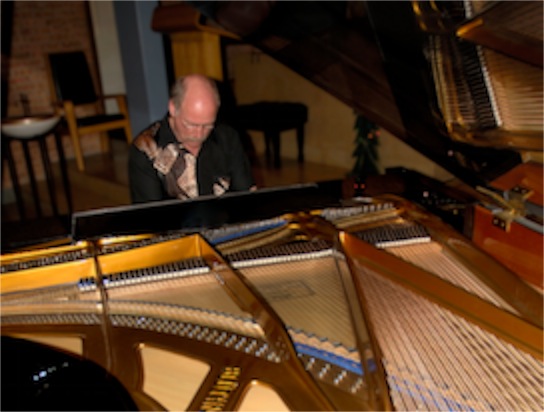 As a supporter of the arts, I have invested more than a small amount of labor in making arts events occur. I have hung paintings, moved pianos, set up furniture, adjusted sound systems, loaded trucks and trailers, and done a lot of other bits of physical labor in order to make arts events succeed.
As a supporter of the arts, I have invested more than a small amount of labor in making arts events occur. I have hung paintings, moved pianos, set up furniture, adjusted sound systems, loaded trucks and trailers, and done a lot of other bits of physical labor in order to make arts events succeed.
Over the years I have made some observations about the arts and artists. They are little gems of wisdom that I think should be somehow passed on to the next generation. At one point I thought that it might be good for me to make a list for the next pastor to serve in my position, but upon reflection, that doesn’t seem like too good of an idea. Why should I deprive another pastor of the joy of on-the-job learning that has been so valuable to my career?
So here are some of my observations about the arts and artists:
 There are only two types of organists: Ones who cannot play the instrument well and never will learn to do so and ones who have very quirky personalities. Think about it for a minute. You have to be able to read a minimum of four lines of music while engaging in coordinated physical activities with both feet and both hands. It takes intense concentration to play the instrument. It takes physical stamina. Those who are good at it don’t have time to think about details such as the pastor’s sense of theology or the feelings of the choir members. It only takes a few minutes, however, to realize that life with an organist with a quirky personality is far preferable than life with an organist who cannot play the instrument. I’ll put up with the quirky personality every time. If you ever find yourself in the presence of an organist with an even temper, an easy-going manner and an ever-present smile that is a genuine master of the instrument, check your pulse. Have you seen any bright lights recently? Did a booming voice announce, “Well done, good and faithful servant?” Did you recently pass through pearly gates where someone was handing out harps?
There are only two types of organists: Ones who cannot play the instrument well and never will learn to do so and ones who have very quirky personalities. Think about it for a minute. You have to be able to read a minimum of four lines of music while engaging in coordinated physical activities with both feet and both hands. It takes intense concentration to play the instrument. It takes physical stamina. Those who are good at it don’t have time to think about details such as the pastor’s sense of theology or the feelings of the choir members. It only takes a few minutes, however, to realize that life with an organist with a quirky personality is far preferable than life with an organist who cannot play the instrument. I’ll put up with the quirky personality every time. If you ever find yourself in the presence of an organist with an even temper, an easy-going manner and an ever-present smile that is a genuine master of the instrument, check your pulse. Have you seen any bright lights recently? Did a booming voice announce, “Well done, good and faithful servant?” Did you recently pass through pearly gates where someone was handing out harps?
All musicians are afraid of the dark. Regardless of the time of the day, they will turn on as many lights as they can find. Regardless of the time of night, they will never turn off a light. After a musician has turned off all the lights, checked the building and locked all the doors you can expect to find lights on in the choir room, the bathroom, the hallways, and closets. And, for good measure you probably should check to make sure that the doors are locked as well.
Artists, including painters, sculptors, musicians and poets are all capable of moving furniture. In fact many of them like to rearrange furniture to set up a room for their use even if it is a temporary use. While they are quite adept at moving furniture to set up things for their own use, they have no abilities to return things to the way they were when they arrived in the building. If you can’t afford to hire a janitor, simply plan on coming in after the watercolor society or the musical rehearsal or competition to put the furniture back. Those who carried the tables up into the balcony have no ability to bring them back down and put them away.
Piano players agree that piano covers are a good idea. They all advocate quality cloth clovers for fine pianos. They all are able to recommend a source for an expensive cover. They are all able to remove the cover from the piano. No piano player has a clue about how to get the cover back on the piano. They will never do it. You might as well get used to putting the cover on the piano after it is played.
All artists believe that the value of art cannot be measured in dollars and cents. That means that the prices of their work bear no relationship to the costs of production. There are plenty of artists who are happy to sell paintings for less than the cost of the materials. There are lots of musicians who advocate that ticket prices be kept below the cost of staging the production. In general artists are not greedy people. They don’t expect to get rich and rarely pay attention to whether or not they are paid. When you do pay them, expect the check to get lost three or four times before it gets deposited in the bank six to nine months after you give it to them.
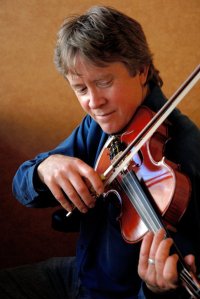 Having made the statement above, all artists believe that fund raising is easy. They believe that the best way to raise money is to stage an event that features their art. They like galas and dinners (many are underfed) and fancy dress-up affairs. They always count gross income before deducting expenses. A committee of artists is completely capable of staging a series of events with a net loss and believing that they raised a lot of money. Those who really love the arts and want them to flourish in the community understand the need for accountants in this world.
Having made the statement above, all artists believe that fund raising is easy. They believe that the best way to raise money is to stage an event that features their art. They like galas and dinners (many are underfed) and fancy dress-up affairs. They always count gross income before deducting expenses. A committee of artists is completely capable of staging a series of events with a net loss and believing that they raised a lot of money. Those who really love the arts and want them to flourish in the community understand the need for accountants in this world.
There are many more observations that I could make, but I’ll save a few of them for future blogs. In the meantime, I am deeply grateful to live in a world filled with art and I enjoy hanging around with the artists who produce the music, paintings, sculpture, poetry and prose that enrich our lives. And yes, I’ll attend another fund-raising event. And yes, I’ll bring my checkbook. You gotta love ‘em!

Over the years I have made some observations about the arts and artists. They are little gems of wisdom that I think should be somehow passed on to the next generation. At one point I thought that it might be good for me to make a list for the next pastor to serve in my position, but upon reflection, that doesn’t seem like too good of an idea. Why should I deprive another pastor of the joy of on-the-job learning that has been so valuable to my career?
So here are some of my observations about the arts and artists:

All musicians are afraid of the dark. Regardless of the time of the day, they will turn on as many lights as they can find. Regardless of the time of night, they will never turn off a light. After a musician has turned off all the lights, checked the building and locked all the doors you can expect to find lights on in the choir room, the bathroom, the hallways, and closets. And, for good measure you probably should check to make sure that the doors are locked as well.
Artists, including painters, sculptors, musicians and poets are all capable of moving furniture. In fact many of them like to rearrange furniture to set up a room for their use even if it is a temporary use. While they are quite adept at moving furniture to set up things for their own use, they have no abilities to return things to the way they were when they arrived in the building. If you can’t afford to hire a janitor, simply plan on coming in after the watercolor society or the musical rehearsal or competition to put the furniture back. Those who carried the tables up into the balcony have no ability to bring them back down and put them away.
Piano players agree that piano covers are a good idea. They all advocate quality cloth clovers for fine pianos. They all are able to recommend a source for an expensive cover. They are all able to remove the cover from the piano. No piano player has a clue about how to get the cover back on the piano. They will never do it. You might as well get used to putting the cover on the piano after it is played.
All artists believe that the value of art cannot be measured in dollars and cents. That means that the prices of their work bear no relationship to the costs of production. There are plenty of artists who are happy to sell paintings for less than the cost of the materials. There are lots of musicians who advocate that ticket prices be kept below the cost of staging the production. In general artists are not greedy people. They don’t expect to get rich and rarely pay attention to whether or not they are paid. When you do pay them, expect the check to get lost three or four times before it gets deposited in the bank six to nine months after you give it to them.

There are many more observations that I could make, but I’ll save a few of them for future blogs. In the meantime, I am deeply grateful to live in a world filled with art and I enjoy hanging around with the artists who produce the music, paintings, sculpture, poetry and prose that enrich our lives. And yes, I’ll attend another fund-raising event. And yes, I’ll bring my checkbook. You gotta love ‘em!
Copyright © 2012 by Ted Huffman. I wrote this. If you want to copy it, please ask for permission. There is a contact me button at the bottom of this page. If you want to share my blog a friend, please direct your friend to my web site.
New Cabs for New York
02/04/12 05:26
In 1969 my folks ordered a new Plymouth station wagon for factory delivery. The whole family flew to Detroit. After a few adventures in Detroit, we headed into Canada and came back into the US at Niagara Falls. From there we went to New York City, Washington, D.C. and back across the United States to Montana, including a stop at the Indianapolis Speedway and Chanute Air Force Base in Illinois. It was a grand vacation. I had a relatively new driver’s license and I shared in some of the driving, mostly in open, non-urban areas.
 One of the memories I have of that trip is of coming into downtown Manhattan in the afternoon. We were navigating with a map, but had little sense of where the traffic might be bad. We had a brand-new car with Montana license plates. It was a station wagon filled with kids and luggage and all sorts of things. And we drove into a sea of taxicabs. It sounds like a nightmare, but it wasn’t. The cab drivers knew that we didn’t fit in. They drove rudely and aggressively with one another, employing their horns regularly, changing lanes abruptly, crowding and cutting one another off. With us, however, they allowed extra space and treated us with suspicion as if we had no idea what we were doing, which was at least partially true. We went through Manhattan in this sea of yellow cabs with room to change lanes, and plenty of space all around our car. We didn’t even get close to getting a scratch on that new car.
One of the memories I have of that trip is of coming into downtown Manhattan in the afternoon. We were navigating with a map, but had little sense of where the traffic might be bad. We had a brand-new car with Montana license plates. It was a station wagon filled with kids and luggage and all sorts of things. And we drove into a sea of taxicabs. It sounds like a nightmare, but it wasn’t. The cab drivers knew that we didn’t fit in. They drove rudely and aggressively with one another, employing their horns regularly, changing lanes abruptly, crowding and cutting one another off. With us, however, they allowed extra space and treated us with suspicion as if we had no idea what we were doing, which was at least partially true. We went through Manhattan in this sea of yellow cabs with room to change lanes, and plenty of space all around our car. We didn’t even get close to getting a scratch on that new car.
 Back in those days, most of the New York cabs were Checkers. The boxy design was as iconic as the black Hackney carriages in London. At the time I was pretty aware of makes and models of cars. Auto designers were coming out with new shapes each year and there were features that made it easy to tell the differences. And I was a new driver, excited to learn about all of the different kinds of cars. Checker cabs, however, had no particular features to distinguish one year from another. They were designed for high mileage in heavy traffic situations and they were built to last for years of running through the potholes of New York City.
Back in those days, most of the New York cabs were Checkers. The boxy design was as iconic as the black Hackney carriages in London. At the time I was pretty aware of makes and models of cars. Auto designers were coming out with new shapes each year and there were features that made it easy to tell the differences. And I was a new driver, excited to learn about all of the different kinds of cars. Checker cabs, however, had no particular features to distinguish one year from another. They were designed for high mileage in heavy traffic situations and they were built to last for years of running through the potholes of New York City.
 It was several years before I got back to New York City. On my next visit, we took a cab from the airport to our hotel. The world had changed. Our cab was a Ford Crown Victoria with a vinyl interior. Who knows how many times that interior had been re-upholstered? There was a Plexiglas barrier between the front and rear seats and the driver was likely a recent immigrant to the US. At least it seemed that English wasn’t his first language. The trip from the hotel back to the airport is another story entirely, probably worth an entire blog. Suffice it to say that the driver told us he could beat the fares of any other driver. The meters were based on time elapsed, not mileage and this driver didn’t waste any time. We sped through streets and the tunnel at rates of speed that I wouldn’t have attempted. Fortunately we didn’t have to take time for a patrolman to write a ticket. And we did survive the ride. And the driver did get us there with a lower fare than we had paid getting to the hotel.
It was several years before I got back to New York City. On my next visit, we took a cab from the airport to our hotel. The world had changed. Our cab was a Ford Crown Victoria with a vinyl interior. Who knows how many times that interior had been re-upholstered? There was a Plexiglas barrier between the front and rear seats and the driver was likely a recent immigrant to the US. At least it seemed that English wasn’t his first language. The trip from the hotel back to the airport is another story entirely, probably worth an entire blog. Suffice it to say that the driver told us he could beat the fares of any other driver. The meters were based on time elapsed, not mileage and this driver didn’t waste any time. We sped through streets and the tunnel at rates of speed that I wouldn’t have attempted. Fortunately we didn’t have to take time for a patrolman to write a ticket. And we did survive the ride. And the driver did get us there with a lower fare than we had paid getting to the hotel.
New York is changing taxis once again. The winner of the competition to build the next generation of cabs for the city is Nissan, who secured a 10-year contract, worth an estimated $1 billion to be the sole manufacturer of New York taxis. There are about 13,000 of the vehicles. Starting next year, the Taxi and Limousine Commission will require licensed taxi operators in the city to purchase the Nissan NV 200. It is a min-van. There will be versions on display at the New York Auto Show next weekend.
It being New York, there have been disputes about nearly every element in the taxi design from the material used to make the divider between the driver and the passengers to the sound of the horn. Nissan hired a French design firm to assist with the choices of materials and colors for the cabs. Who would have though you needed a professional designer to choose the colors for a car that will be yellow on the outside and black on the inside? But this is New York City after all. Nissan isn’t accustomed to designing a particular vehicle for a single market, but a billion dollars worth of taxis is a significant amount. So the yellow is a bit brighter than the current fleet of taxis and there will be yellow stitching in the interior and yellow trim on the seat belt for a “unified” look. Antimicrobial material is being designed into the cabs to absorb odors. The floor mats are made from recycled tires.
 Of course Nissan believes that they are creating a new icon. They are hoping to replace the image of a New York taxi in the minds of all people. They may succeed. Times have changed. Those of us who remember watching Danny DeVito playing Louie De Palma on “Taxi,” are getting fewer and fewer with each passing year.
Of course Nissan believes that they are creating a new icon. They are hoping to replace the image of a New York taxi in the minds of all people. They may succeed. Times have changed. Those of us who remember watching Danny DeVito playing Louie De Palma on “Taxi,” are getting fewer and fewer with each passing year.
Nissan is planning to make the most of this week’s New York Auto Show. They will be announcing five new models in the next 15 months – new versions of the Altima, Pathfinder, Sentra, Versa and Rogue. Nissan North America plans to add $100 million to its ad budget to market those five new models. This is a company that spent $459.1 million on advertising in 2010. Nissan sales in the US accounted for 944,073 vehicles last year. If I’ve done my math correctly that means that $486 of the price of each car is the cost of advertising. I wish we had the option of paying $500 less and not having to watch the ads.
I don’t know when I’ll be in New York City next, but when I do make the trip I plan to pay attention to the floor mats and the interior partition in the cab. I may even see if I can get the driver to honk the horn to see just what sound the design team chose.
Silly me. I won’t have to ask in order to hear the horn.



New York is changing taxis once again. The winner of the competition to build the next generation of cabs for the city is Nissan, who secured a 10-year contract, worth an estimated $1 billion to be the sole manufacturer of New York taxis. There are about 13,000 of the vehicles. Starting next year, the Taxi and Limousine Commission will require licensed taxi operators in the city to purchase the Nissan NV 200. It is a min-van. There will be versions on display at the New York Auto Show next weekend.
It being New York, there have been disputes about nearly every element in the taxi design from the material used to make the divider between the driver and the passengers to the sound of the horn. Nissan hired a French design firm to assist with the choices of materials and colors for the cabs. Who would have though you needed a professional designer to choose the colors for a car that will be yellow on the outside and black on the inside? But this is New York City after all. Nissan isn’t accustomed to designing a particular vehicle for a single market, but a billion dollars worth of taxis is a significant amount. So the yellow is a bit brighter than the current fleet of taxis and there will be yellow stitching in the interior and yellow trim on the seat belt for a “unified” look. Antimicrobial material is being designed into the cabs to absorb odors. The floor mats are made from recycled tires.

Nissan is planning to make the most of this week’s New York Auto Show. They will be announcing five new models in the next 15 months – new versions of the Altima, Pathfinder, Sentra, Versa and Rogue. Nissan North America plans to add $100 million to its ad budget to market those five new models. This is a company that spent $459.1 million on advertising in 2010. Nissan sales in the US accounted for 944,073 vehicles last year. If I’ve done my math correctly that means that $486 of the price of each car is the cost of advertising. I wish we had the option of paying $500 less and not having to watch the ads.
I don’t know when I’ll be in New York City next, but when I do make the trip I plan to pay attention to the floor mats and the interior partition in the cab. I may even see if I can get the driver to honk the horn to see just what sound the design team chose.
Silly me. I won’t have to ask in order to hear the horn.
Copyright © 2012 by Ted Huffman. I wrote this. If you want to copy it, please ask for permission. There is a contact me button at the bottom of this page. If you want to share my blog a friend, please direct your friend to my web site.
Palm Sunday, 2012
01/04/12 05:24

Palm Sunday presents a dilemma for Christians. Perhaps this has always been so. There were, among Jesus’ earliest followers, people who wanted deep changes in the religious and governmental power structures of the time. They were people with very little influence in the temple and no significant voice in the government at Rome. The idea of a triumphal entry into Jerusalem accompanied by popular recognition that Jesus was the new leader, was inviting. It would give the disciples recognition and provide justification for all of the sacrifices they had made in order to follow him.
Jesus would occasional do or say something that supported a vision of political and religious revolution. His overturning the tables of the moneychangers, his reference to destroying the temple, and the entrance into Jerusalem itself was enough for some followers to start thinking about the possibilities of new leadership in the religious community and a new government to rule the community.
On the other hand, Jesus was not saying much about coming to power. In fact some of his conversations with the disciples hinted at his death. It wasn’t quite the conversation they wanted to have with the one they had hoped would be the leader of a revolution.
It wasn’t easy to understand that God’s chosen one, the messiah, would come not to take over the world, but rather to die.
Now, as then, we continue to live in a death-adverse society. We don’t want to talk about death. We don’t want to think about death. We see death as failure. We act as if it is the end. It is natural to do so. There is no small amount of pain and grief that comes when someone we love has died. The way we feel in such circumstances is not at all pleasant. And we seek to avoid those feelings. We suppress them and replace them with other thoughts.
It does not work to avoid death – at least not in the long run. We are finite. We are subject to death. We come with an expiration date. Furthermore, when we suppress feelings of grief over loss, they come back to haunt us. In order to deal with death, we must face it squarely. We must accept the pain and sorrow as realities in our lives.
Our culture, however, doesn’t want to face death. This was no less true of people in Jesus’ day. On the one hand, they were literally surrounded by death. Infant mortality was high. Mothers often died in childbirth. The life expectancy was short. And life was cheap under Roman rule. Capital punishment was common. The means of executing prisoners and enemies were gruesome and public displays of executions and the bodies of those executed were common. Still, death was seen as something to be avoided. People didn’t want to think about death. They didn’t want to talk about death.
It was shocking for a religious leader to not be focused on self-preservation. It was a scandal for a religious leader to be accused of religious crimes. It was a disgrace for a religious leader to be tried and convicted of insurrection by the Roman authorities. The cross has become an important symbol for contemporary Christians. It was not so in the early church. It was a symbol of Roman authority and had no positive connotations for those who had witnessed a crucifixion.
When we celebrate Palm Sunday, we have a natural preference for the story of Jesus’ triumphal entry. We like parades. We like celebrations. We like to think that we are in the majority and that others have become convinced that we are right. We enjoy the larger congregation that comes to church. Compare the size of the congregation with those who show up for Maundy Thursday or Good Friday, however. The majority of Christians do not participate in Holy Week services except for Palm Sunday and Easter. The high celebrations are what draw the crowds.
Acknowledging the pain of death is always a lonely endeavor. Grief always has a private component. Loneliness is part of the process.
So it is no surprise that many Christians have trouble understanding resurrection. If what you fear and avoid is death, what you want is resuscitation – a return of the physical body to its pre-death state. If what you fear and avoid is death, it is difficult to understand that death is not the end. We want simple answers and easy processes. There is no easy way to get to resurrection. It requires that we face death squarely and acknowledge the pain of loss.
Alleviating pain is a high value in our society. We go to great efforts to avoid pain for ourselves and to take pain away from others. Much of the modern practice of medicine is focused on pain management. There are physicians and nurses whose entire practices are devoted to decreasing pain. And there are healthy profits in being able to get rid of pain.
Outside of formal and accepted channels, no small amount of the illegal drug trade is based on the assumption that pain can be avoided and pleasure can be induced by ingesting, inhaling, or injecting chemicals.
We don’t like to feel pain. We don’t like to witness pain.
And there is nothing pretty or pleasant about the crucifixion of a human being. It is death and pain at its worst. The process was intentionally designed to cause maximum amount of pain on the belief that witnessing such pain would be a deterrent to others who might want to engage in behavior that the government wanted to suppress.
So we go through this day with mixed feelings. There is no small amount of desire to avoid the pain and grief that lie ahead. We don’t want to think that the salvation of the world involves pain and death. So we wave our palms and try not to think about the rest of the story.
Perhaps that is why we celebrate holy week every year. It is so difficult to understand. We need practice to begin to engage the spiritual discipline of facing death squarely. Perhaps it is important practice for what lies ahead for each of us, whether or not we choose to engage in the disciplines of the week.